The broken windows theory, proposed by James Q. Wilson and George Kelling in 1982, connects disorder in neighborhoods to increases in serious crime, suggesting that maintaining order can prevent further criminal activities. This theory significantly influenced policing strategies in the 1990s, particularly in New York City, where initiatives aimed at reducing low-level offenses reportedly contributed to declines in crime rates. However, the theory has faced criticism regarding its empirical validity and its implications for disadvantaged communities, with researchers suggesting a need for more nuanced models to understand the relationship between disorder and crime.


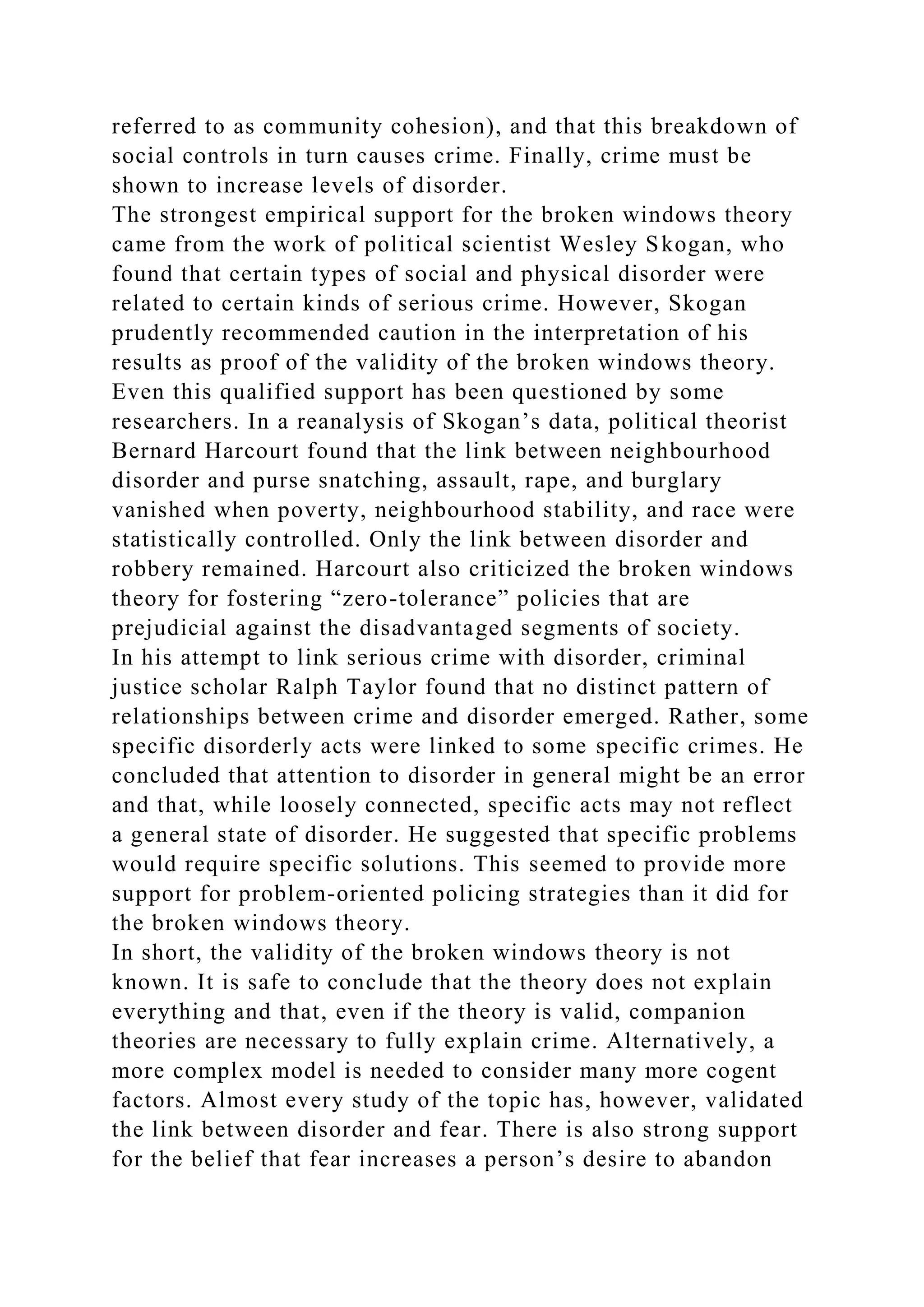
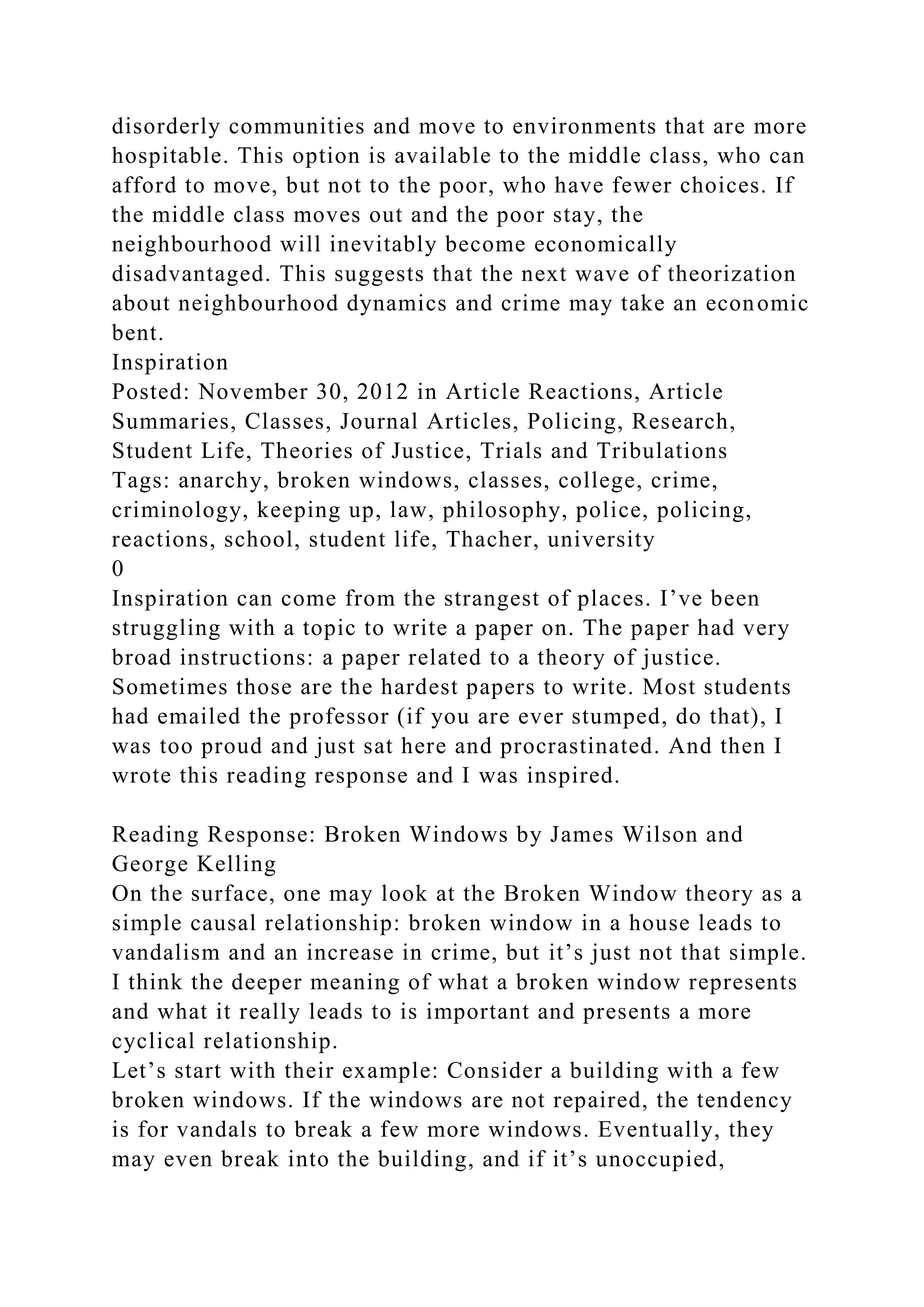
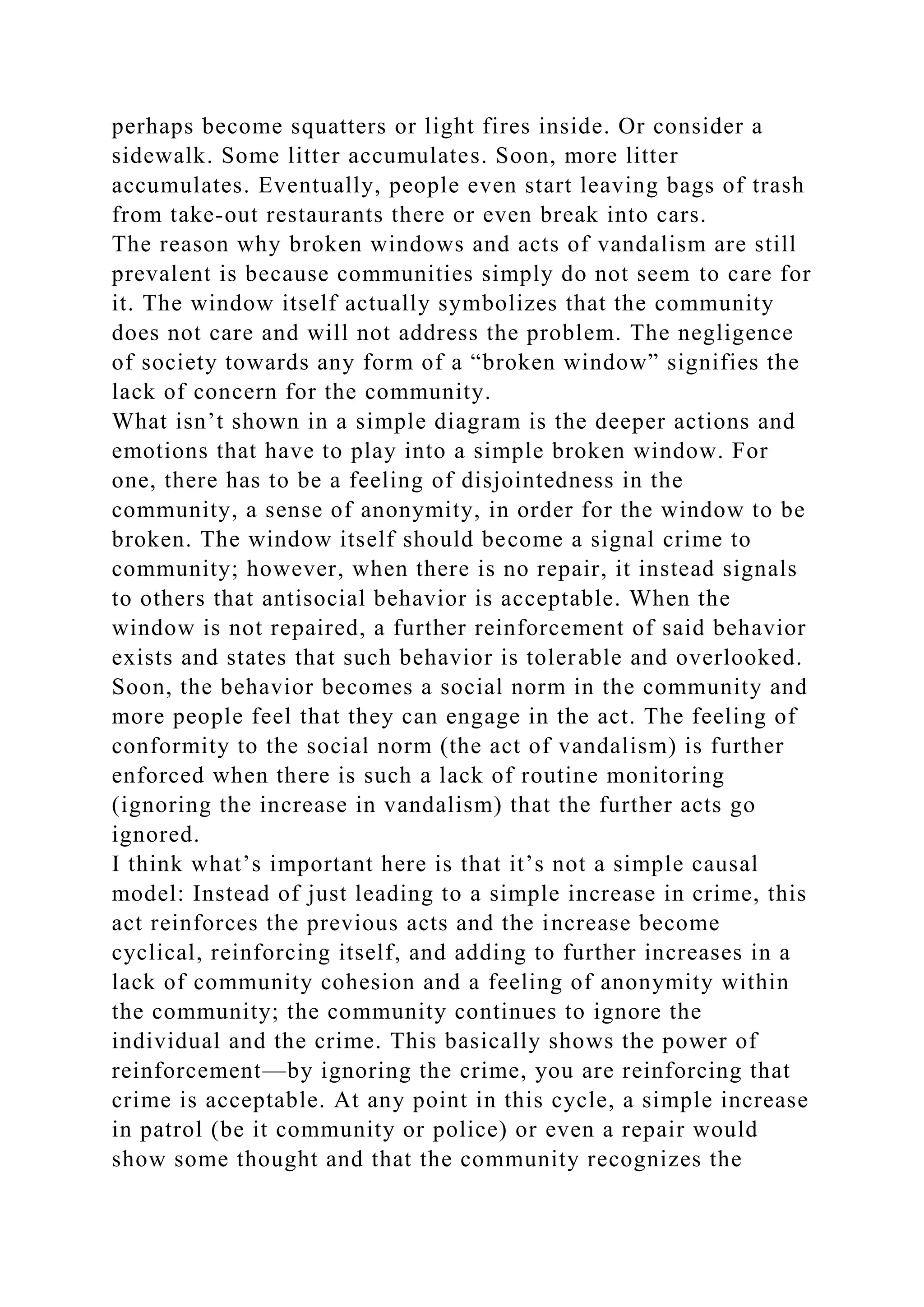
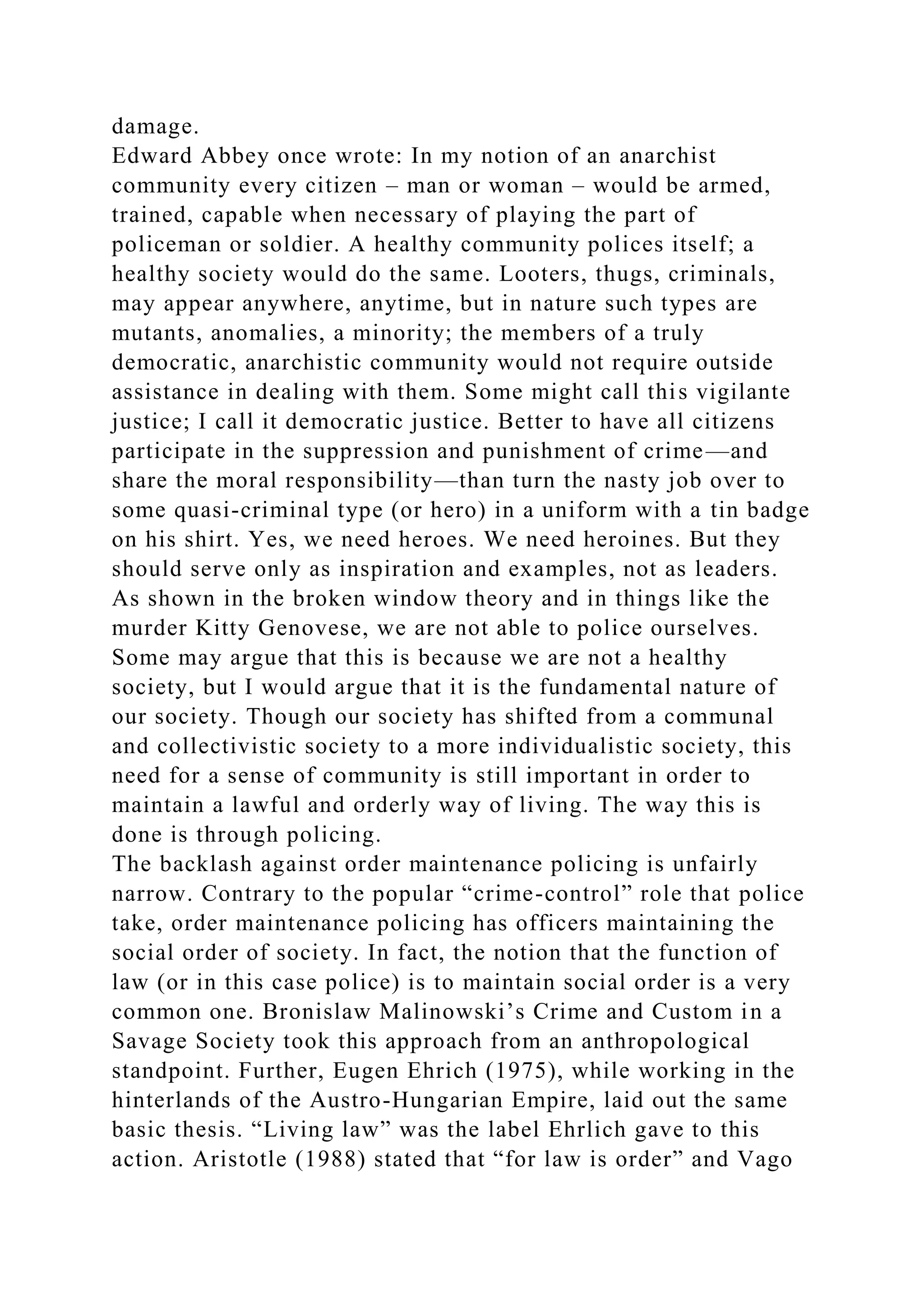
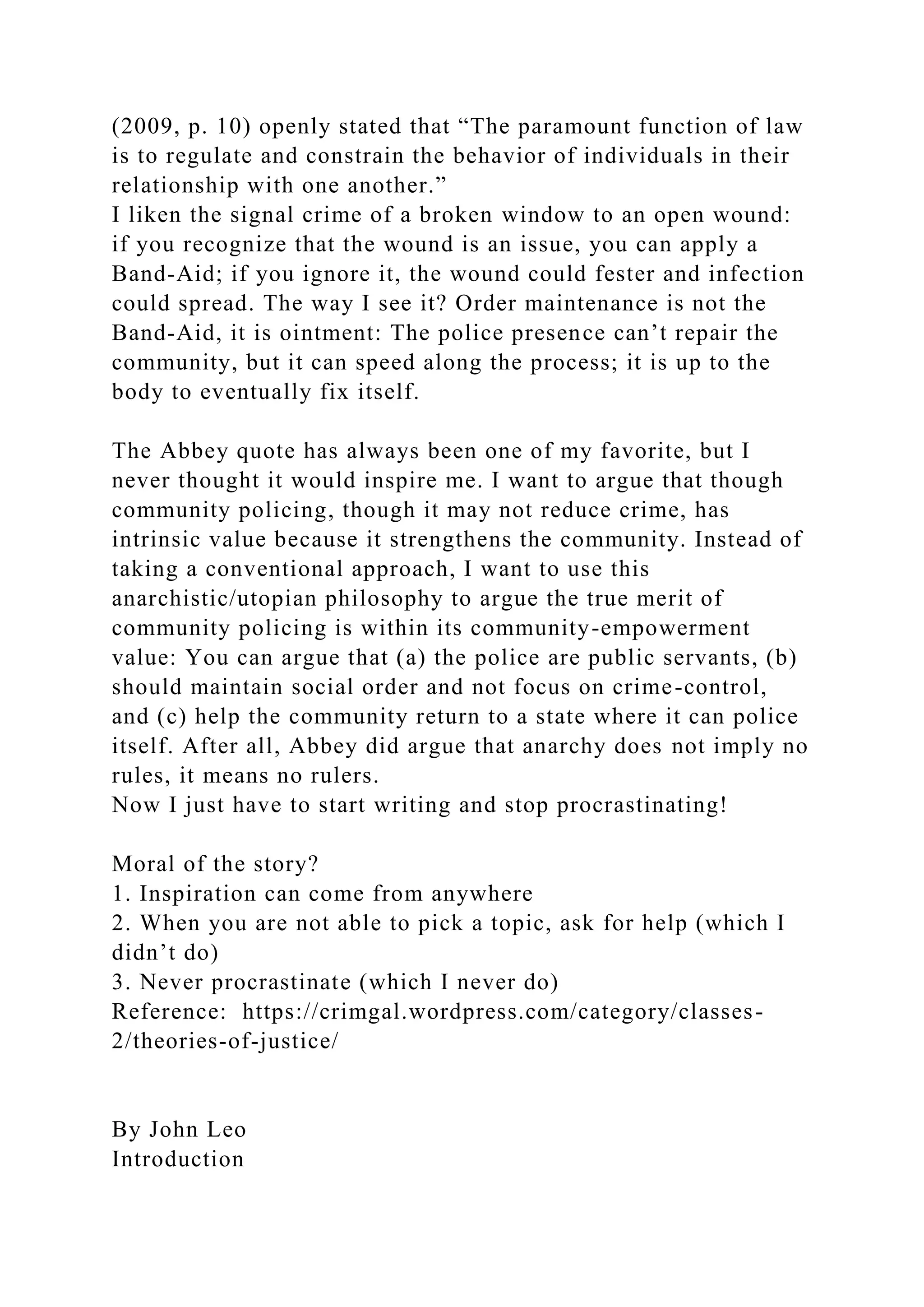

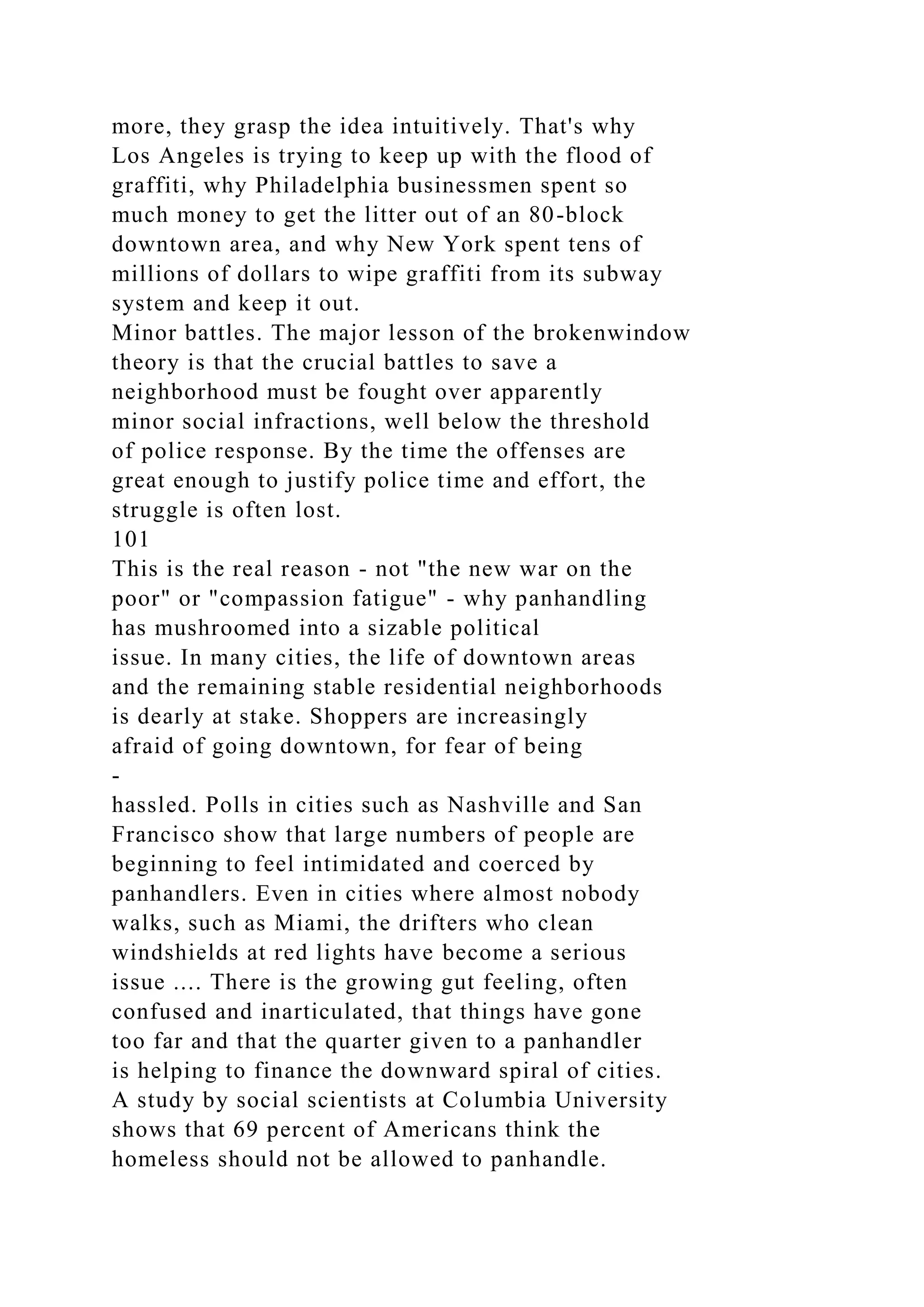
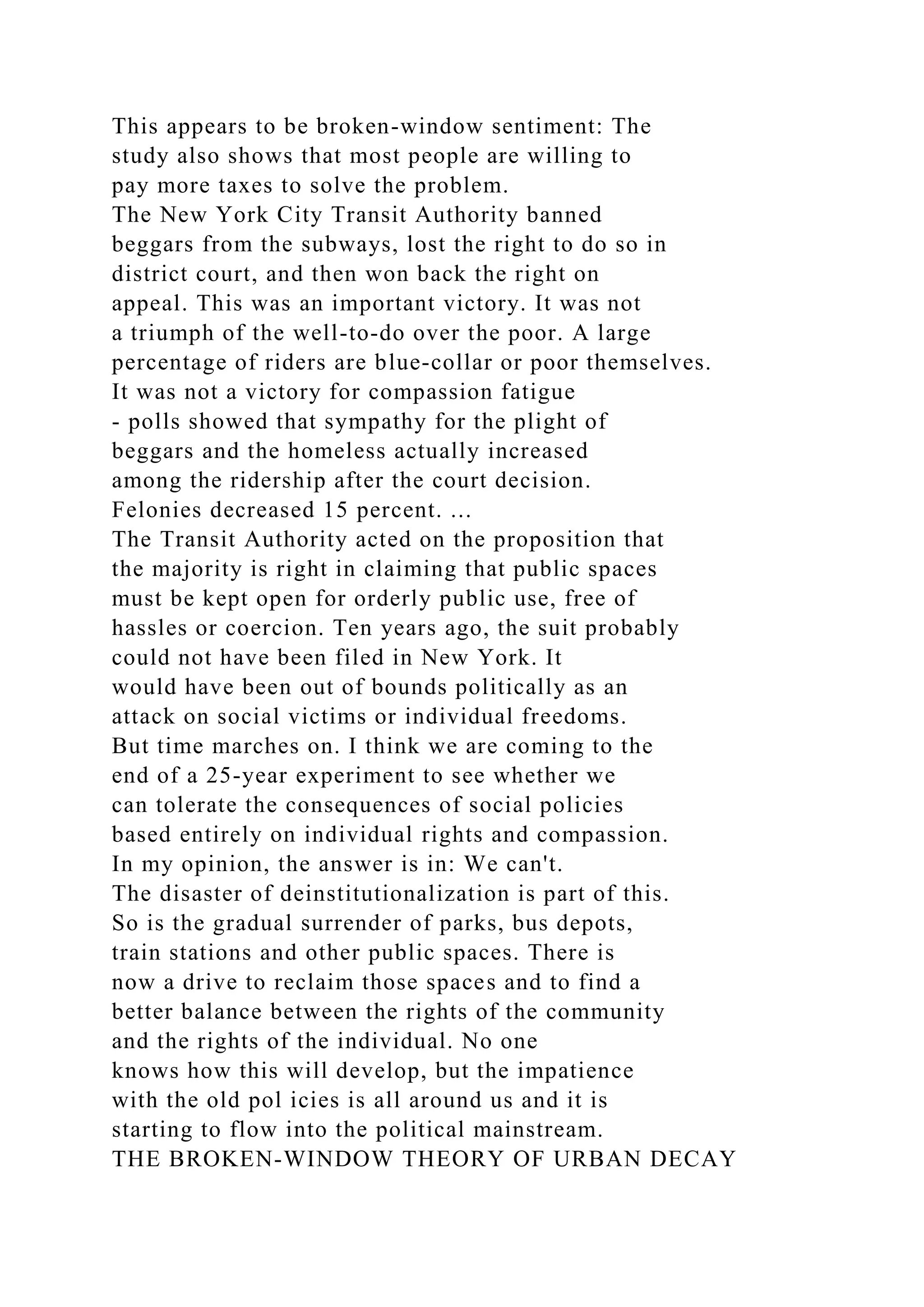
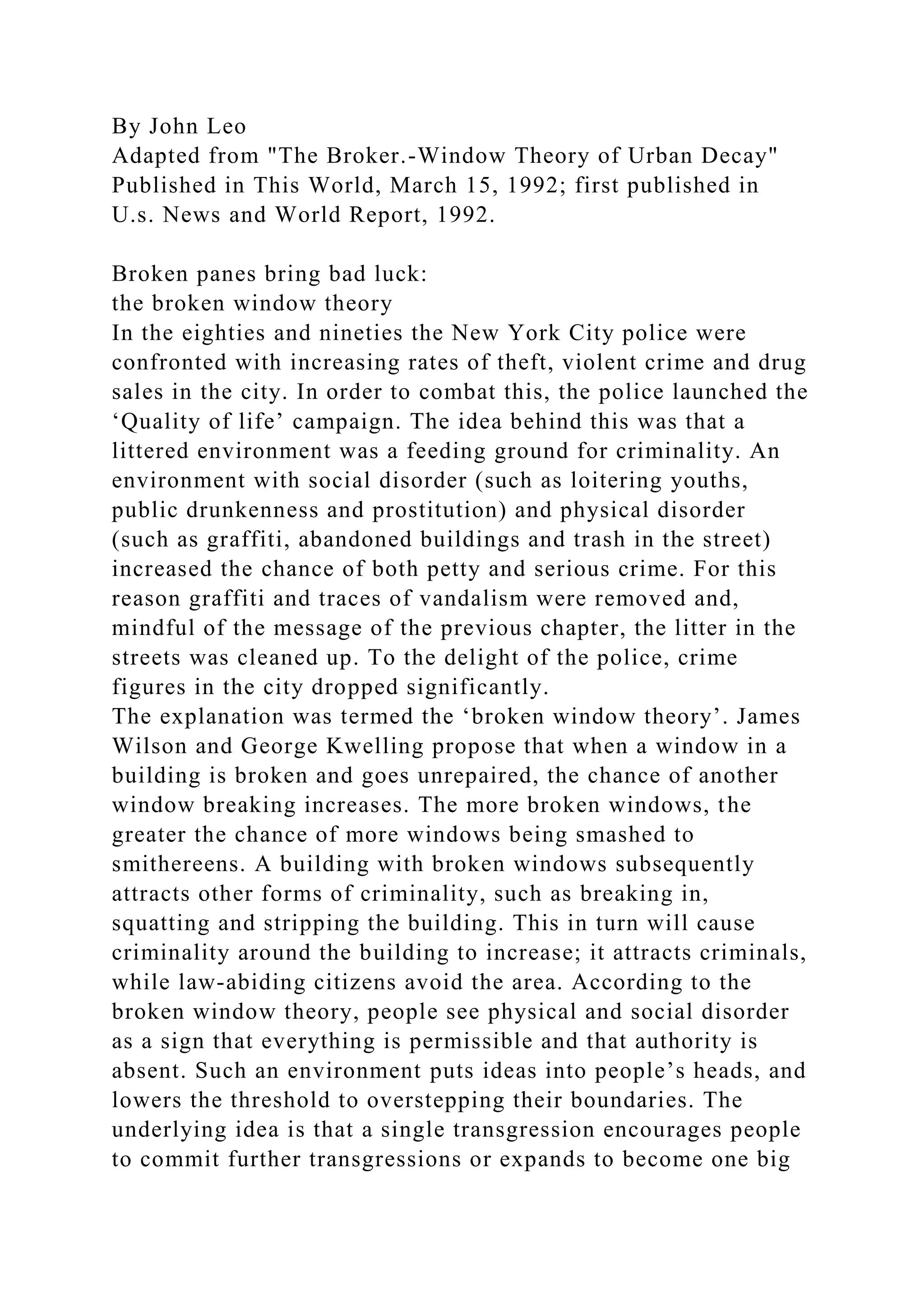
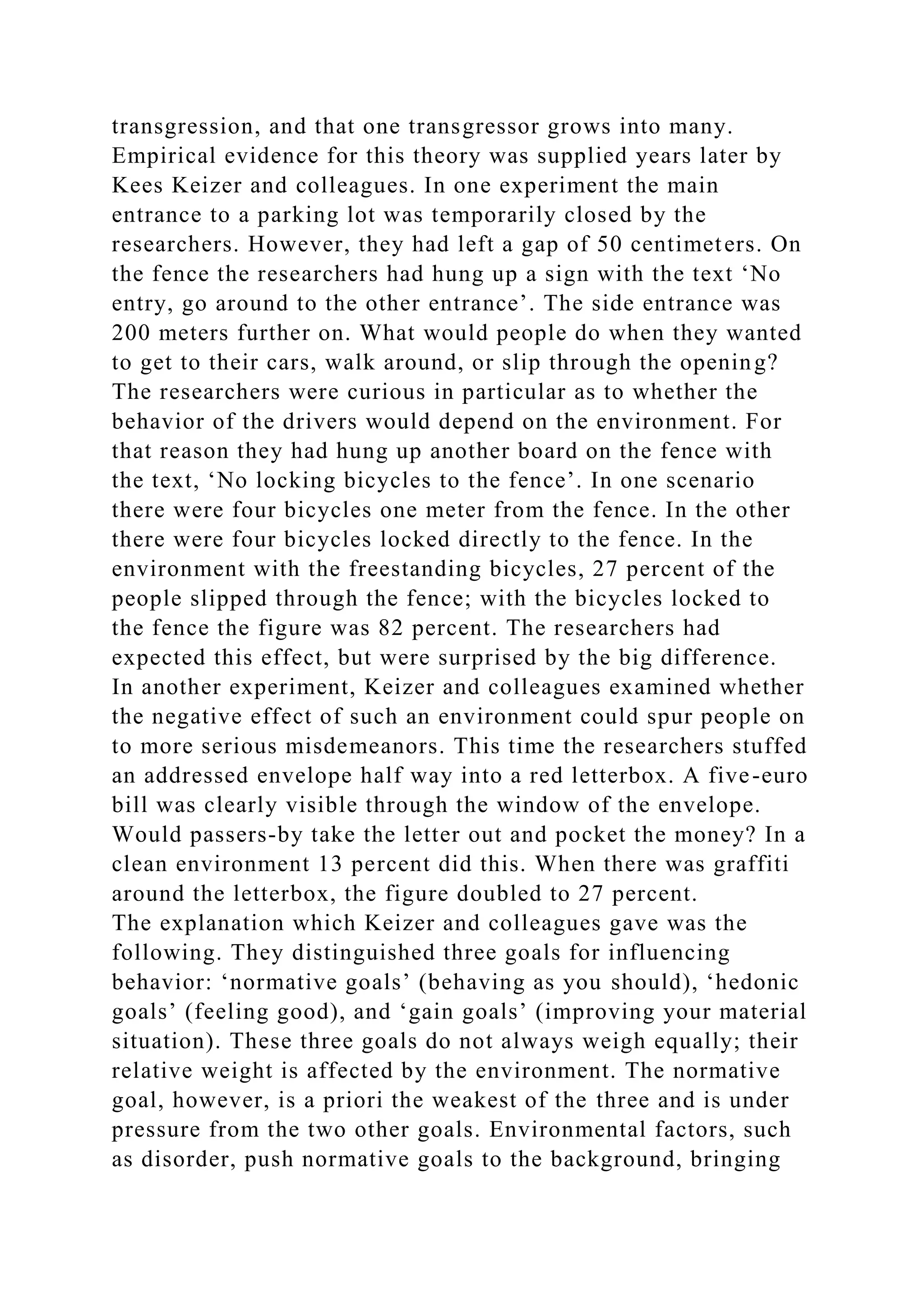
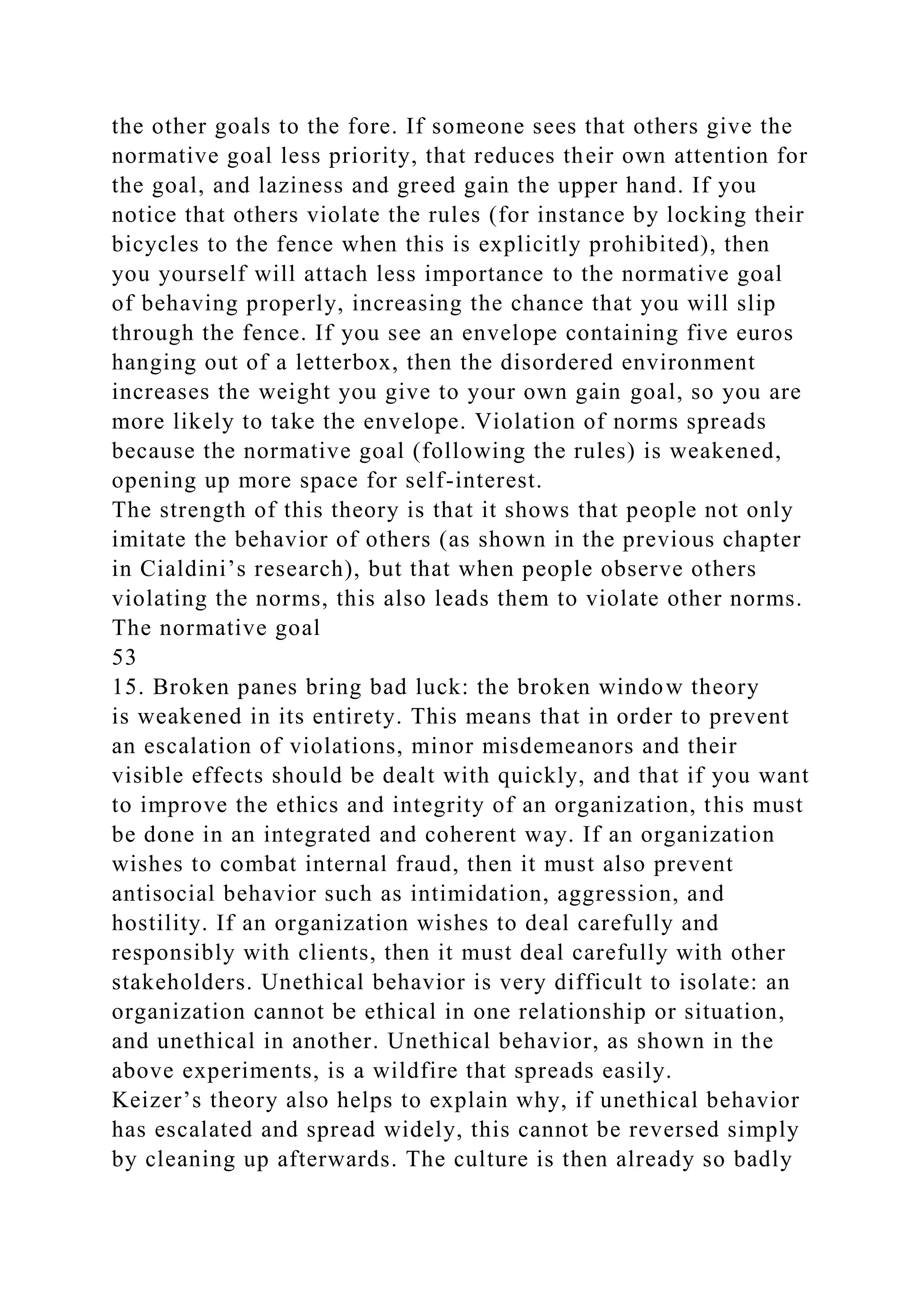
![infected that people no longer attach any significance to the
normative goal. Much energy must then be put into establishing
and communicating the importance of this. Companies which
have slipped off the rails and been discredited can therefore
make a good start towards recovery by re-evaluating their
business mission from a normative perspective, reformulating
business goals, rewriting the code of conduct, making intensive
efforts to communicate this, and providing extensive training to
employees. This is the only way to win back territory for the
normative goal, and it will improve behavior on countless fronts
in its wake.
If you want to prevent an organization being derailed and a
great deal of energy being required to get things back on track,
then the task is to repair “broken windows” in the organization
as quickly as possible.
54
15. Broken panes bring bad luck: the broken window theory
The CDA had dual purposes of creating measures to deal with
anti-social behaviour, and
changing the youth justice system. In placing these two issues
within the same framework
ASB and youth crime were situated within the same discourse.
The Act is heavily weighted
towards measures which target children and young people, and
as a result some have
suggested that the title is misleading. Piper (1999) writing soon
after the introduction of
the Act suggests that:
“…an Act entitled ‘Crime and Disorder’ which concentrates to
the extent
this Act does on children and young persons [sic] is clearly
endorsing
those political and social ideas which emphasise the ‘danger’ of
young
people’s behaviour – the perceived threat from children ‘out of
control’](https://image.slidesharecdn.com/brokenwindowstheoryacademictheoryproposedbyjamesq-221031130150-b85cb06e/75/Broken-windows-theory-academic-theory-proposed-by-James-Q-Wilson-docx-14-2048.jpg)
![and the potential threat to society if children are not guided into
responsible and law-abiding adulthood.” (Piper, 1999: 399)
A sentiment reiterated by Muncie:
“...many of [the CDA’s] provisions are explicitly directed not
only at
young offenders, but at young people in general.” (Muncie,
1999: 147)
Beginning with the CDA, the ASB Agenda has sought to control
the activities of young
people in general, not only those who have acted anti-socially
(if that can ever be clearly
defined). One of the central aims of the ASB agenda is “keeping
young people off the
streets” (DCSF Press Release, 6th January 2010). This is
fulfilled in one of two ways: either
through encouraging young people to join youth clubs and other
extra-curricular activities
(discussed in chapter 6.4.1), or through enforcement measures
such as child curfews or
dispersal powers. This reinforces the perception that the
presence of young people on the
[54]
streets is somehow dangerous; both for members of the
community who may be the target
of youth ASB as well as for the young people themselves who
may become criminal as a
result of their ASB. Youths hanging around on the streets “have
become the universal
symbol of disorder and, increasingly, menace” (Burney, 2002:
73). This problematisation of
youth on the streets is further explored in chapter 6.4. Much of
the discourse justifying
ASB measures targeted at young people and children is based on
the premise that ASB
leads to crime (usually based on ‘broken window’ theory, see:
Wilson and Kelling, 1982)](https://image.slidesharecdn.com/brokenwindowstheoryacademictheoryproposedbyjamesq-221031130150-b85cb06e/75/Broken-windows-theory-academic-theory-proposed-by-James-Q-Wilson-docx-15-2048.jpg)


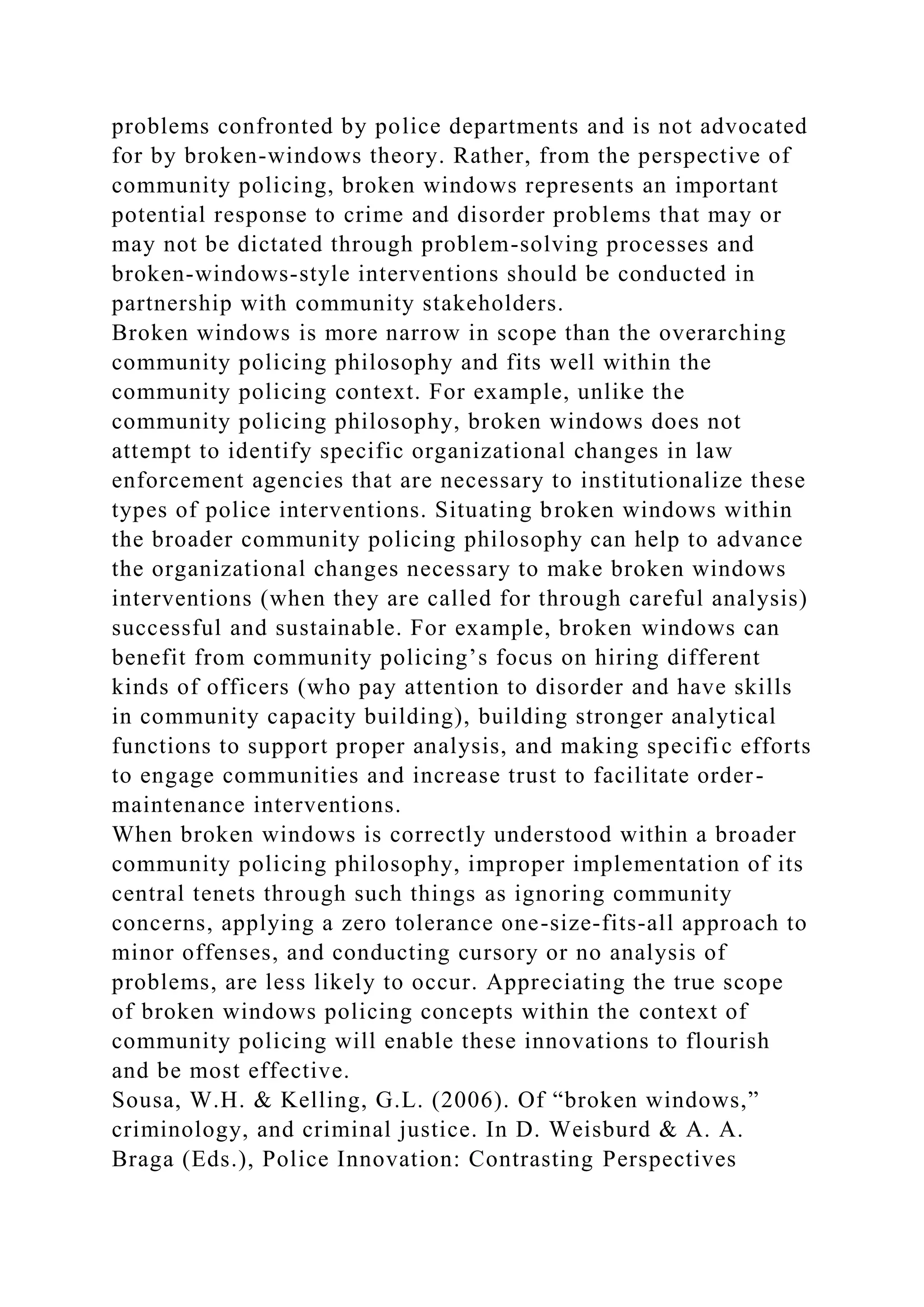

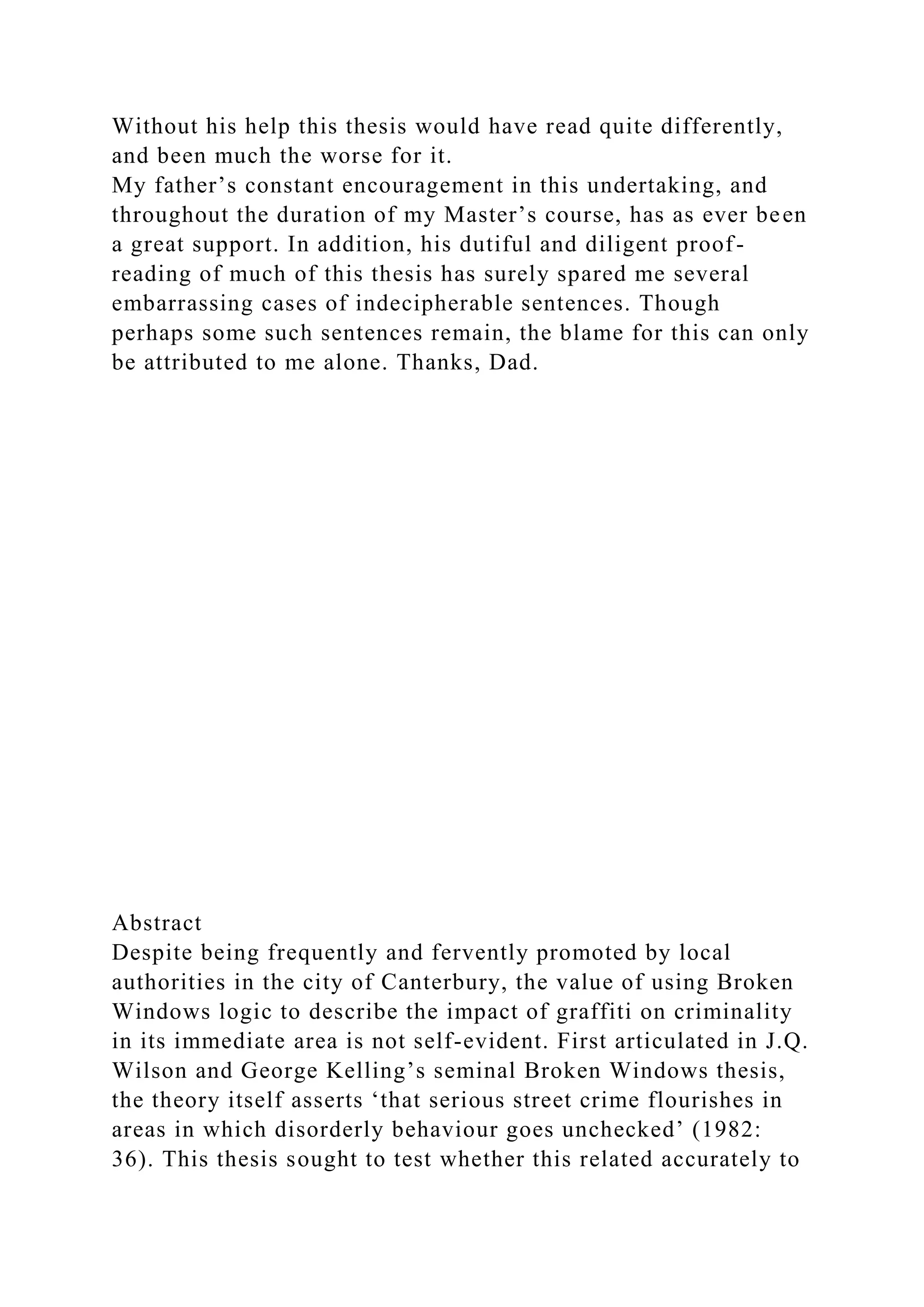
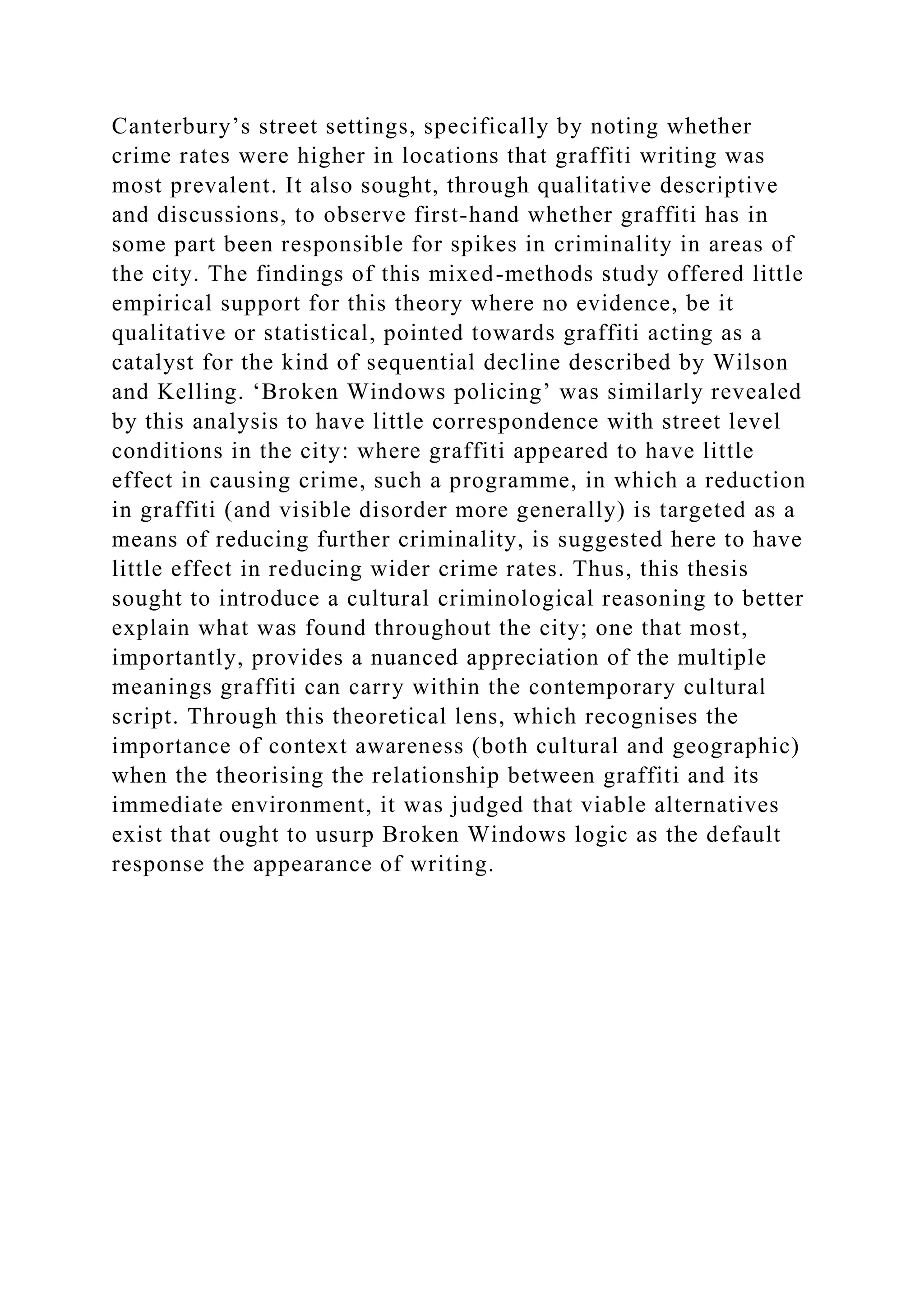
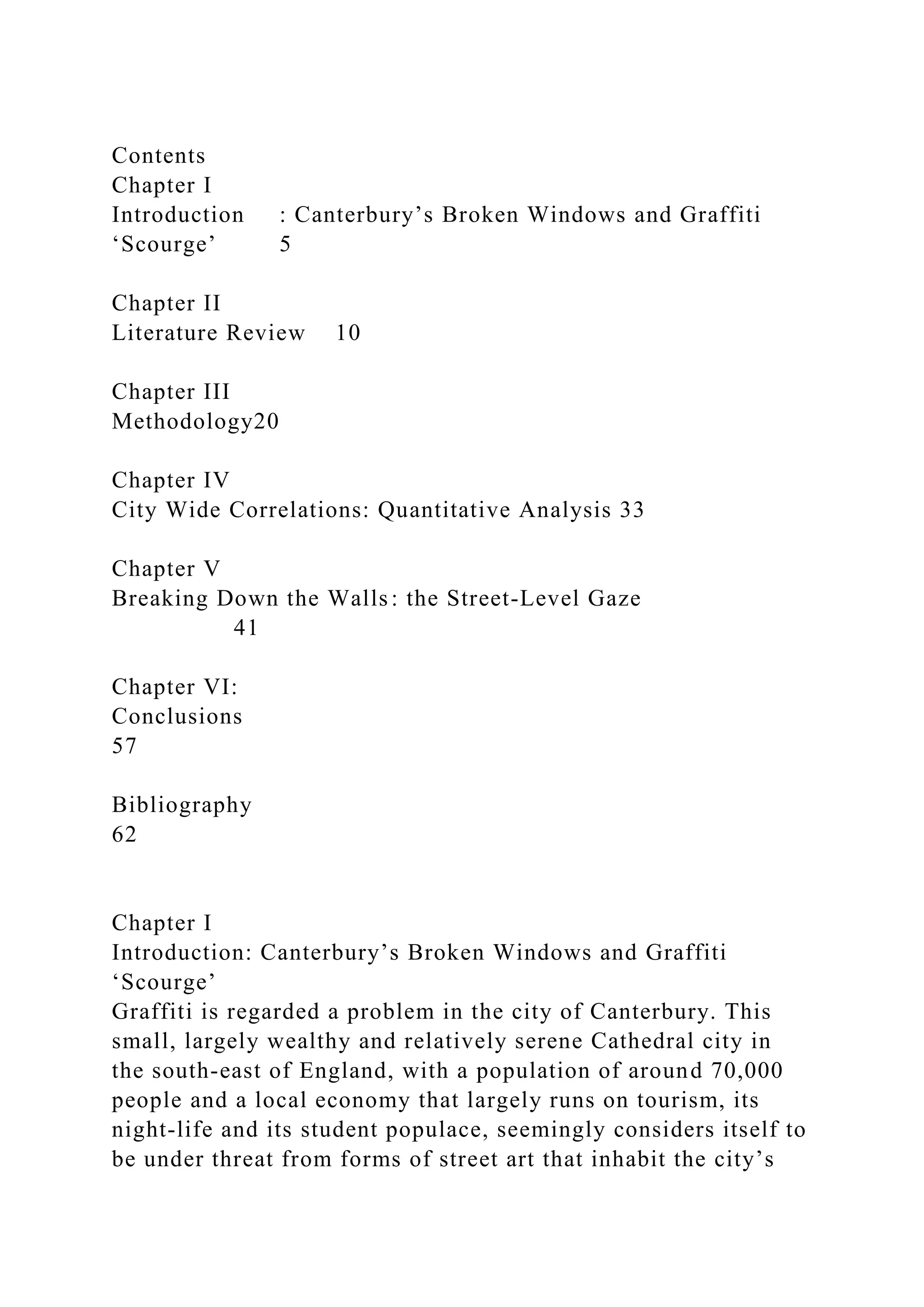
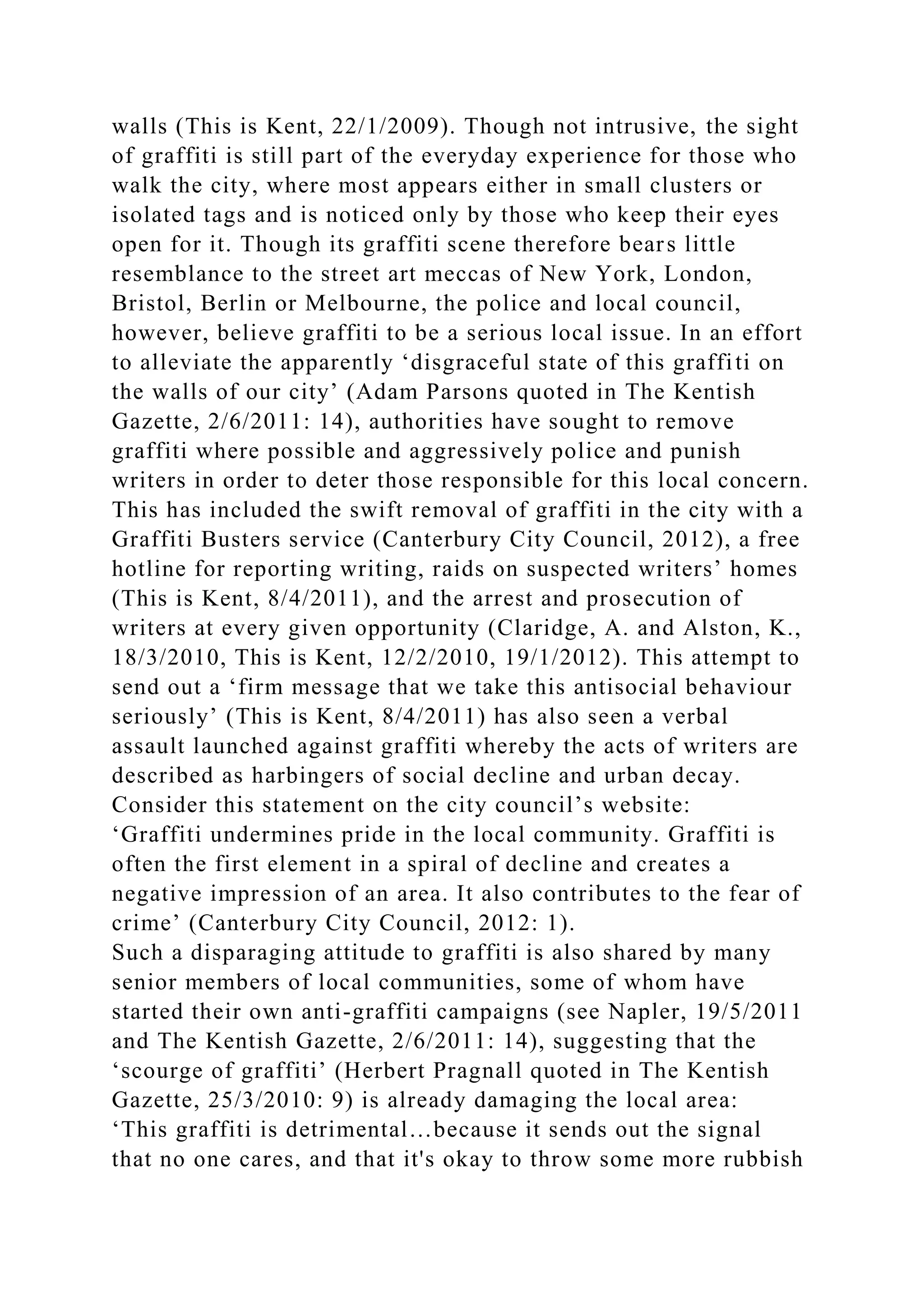
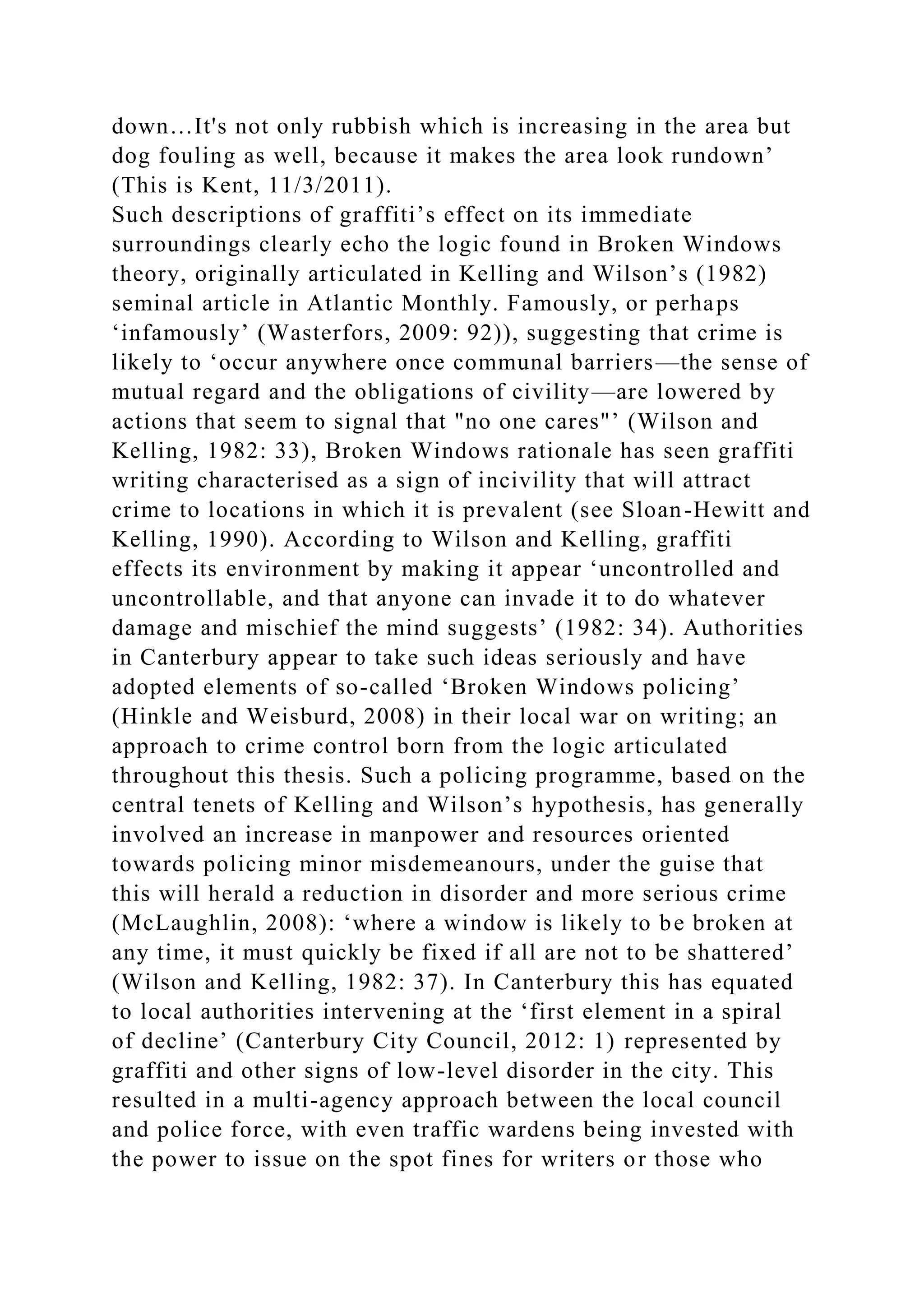
![litter in the city (Warren, 23/8/12).
After its perceived successes in New York City and across
America (Harcourt and Ludwig, 2006), Broken Windows theory
and policing appear to have garnered the approval of many
police practitioners the world over (Wacquant, 2003). However,
the premises of Kelling and Wilson’s argument continues to
inspire debate amongst criminologists, many of which remain
unresolved. Many scholars remain either sceptical towards or
vehemently critical of the theory’s assertions, with its claims
that acts of so-called ‘disorder’ both increase fear of crime and
criminality in their local context regularly being called into
question. Moreover, the effectiveness of Broken Windows
policing remains part of on-going debates, where it has been
suggested that stories of the policy’s success have been vastly
overstated (Harcourt, 1998, Harcourt and Ludwig, 2006).
Among many cultural criminologists there remains little doubt
that those in political power have utilised Broken Windows as a
‘convenient foundation’ (Ferrell, 2005: 148) for ‘assign[ing] the
blame for street crime not to poverty and marginalisation, but to
the poor and marginalised’ (Ferrell cited in Snyder, 2009: 6),
and implicitly linking disorderly behaviours to an ‘underclass’
way of life’ (Squires, 2008: 15), and in doing so propping up
their own popularity (Snyder, 2009: 24). Indeed, this has been
suggested to generally be the case with authorities’ approach to
graffiti writers, and perhaps more so than to any other deviant
group: Austin’s (2001) and Ferrell’s (1996) analysis across New
York and Denver respectively highlight the mobilisation of
Broken Windows against writers at a time when each city’s
mayor stood to acquire political capital by claiming writers to
be the source of several social problems. In light of such
scepticism, this popular policing approach has been suggested
to be based on ‘folk wisdom’ (Matthews, 1992: 20) and ‘the
political and economic goals of those who orchestrate’ such
approaches (Snyder, 2006: 95): representing ‘a taken for
granted assumption’ amongst policy practitioners (Crawford
cited in Beckett and Godoy, 2010: 279), rather than a police](https://image.slidesharecdn.com/brokenwindowstheoryacademictheoryproposedbyjamesq-221031130150-b85cb06e/75/Broken-windows-theory-academic-theory-proposed-by-James-Q-Wilson-docx-25-2048.jpg)

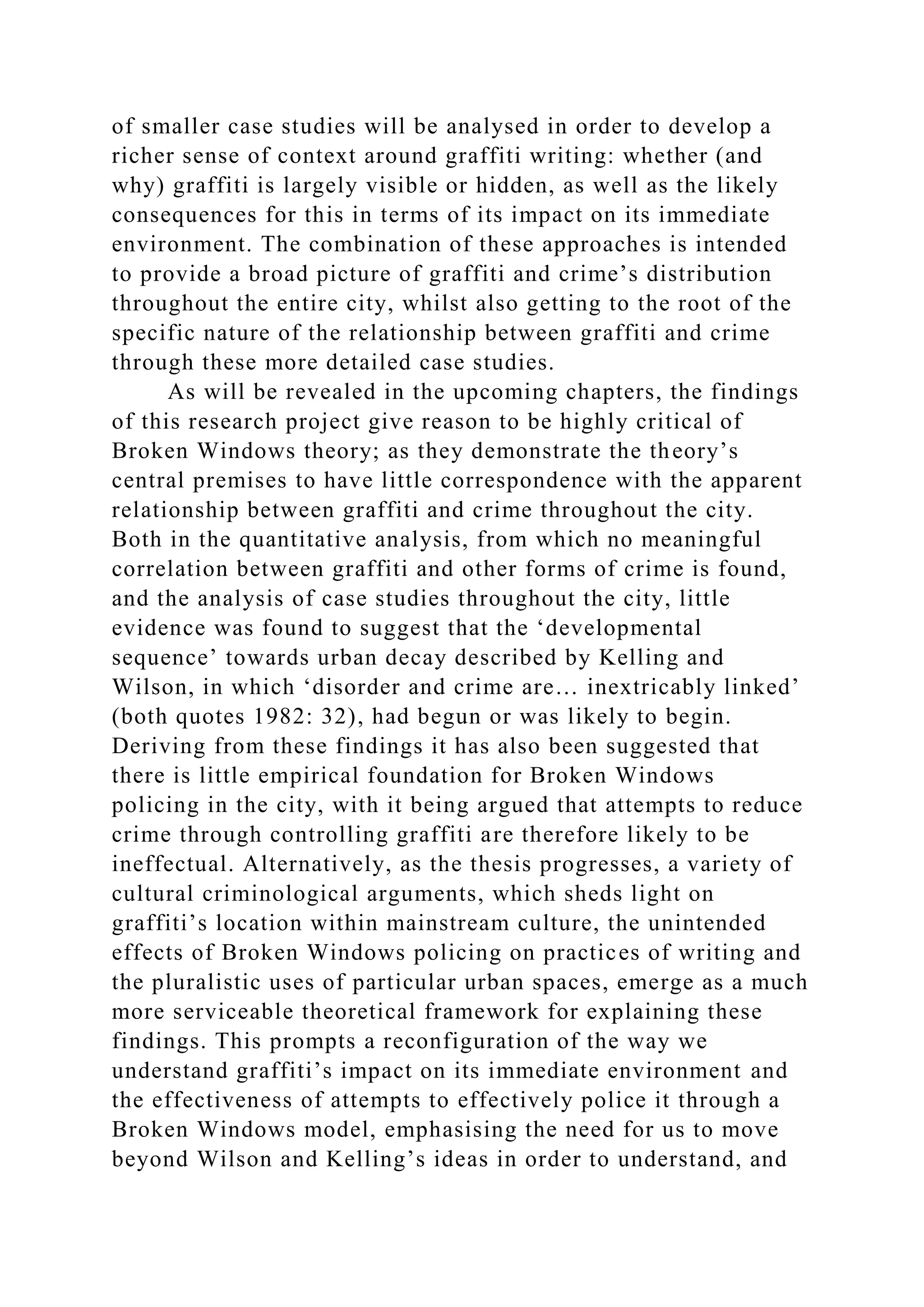
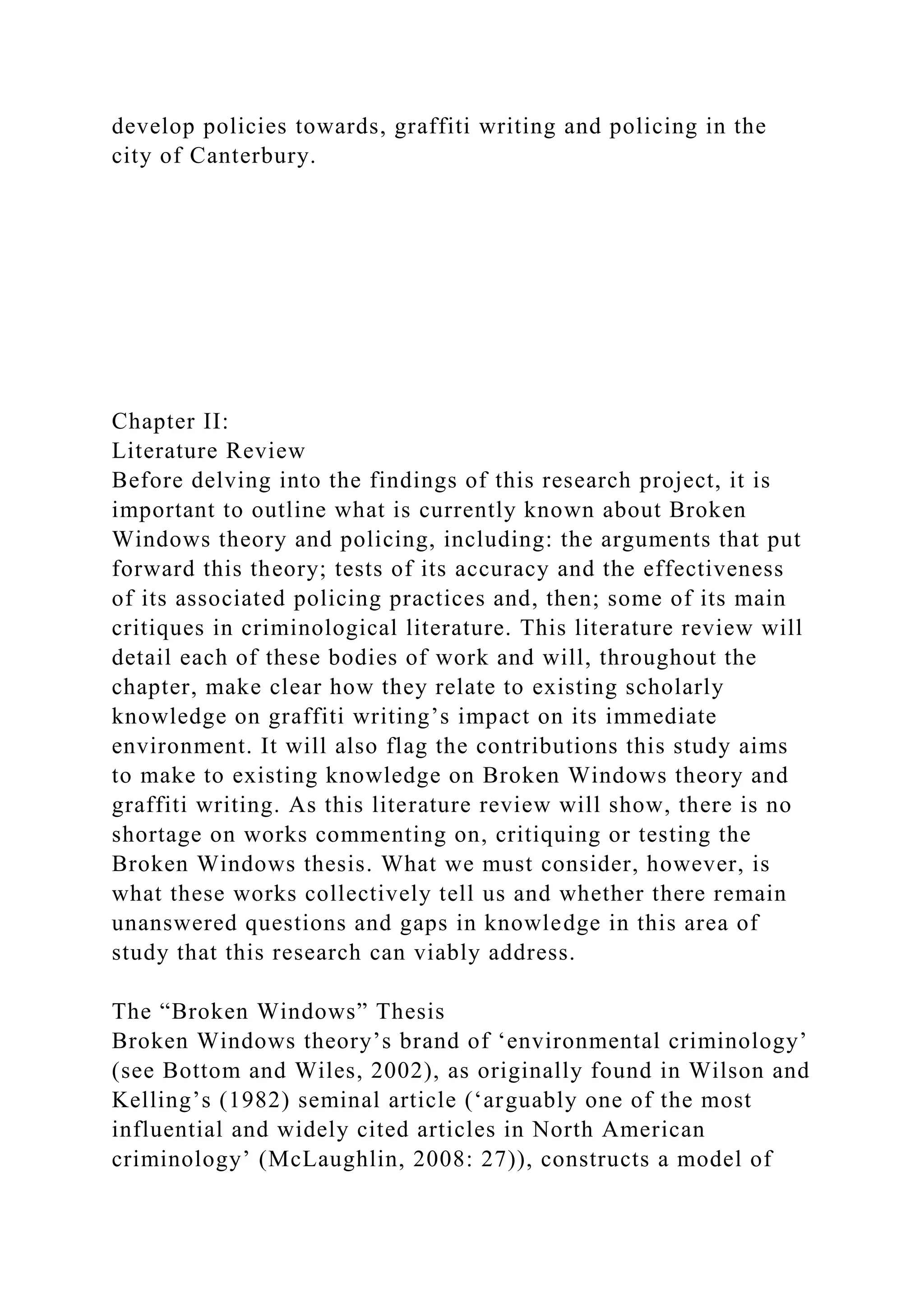
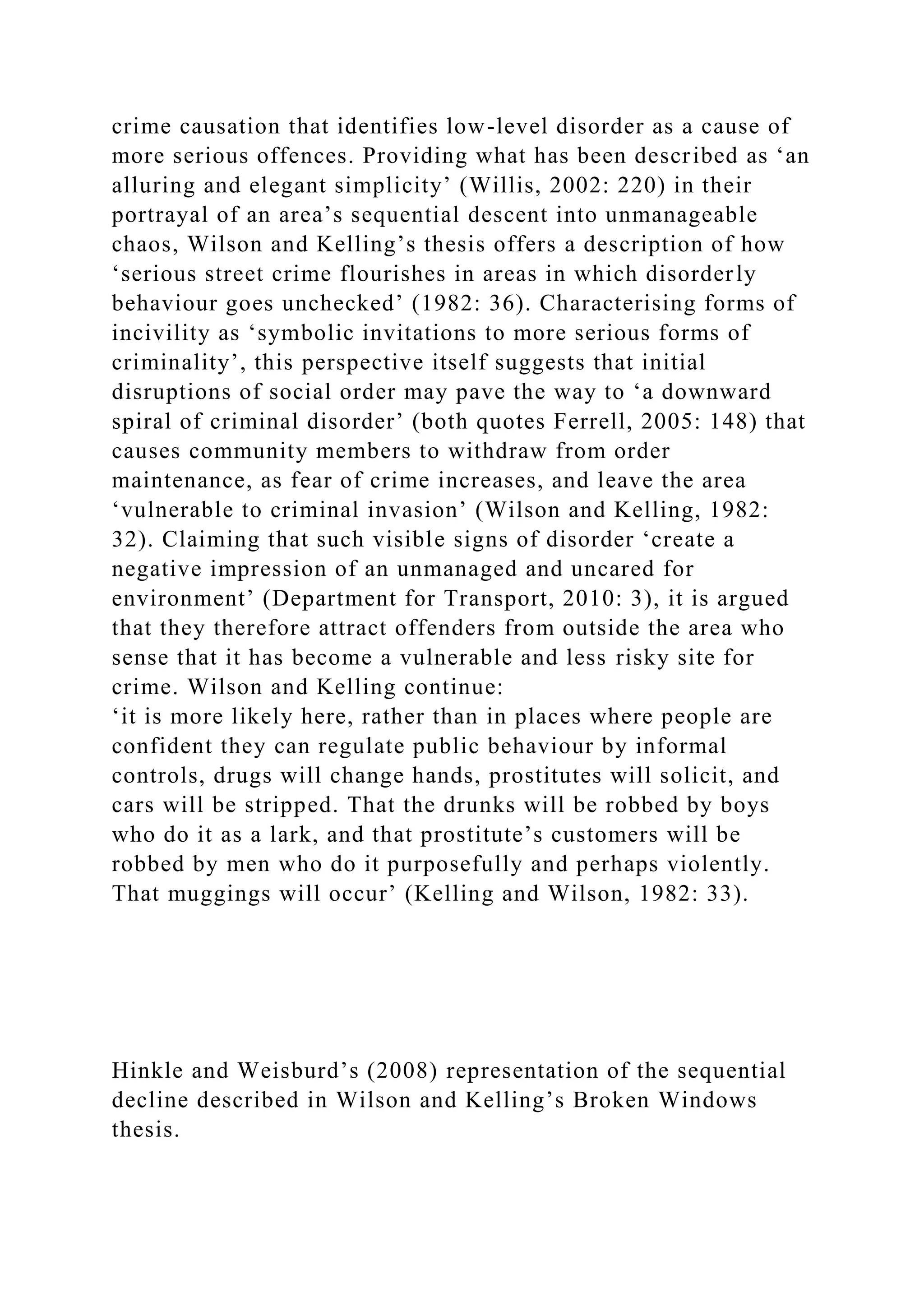
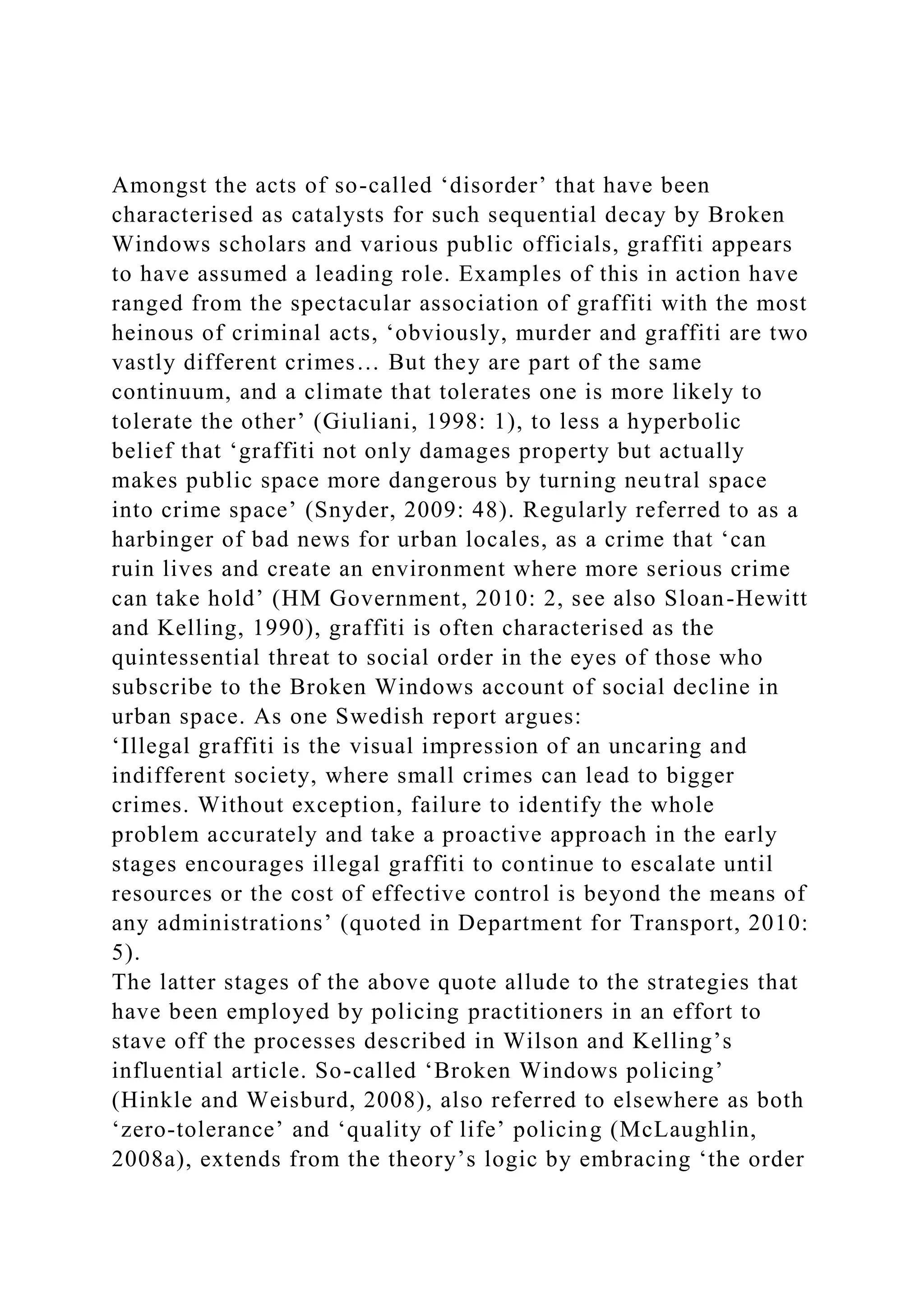
![maintenance function of the police’ (Wilson and Kelling, 1982:
35) and aggressively enforcing minor misdemeanour laws in an
effort to bring about a reduction in initial symptoms of disorder
and, thus, prevent a downward spiral of urban decline (Jang et
al, 2008). Simultaneously, the development of new technology
to aid the police, including developments such as COMPSTAT
and the use of digital technology for surveillance as well as
increased manpower, has generally been central to this approach
(McLaughlin, 2008a, Snyder, 2009). First applied in William
Bratton’s attempt to ‘reclaim the [New York City] subway
system’ (Bratton quoted in McLaughlin, 2008: 59) from
criminality, Broken Windows policing became ‘an integral part
of [the] law enforcement strategy’ (Giuliani, 1998: 1)
throughout the whole city in the 1990s once Randolph Giuliani
was elected Mayor and Bratton appointed police commissioner.
At present, the New York Broken Windows model has since
become the default method of policing across America more
generally, also being used Chicago and Los Angeles (Harcourt
and Ludwig, 2006), and, after perceived success of this
approach in reducing crime rates throughout the 1990s, the
dominant framework for reducing and preventing crime in urban
space across Europe and many places elsewhere (Wacquant,
2003)[footnoteRef:1]. Moreover, this has given the theoretical
ideas that underpin this approach legitimacy in the eyes of many
policing practitioners and public officials, with the original
articulation of Broken Windows theory now standing as one of
the most cited articles in policing literature (Manning, 2001).
[1: That the scholarship of J.Q. Wilson should have a
significant policy impact is of no surprise. Having served on
White House task Force on Crime in 1966 and the US
President’s Foreign Intelligence Advisory Board (1985-1991),
‘Wilson’s scholarship stood in stark contrast’ (Delis, 2010: 192)
critical criminologies that dominated the disciplines throughout
the 1960s and 70s. An opposition that Wilson himself was well
aware of (see Wilson, 1975).]](https://image.slidesharecdn.com/brokenwindowstheoryacademictheoryproposedbyjamesq-221031130150-b85cb06e/75/Broken-windows-theory-academic-theory-proposed-by-James-Q-Wilson-docx-31-2048.jpg)
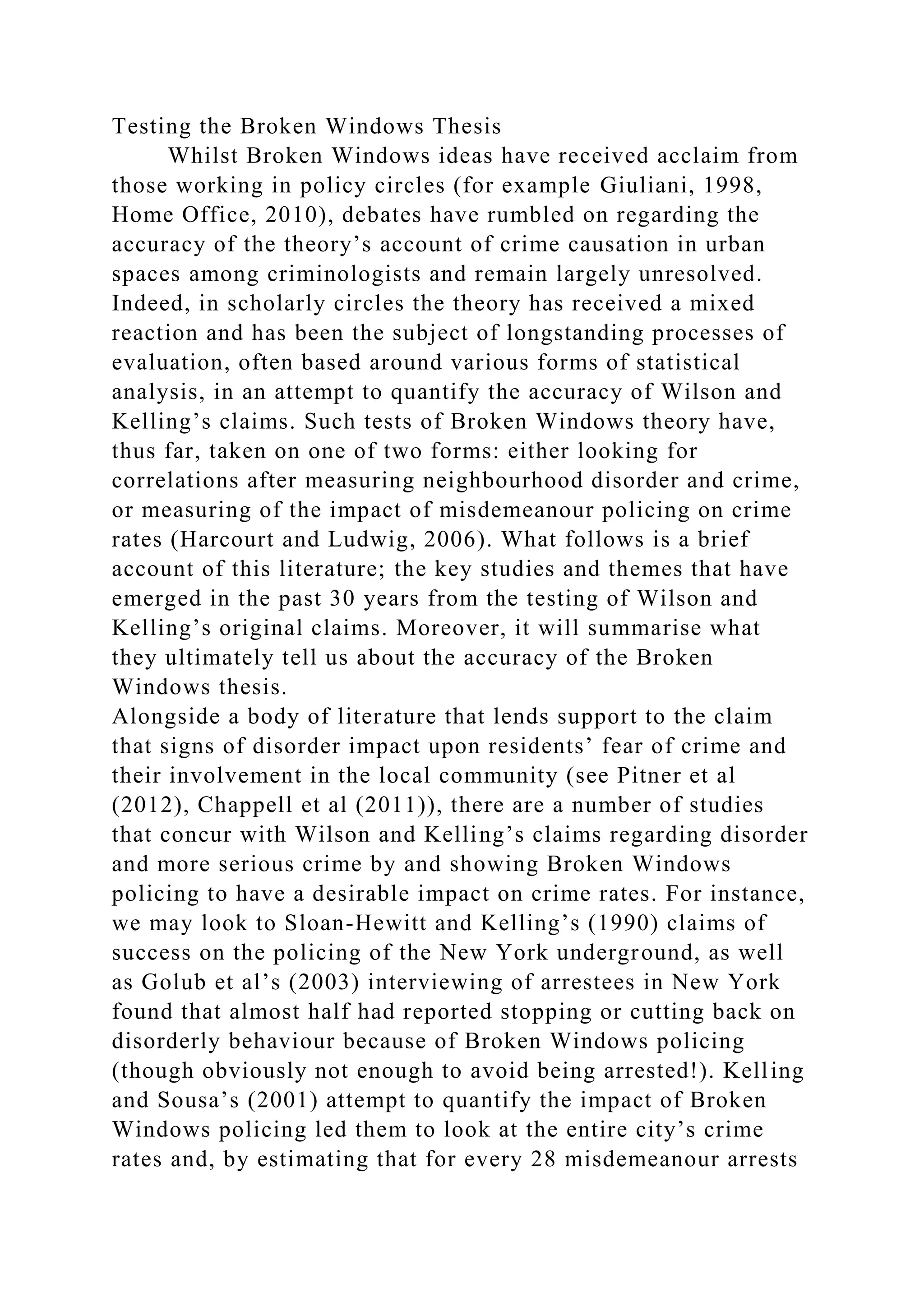
![there was one violent crime prevented, claimed quality of life
policing to have prevented 60,000 violent crimes between 1989
and 1998. These studies, and also other works (such as Zimring,
2007, and Corman and Mocan, 2005), have attributed a large
share of the New York crime drop in the 1990s to this approach
of policing. Outside of New York, Wesley Skogan’s (1990)
widely-cited analysis across 6 American cities found similar a
chain of fear of crime being linked to disorder, and disorder
being a good predictor of robbery victimisation. Similarly,
Thomas et al’s (2011) analysis of arson in Michigan found ‘that
proxies of social disorder can be used to identify areas of high
arson risk, consistent with the Broken Window theory’ (2011:
271). Such studies, however, have often been criticised for the
quality and the nature of their analysis. Re-examining Skogan’s
data set, for example, Brian Harcourt (1998) found that the
conclusions originally offered by the author were skewed by the
influence of a few extreme cases and locations, finding instead
that there was an insignificant relationship between disorder
and serious crime in the vast majority of locations. In addition,
Harcourt and Ludwig’s (2006) analysis prompts caution towards
Kelling and Sousa’s (2001) findings by noting that their
analysis had been skewed by a failing to control for crime rates
prior to 1990[footnoteRef:2]. As these cases show, despite the
evidence pointing towards Wilson and Kelling’s thesis and its
cognate programme of Broken Windows policing being of some
value, there remains reason to remain wary of the these claims
and the evidence used to support them. [2: Citing mean
reversion, Harcourt and Ludwig note that the biggest drops in
the data set came from areas that experienced the largest rise in
crime in the 1980s. They observe that ‘jurisdictions with the
greatest increases in crime during the 1980s tend to experience
the largest subsequent declines as well’ (2006: 276) regardless
of whether Broken Windows policing was used in these areas or
not, and that the effect of such policing was vastly been over-
estimated by Kelling and Sousa (2001).]](https://image.slidesharecdn.com/brokenwindowstheoryacademictheoryproposedbyjamesq-221031130150-b85cb06e/75/Broken-windows-theory-academic-theory-proposed-by-James-Q-Wilson-docx-33-2048.jpg)
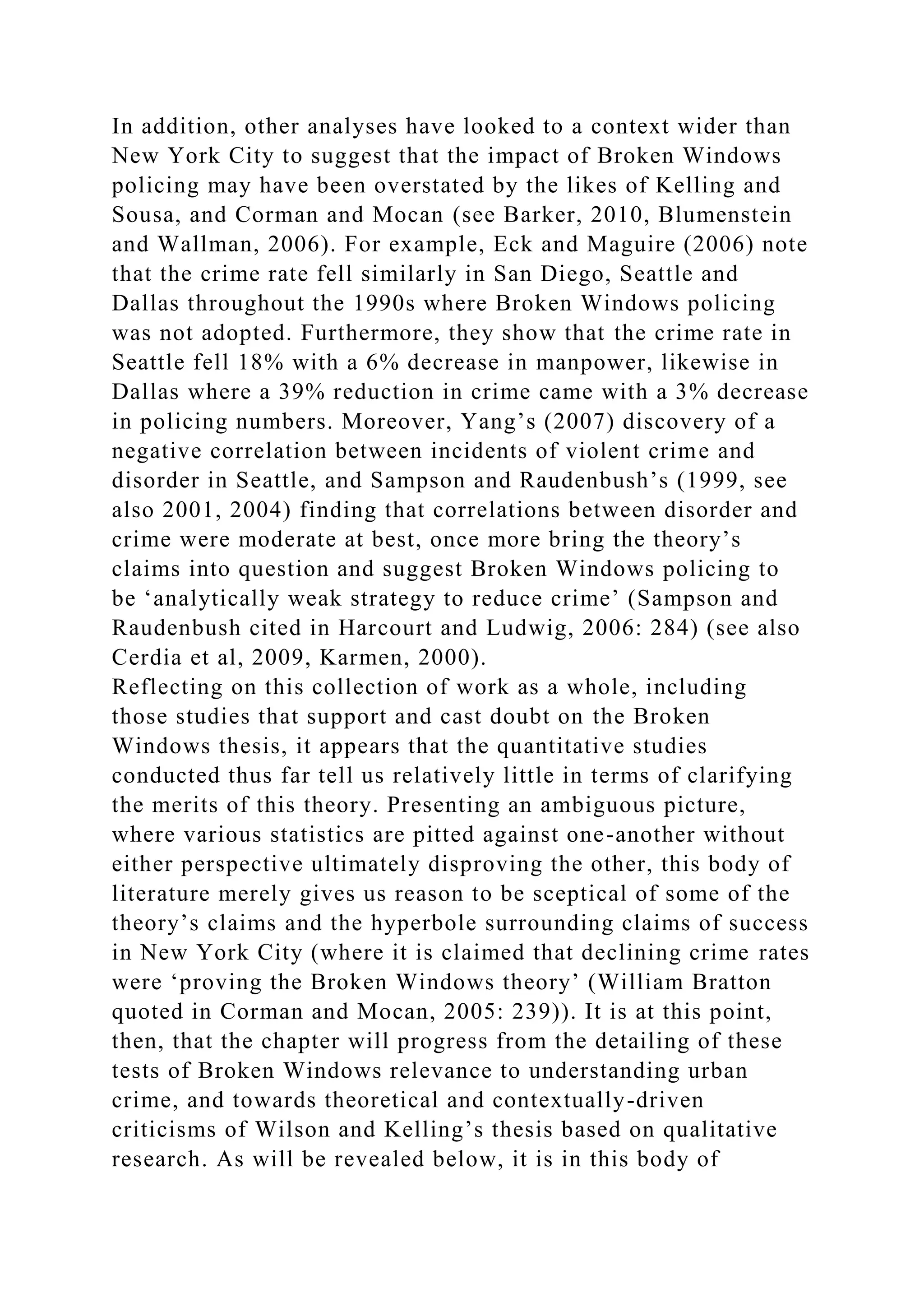
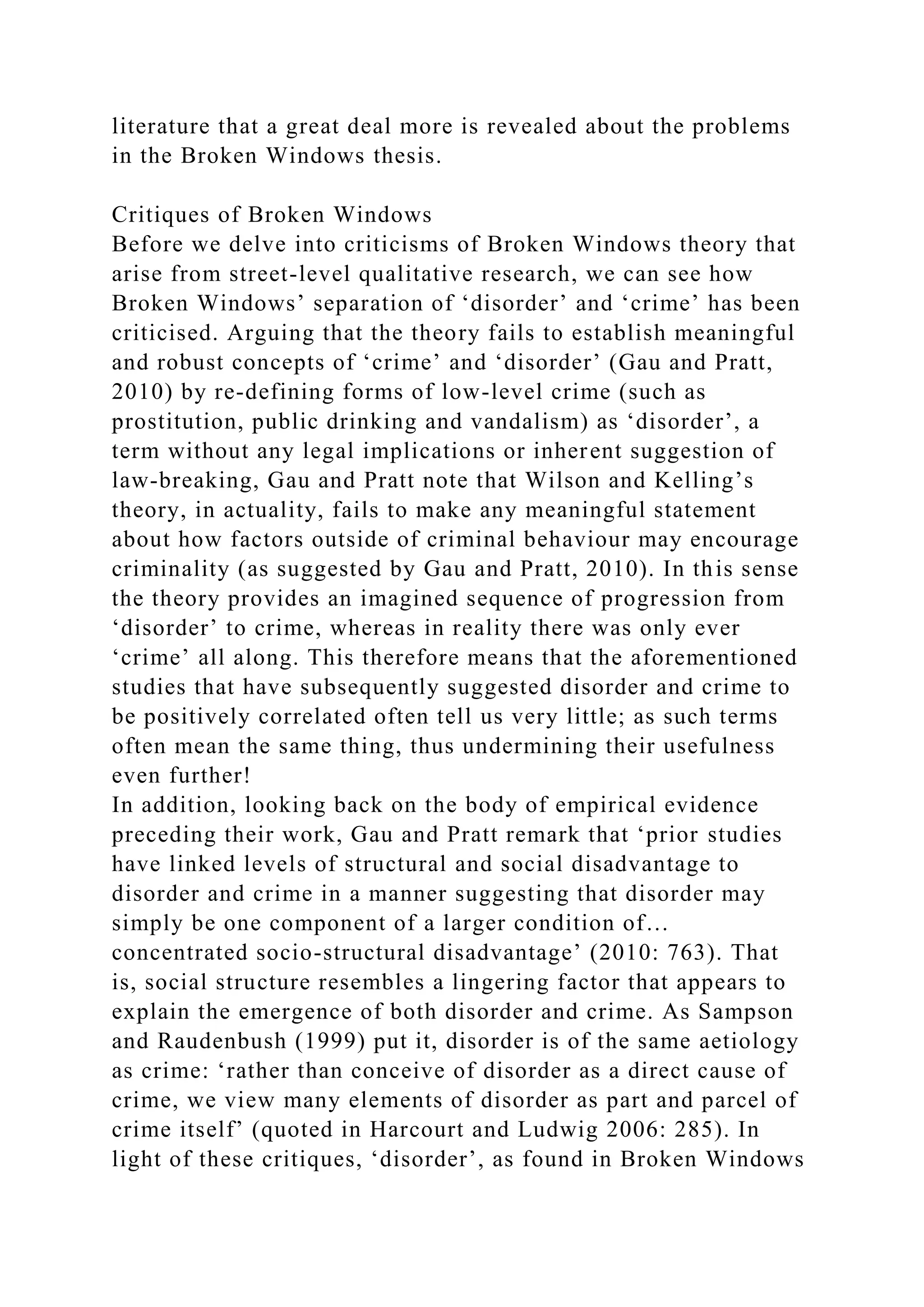
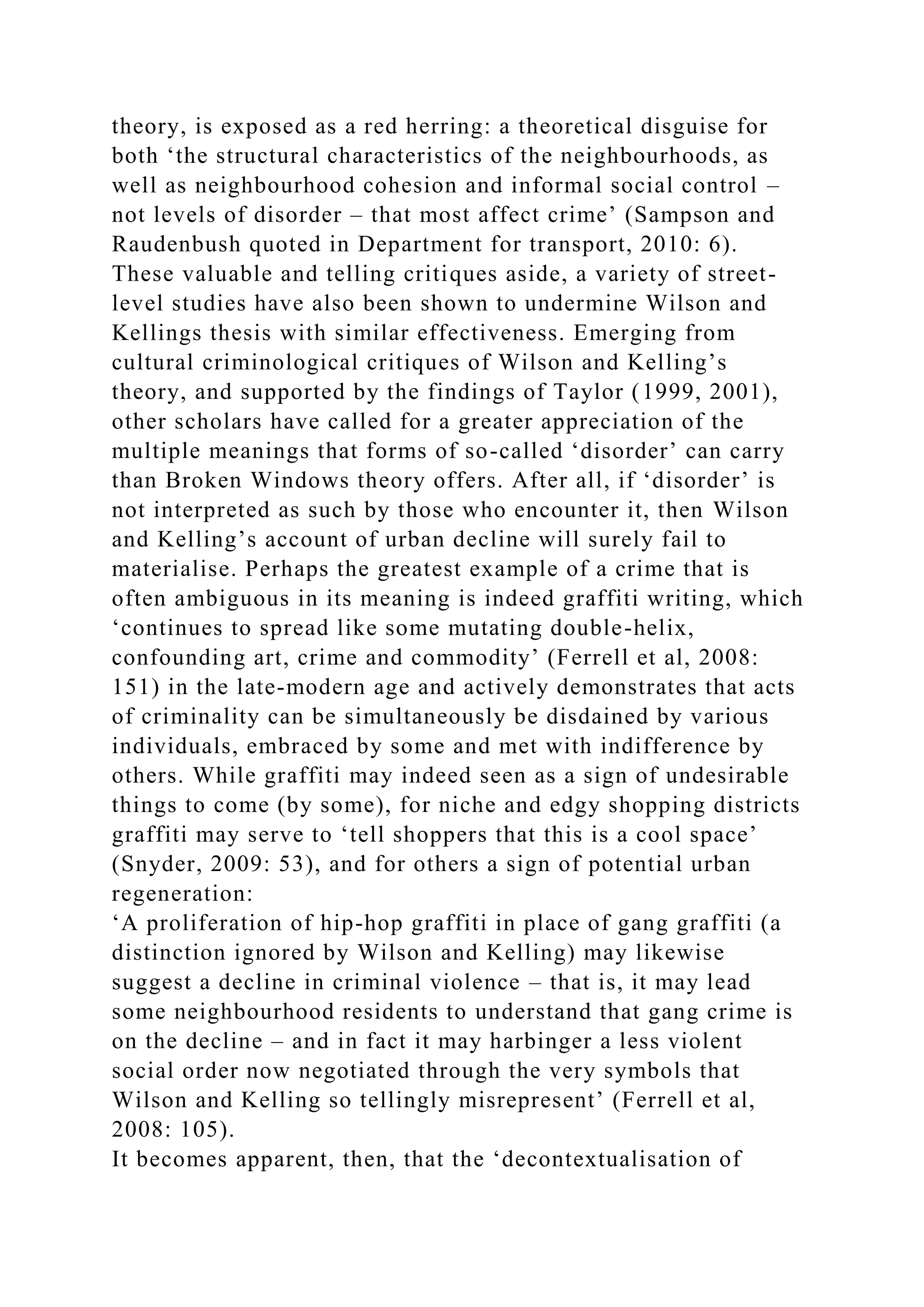
![disorder’ (Gau and Pratt, 2010: 759) within a Broken Windows
model that ‘constructs a series of abstract, one-dimensional
meanings that it arbitrarily assigns to dislocated images’
(Ferrell et al, 2008: 104) of urban crime is not one that is
capable of grasping the complexities and contradictions in
graffiti’s, and perhaps other examples of so-called disorder’s,
meaning to urban audiences:
‘None [are] self-evident or assured; each is negotiated day-to-
day amidst the swirl of urban populations. Because of this,
accurately understanding public display as a key nexus between
crime and culture requires attentiveness and long-term emersion
in everyday situations – not [Broken Windows’] abstract
political posturing’ (Ferrell, 2005: 149).
Ferrell’s call for a contextualised analysis that can dig deeper
into the subtleties of crime has not only extended to a cultural
criminological appreciation of the meanings applied to graffiti
and other crimes; it also relates to different approaches to
ascertaining what environmental factors encourage particular
criminal behaviours. Departing from the detached position
adopted by ‘the milieu of social researchers who choose not to
look at the world’ Emmanuel David (2007: 251), Ralph Taylor’s
studies of Baltimore (1999, 2001) where a mixture of on-site
assessments, maps, census, crime figures and interviews with
residents and community leaders were used, provide a good
example of such an approach. Finding that while some types of
incivilities were related to serious crimes and many others were
not, Taylor identified a variety of separate problems of crime
without a common underlying cause or remedy. In short, the
idea of disorder underpinning the spread of urban crime has
been suggested by Taylor to be false. Elsewhere, Broken
Windows theory’s explanation of criminal behaviour itself,
where criminals are presented as rational actors in the process
of risk-avoidance whilst committing crime (therefore leading
them to low risk ‘disorderly’ areas), has similarly been shown
to be equally troublesome. The work of Peter St. Jean is useful
here for demonstrating how Broken Windows theory fails to](https://image.slidesharecdn.com/brokenwindowstheoryacademictheoryproposedbyjamesq-221031130150-b85cb06e/75/Broken-windows-theory-academic-theory-proposed-by-James-Q-Wilson-docx-37-2048.jpg)
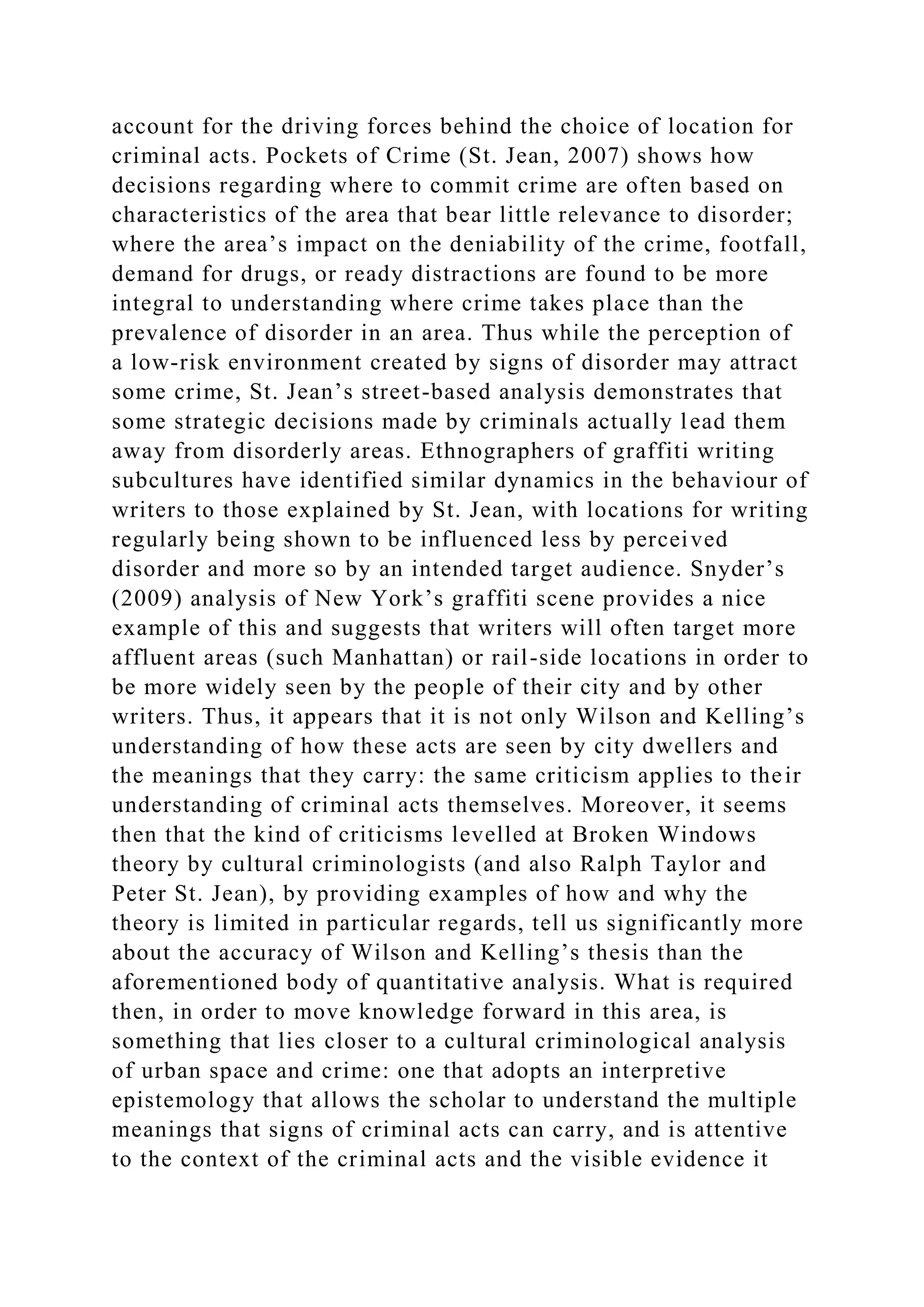
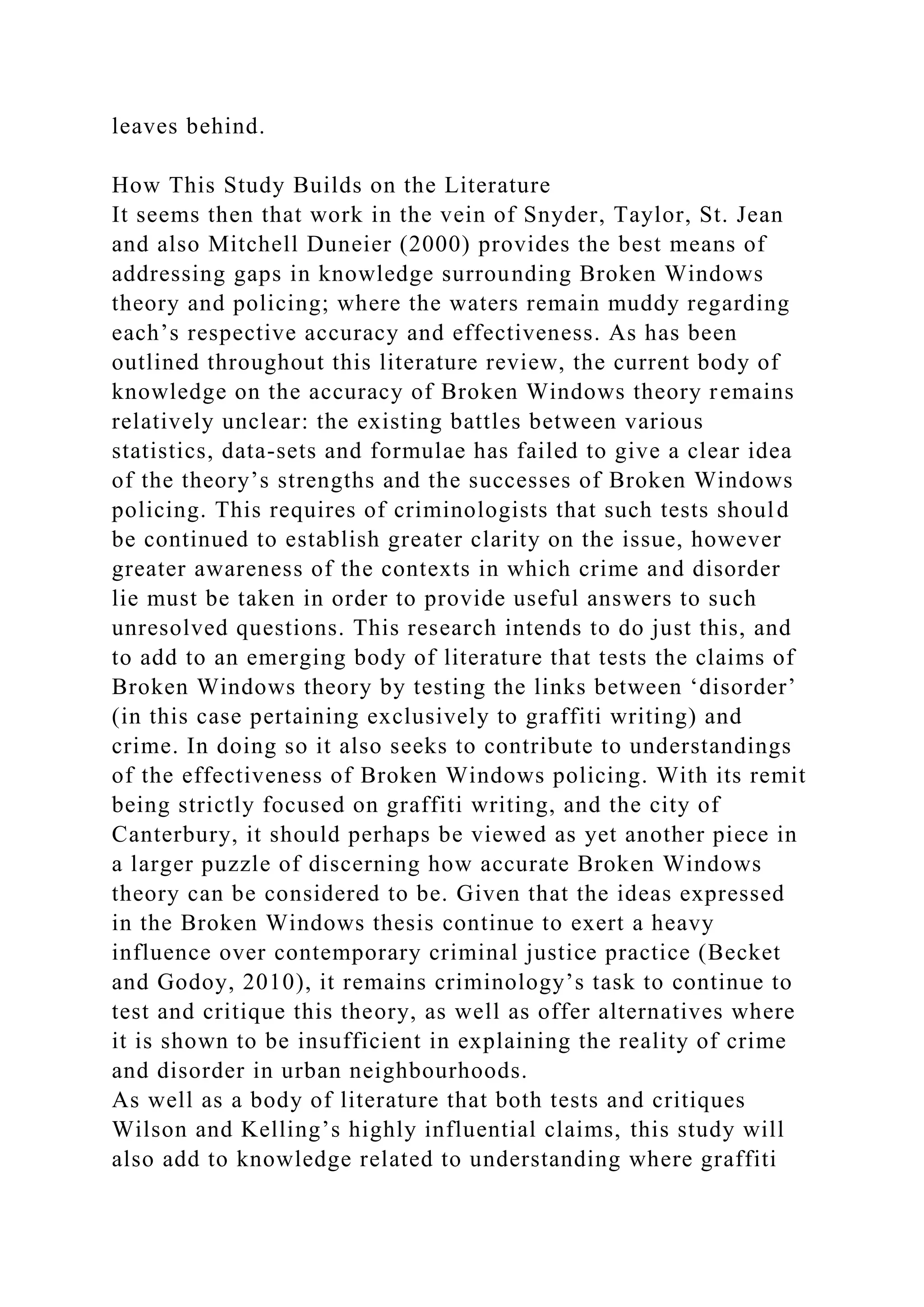
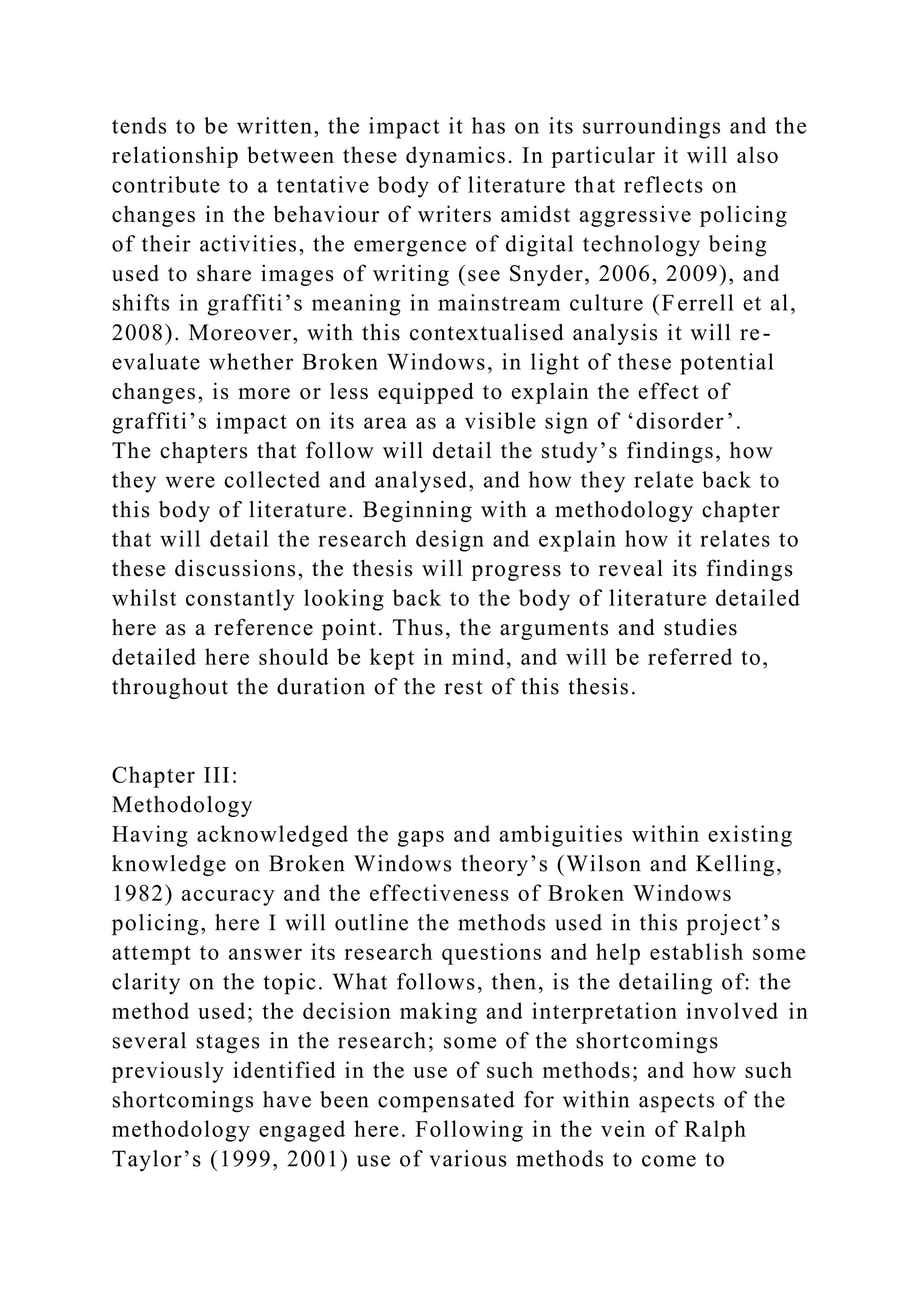
![understand the validity of Broken Windows theory in Baltimore,
this chapter will detail how the mixed methods approach
adopted here, which utilises examples of both quantitative and
qualitative approaches, provides the best means of answering
our research questions. As was concluded at the end of the last
chapter, studies that have pursued a purely method have both
individually and collectively told us relatively little about the
accuracy of Broken Windows theory and the success of its
associated policing practices. Proceeding in two sections,
organised around the two respective stages of quantitative
analysis and qualitative research conducted as part of this
thesis, this chapter will also outline how the research conducted
here provides the broad picture and small-scale specificity
required to address this issue.
Quantifying and Mapping Crime and Graffiti: The Search for
Correlations
In the first stage of this research, a combination of crime maps
populated with recorded crime data and photography will be
utilised to first quantify crime and graffiti in Canterbury, before
identifying correlations between these variables. Though it is
therefore a quantitative method used here, this is not to be
confused with a strictly ‘scientific’ process by any means: it
instead involves subjective decision-making and interpretation
on the part of the researcher at several stages[footnoteRef:3].
Thus, this section will not only reveal the specifics of this
methods, but it will also acknowledge where, how and why such
judgements have been made and acted upon, as well as how
weaknesses in this method have been confronted. It will, of
course, also highlight the value of the insights that can be
gained through the use of this approach. [3: Furthermore, the
subjectivity within crime statistics is recognised. As Lea and
Young (1942: 12-13) put it, ‘both the interpretation of whether
or not an act is criminal and the resources available for
labelling acts as criminal make an enormous amount of
difference to the final statistic. Nor is this a result of an](https://image.slidesharecdn.com/brokenwindowstheoryacademictheoryproposedbyjamesq-221031130150-b85cb06e/75/Broken-windows-theory-academic-theory-proposed-by-James-Q-Wilson-docx-41-2048.jpg)
![imperfect world where, if only we had more tightly written laws
and a lot more police, we could arrive at the ‘true’ crime rate.
Rather, it lies in the nature of crime itself that there is an
important level of human interpretation in the definition of what
is criminal’]
Recorded crime statistics were drawn from the newly-launched
police.uk website and used to quantify crime within 10 selected
areas of the city for the 6 month period of December 2011-May
2012. The designation of these 10 zones was based on the
researcher’s decision making, though underpinned by an attempt
to replicate the conditions being tested to those described in the
Broken Windows thesis. The leading imperative was that each
of the ‘zones’ designated for this research project be roughly of
equal size and, where possible, their boundaries were selected
so that each would represent an identifiable part of the city or a
neighbourhood/estate as they are regarded locally. Thus, zones
include the Knight’s Avenue Estate, Spring Lane Estate, or the
city centre which is separated from the rest of Canterbury by the
medieval city walls. This was done in an effort in to replicate,
as accurately as possible, the conditions described by Wilson
and Kelling in their article; where the emphasis is placed
around their being a manifestation of communities or
‘communal barriers’ (1982: 34) that are affected by fear of
crime and, then, criminal invasion. By trying to make these
zones applicable to areas in the town that are likely to consider
themselves communities, such as a self-contained housing
estates, it is hoped that this has been successfully replicated
somewhat so that the analysis provides the most appropriate
framework for testing this thesis and answering the research
questions.
The process of quantifying graffiti was similarly based on
interpretation, though a logical one, as there appeared no self-
evident method of quantifying writing objectively. Indeed such
problems in enumerating graffiti have been previously
acknowledged to be troublesome. As Greg Snyder notes, the](https://image.slidesharecdn.com/brokenwindowstheoryacademictheoryproposedbyjamesq-221031130150-b85cb06e/75/Broken-windows-theory-academic-theory-proposed-by-James-Q-Wilson-docx-42-2048.jpg)
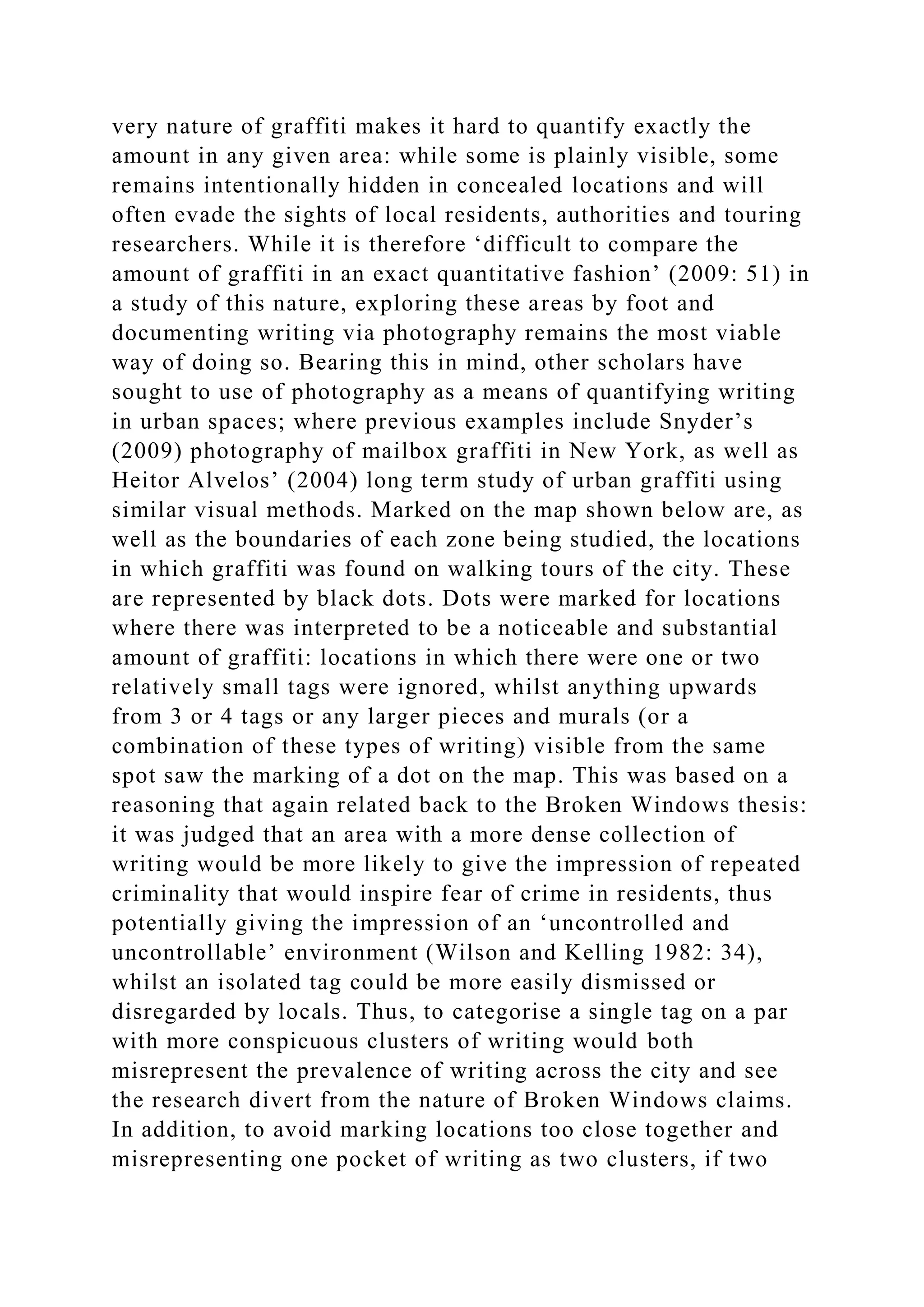

![forms of mapping to obtain an idea of crime levels across
Canterbury, in a process offers that practical advantages of
convenience and a lack of expense and gives a broad view of the
relationship between graffiti and crime, potential problems do
arise from the use of official data and forms of crime mapping
that underpins this approach. These problems have, however,
been acknowledged and compensated for in the methodological
design of this research, meaning that such shortcomings’ impact
on our ability to effectively answer the research questions
remain limited. The nature of these problems, as well moves to
restrict their negative impact and offer solutions to them, will
be outlined in this section.
Police.uk’s mapping of recorded crime data across the UK’s
streets, which maps crime for each street in the UK and makes
data freely available to any individual interested in ‘identifying
crimes right on their doorstep anywhere in the country’
(Whitehead, 2011: 1), presents new opportunities for
criminologists interested in researching crime rates by allowing
researchers (and the public) to chart the distribution of crime
across and within an entire city at the click of a few
buttons[footnoteRef:4]. Whilst this innovative method of
presenting data freely on this internet offers convenience for
scholars interested in studying crime rate, pre-existing concerns
regarding the validity and reliability of official data dictate that
we must continue to exercise caution in how we use such crime
statistics in research. Amongst criminologists and statisticians
alike, the long-standing criticism of crime figures is that they
‘do not give a clear picture of the social or situational context
of crimes’ (Maguire 2002: 343) and remains a powerful check
on the use of official data as the base for any research seeking
to accurately convey the reality of crime. Certainly, it is widely
known amongst criminologists that problems of differing
interpretations of criminality that impact upon decisions
whether to report record or crimes on the part of several actors,
a dark figure of crime, and a variety of other shortcomings
severely affect crime data’s ability to do so (see, for example,](https://image.slidesharecdn.com/brokenwindowstheoryacademictheoryproposedbyjamesq-221031130150-b85cb06e/75/Broken-windows-theory-academic-theory-proposed-by-James-Q-Wilson-docx-45-2048.jpg)
![Mclintock, 1963, Cicourel, 1968). In light of this, the
‘subjective and political nature of the ‘official’ crime statistics’
(Lea and Young, 1984: 16) sees such data regarded as
‘embodiments of police discretion’ and ‘governmental agenda’
(Ferrell et al, 2008: 195-196) rather than hard facts by some. It
may then appear that the use of such data may jeopardise the
project’s ability to test the Broken Windows thesis with
accuracy. That would certainly be the case if they were relied to
convey a precise picture of crime throughout the city of
Canterbury. However in a basic capacity crime statistics
maintain the ability to notify us of increases or decreases in
crime, as well as providing a basis on which we can compare
levels of criminality across different areas, therefore potentially
fulfilling a viable role in a variety of criminological projects.
As John Lea and Jock Young remind us, it would be a mistake
to dismiss them entirely: [4: One should always keep an eye
out for anomalies produced by errors in data, however, as there
have been teething problems with the police.uk project. For
instance, one street in Preston was recorded as having suffered
152 incidents of recorded crime in a single month, despite only
actually having has 3 incidents (Bunyan, 2011)!]
‘We must handle the figures with caution, and, most
importantly, that we must develop a sense of realism. We must
avoid both the alarmism which takes the figures simply at their
face value and the sense of false calm which insists that the
same statistics are a mere product of police practices’ (Lea and
Young, 1984: 16)
What remains crucial is that criminologists approach official
crime data ‘in a critical frame of mind’ (Maguire, 2002: 322),
namely by being aware of such failings and accommodating for
them in their methodological designs. By and large, crime
statistics have proven useful when allowing criminologists to
largely discern when crime is increasing or declining and
whether particular areas suffer from particularly high or low
levels of crime, rather than being relied upon to convey an](https://image.slidesharecdn.com/brokenwindowstheoryacademictheoryproposedbyjamesq-221031130150-b85cb06e/75/Broken-windows-theory-academic-theory-proposed-by-James-Q-Wilson-docx-46-2048.jpg)
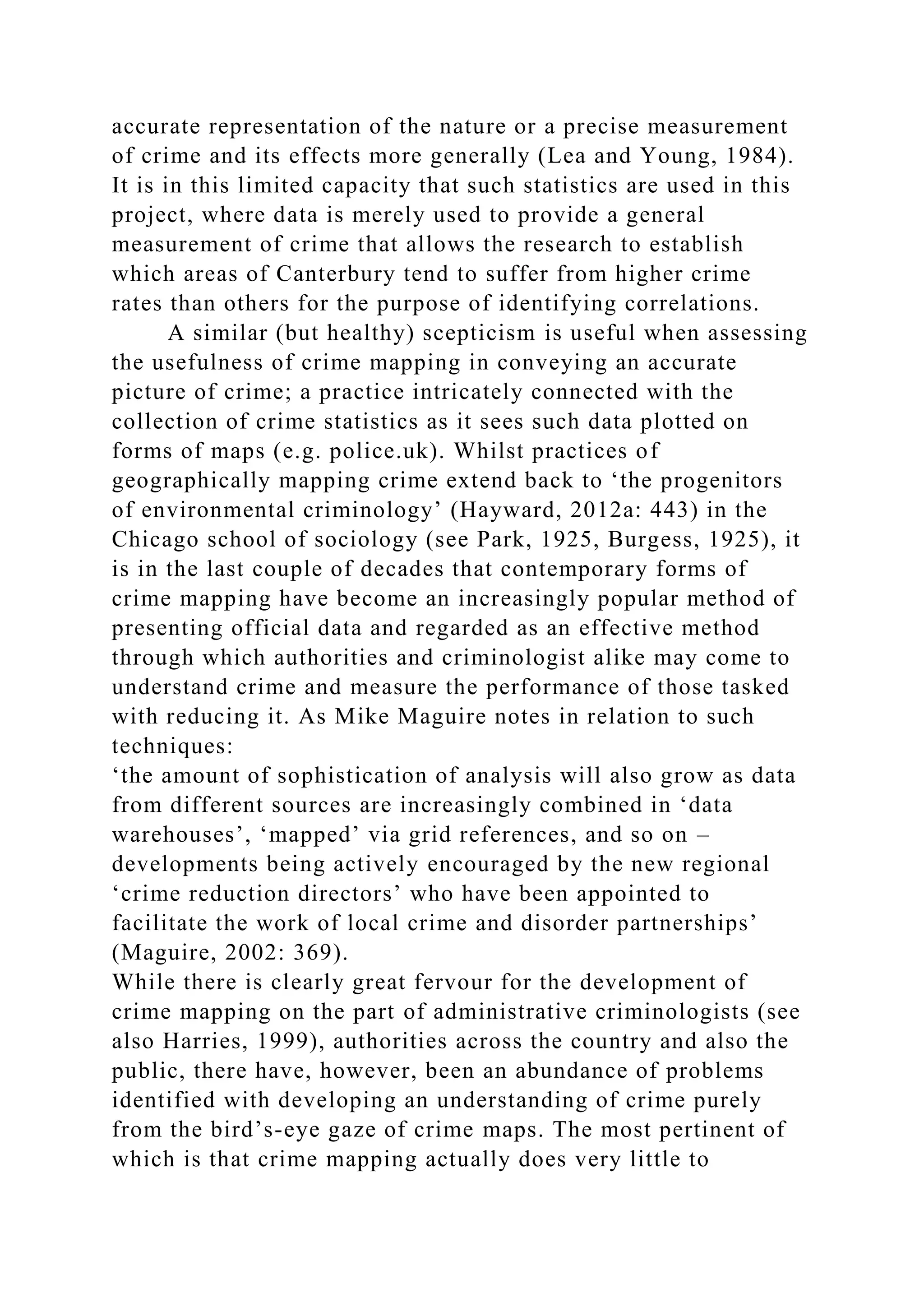


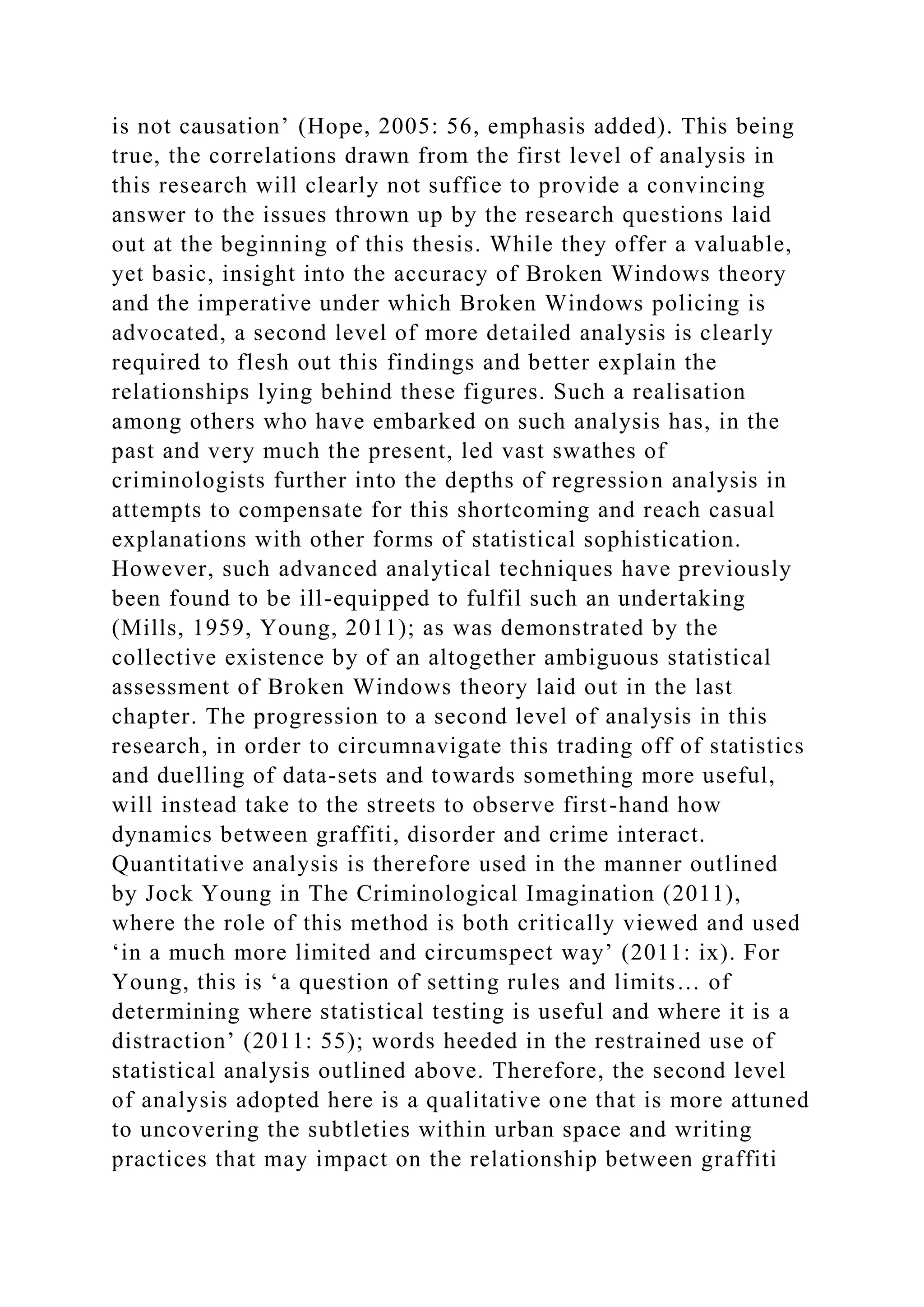
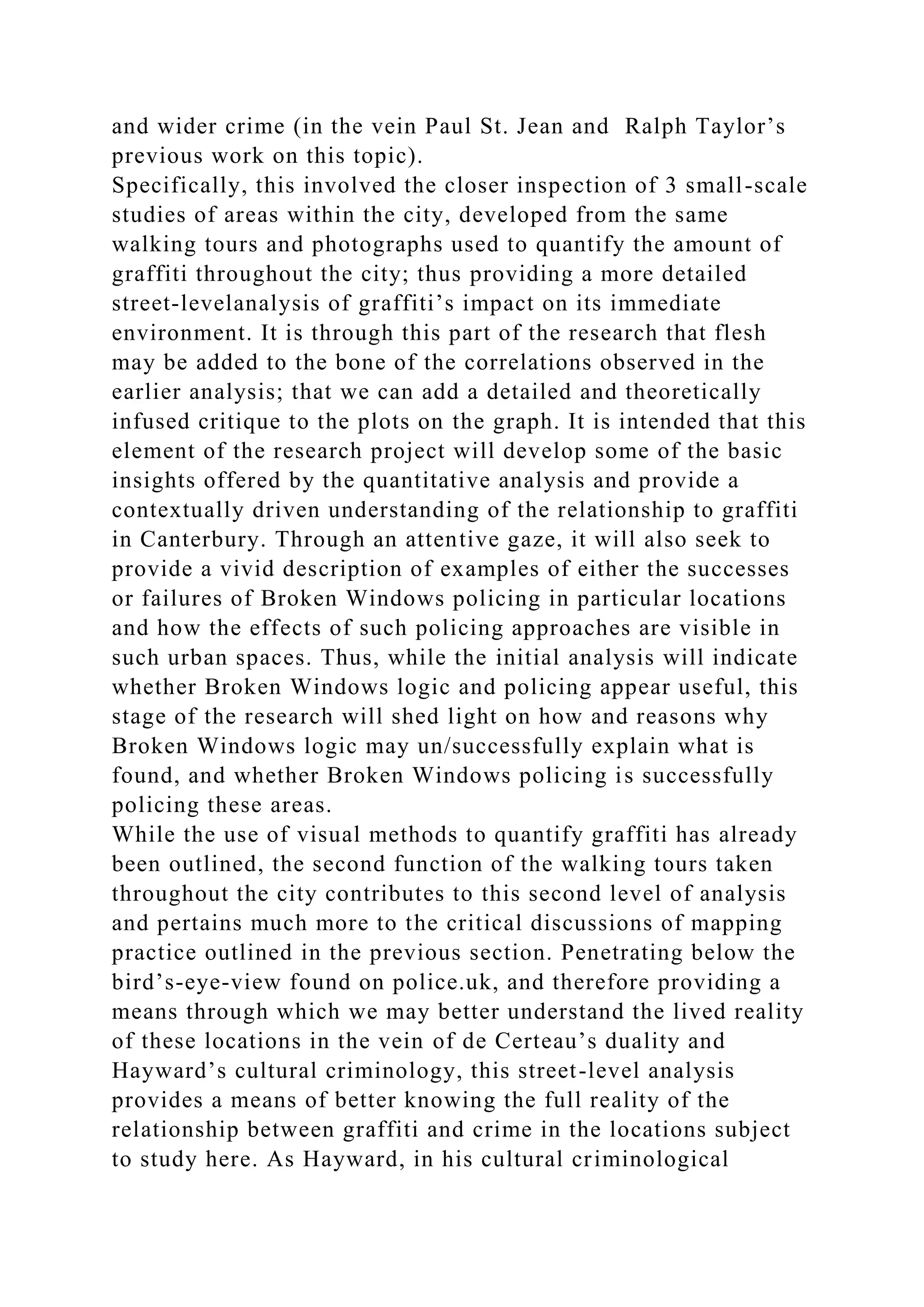
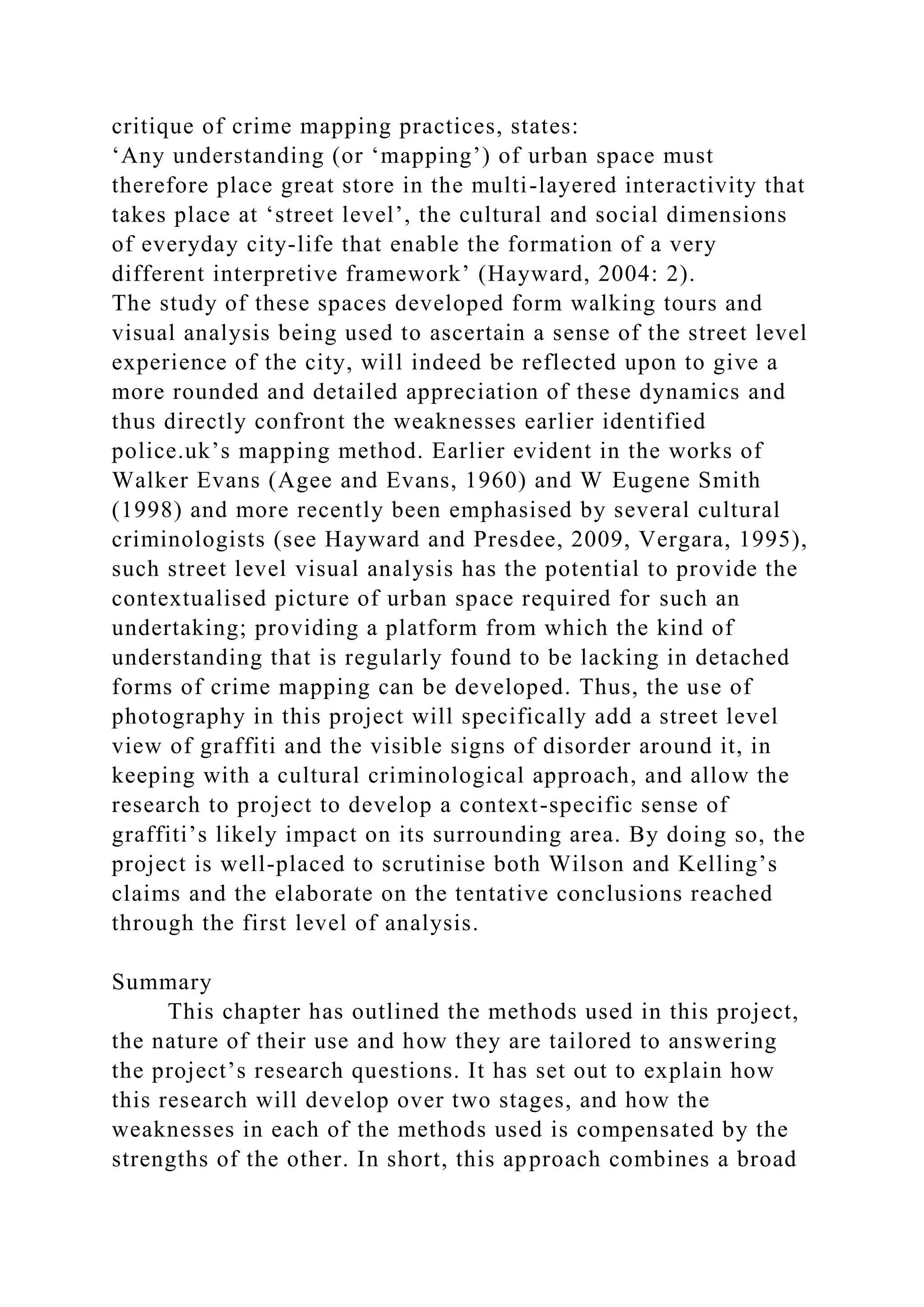
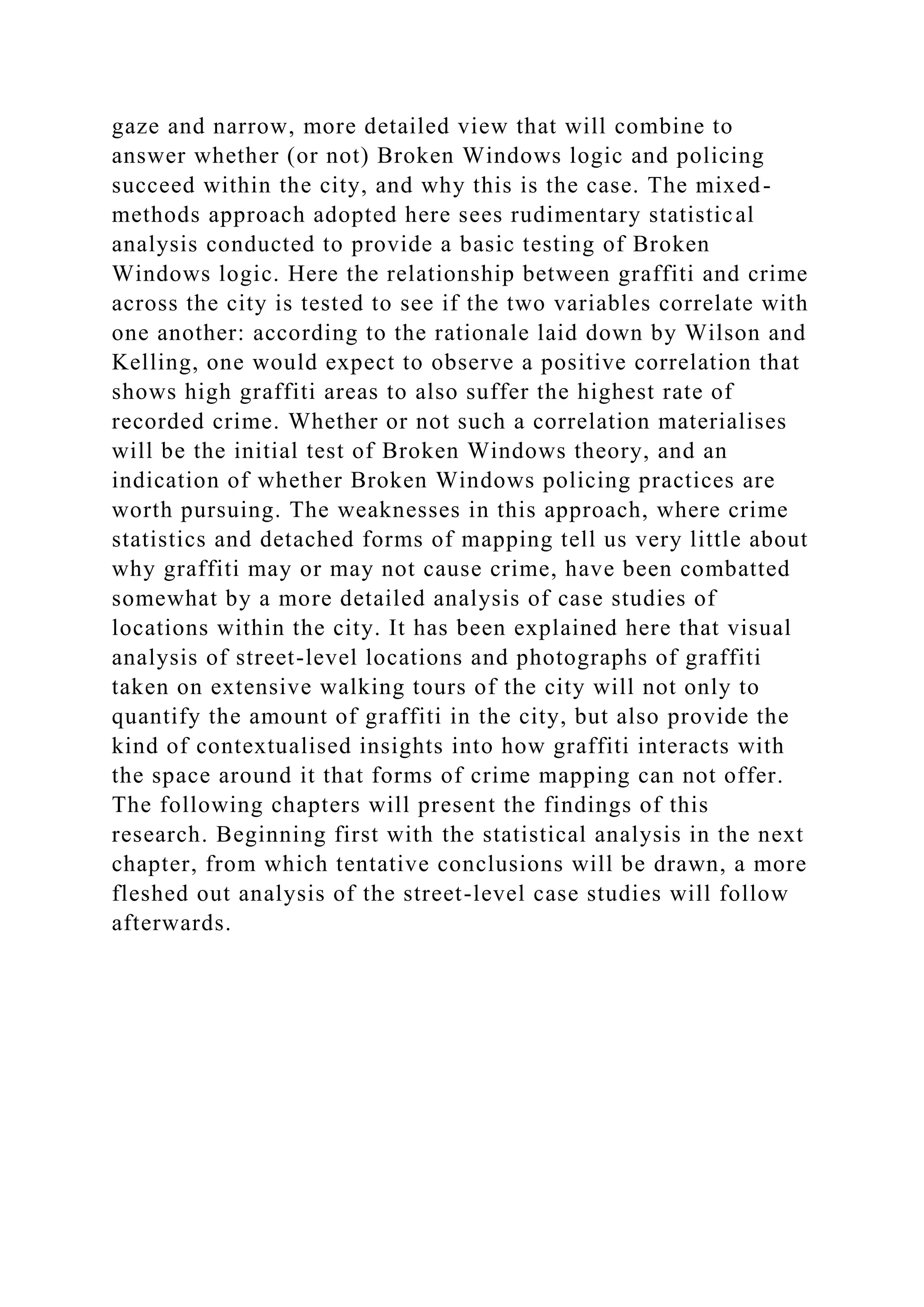
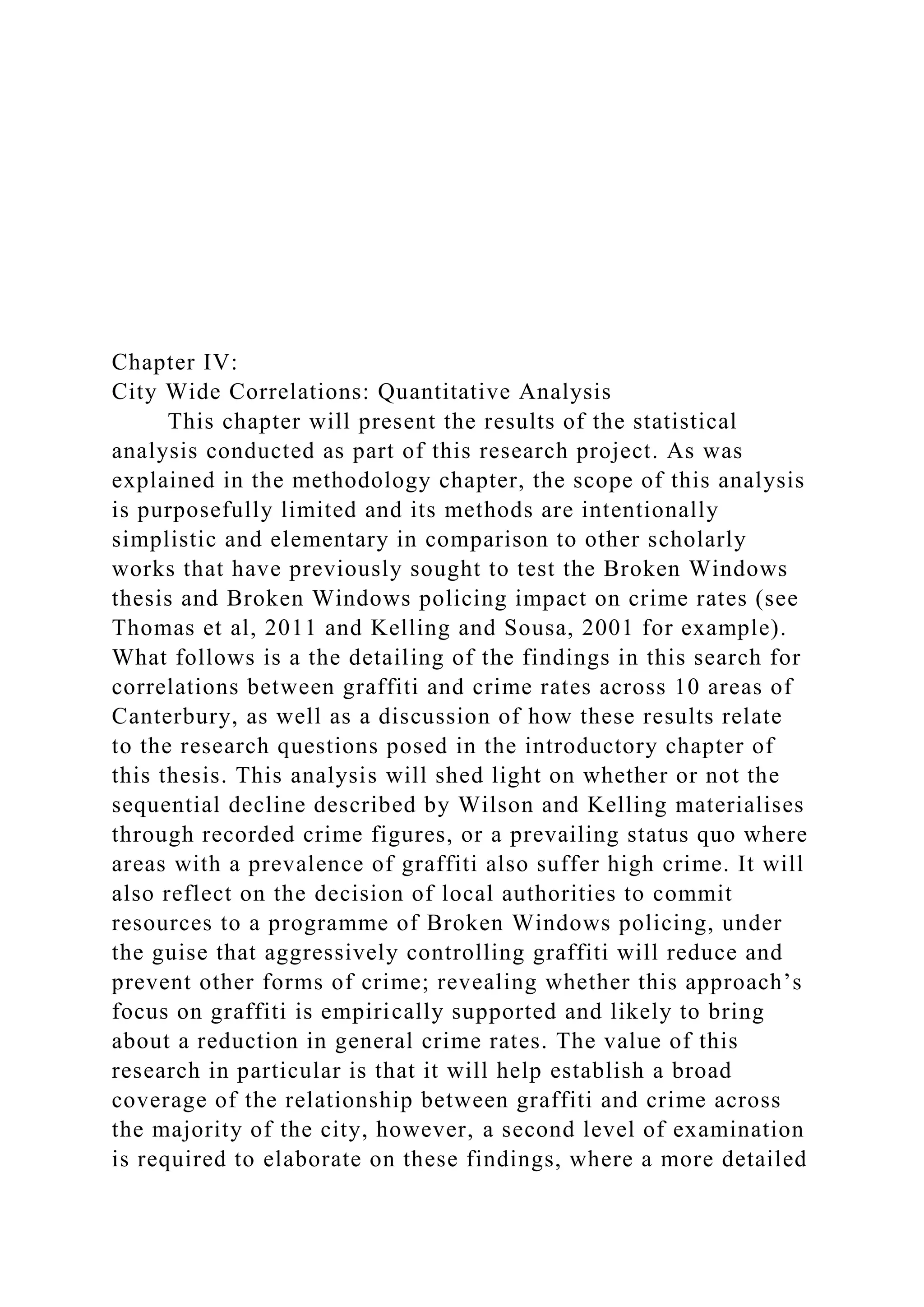

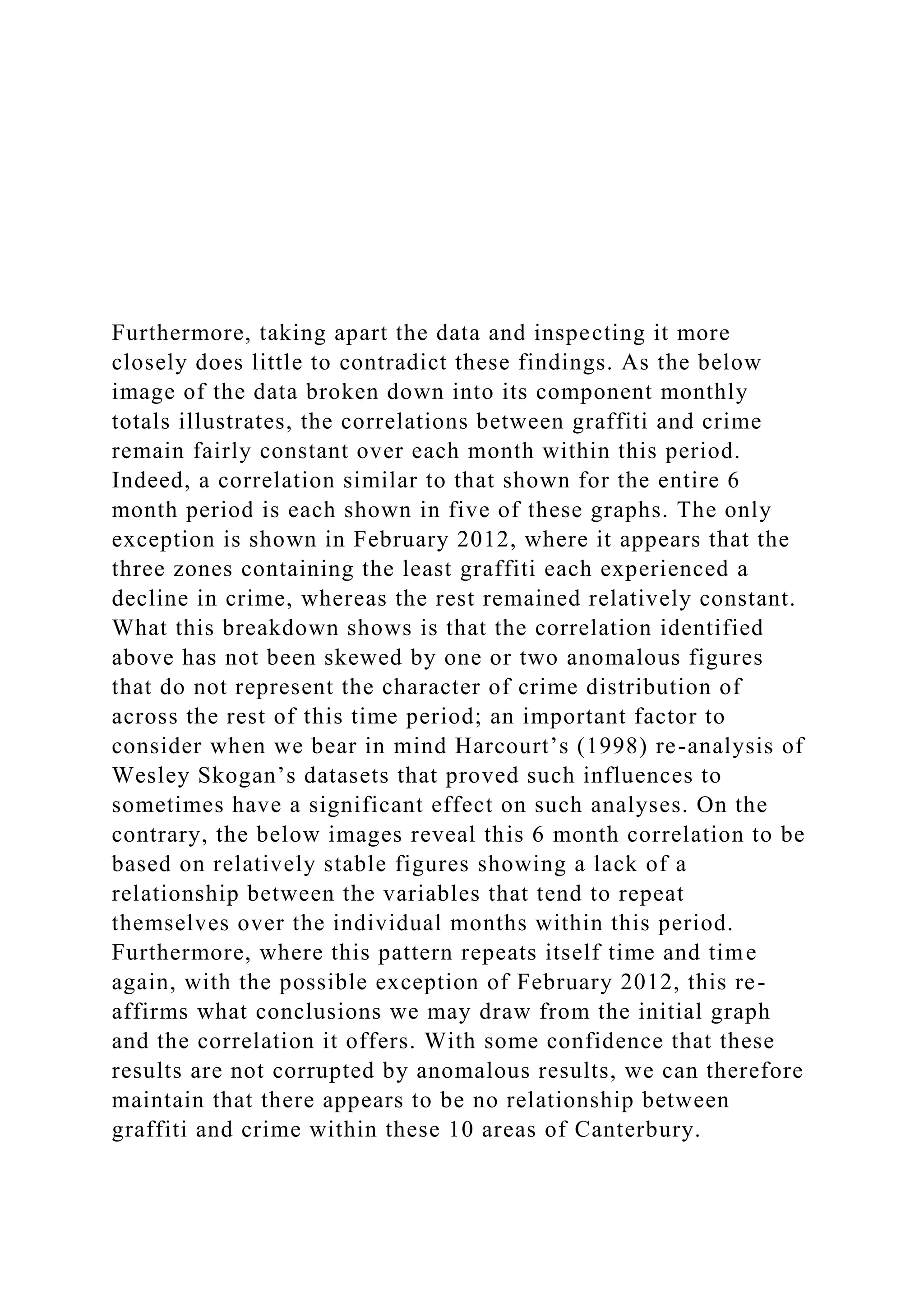
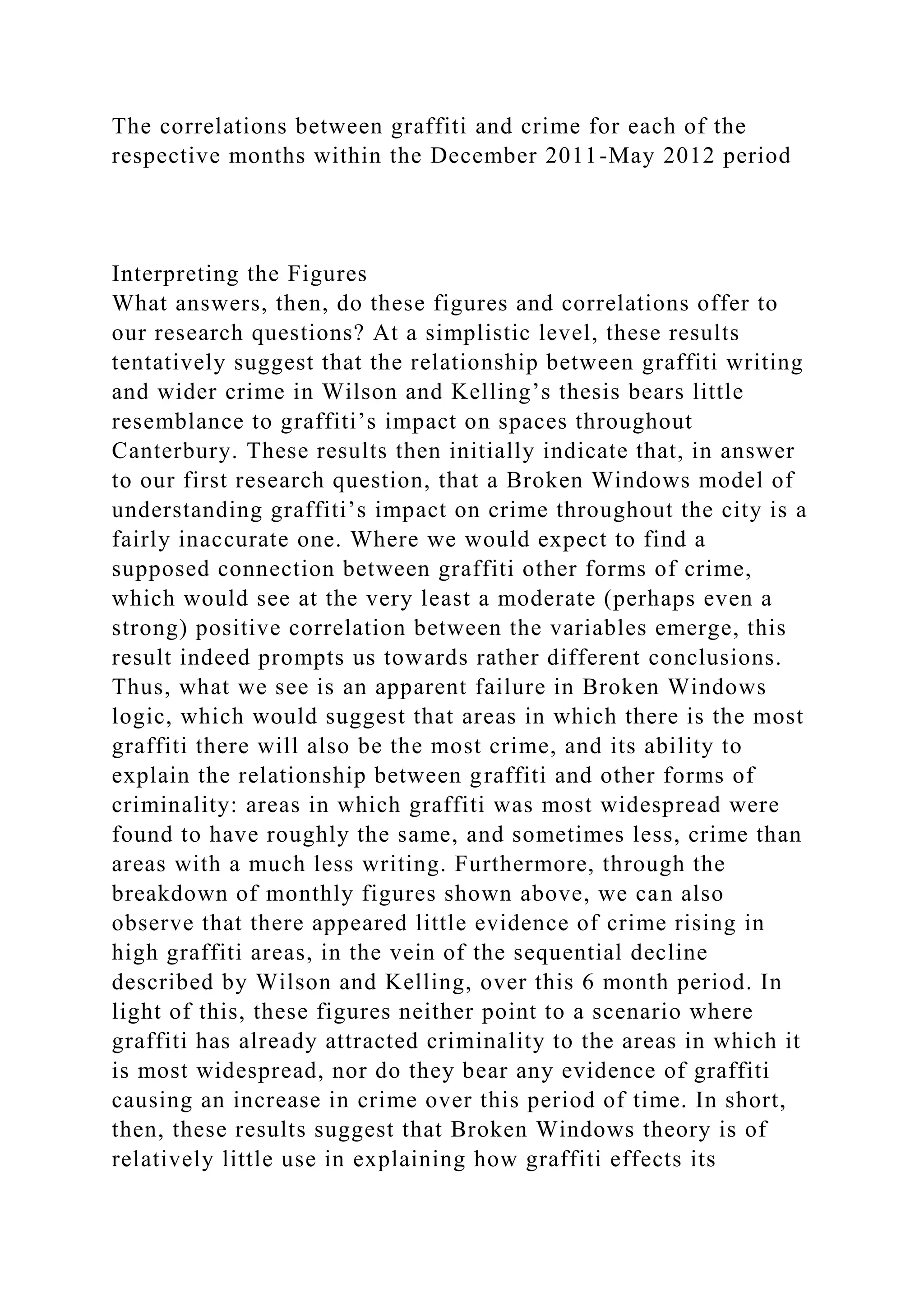
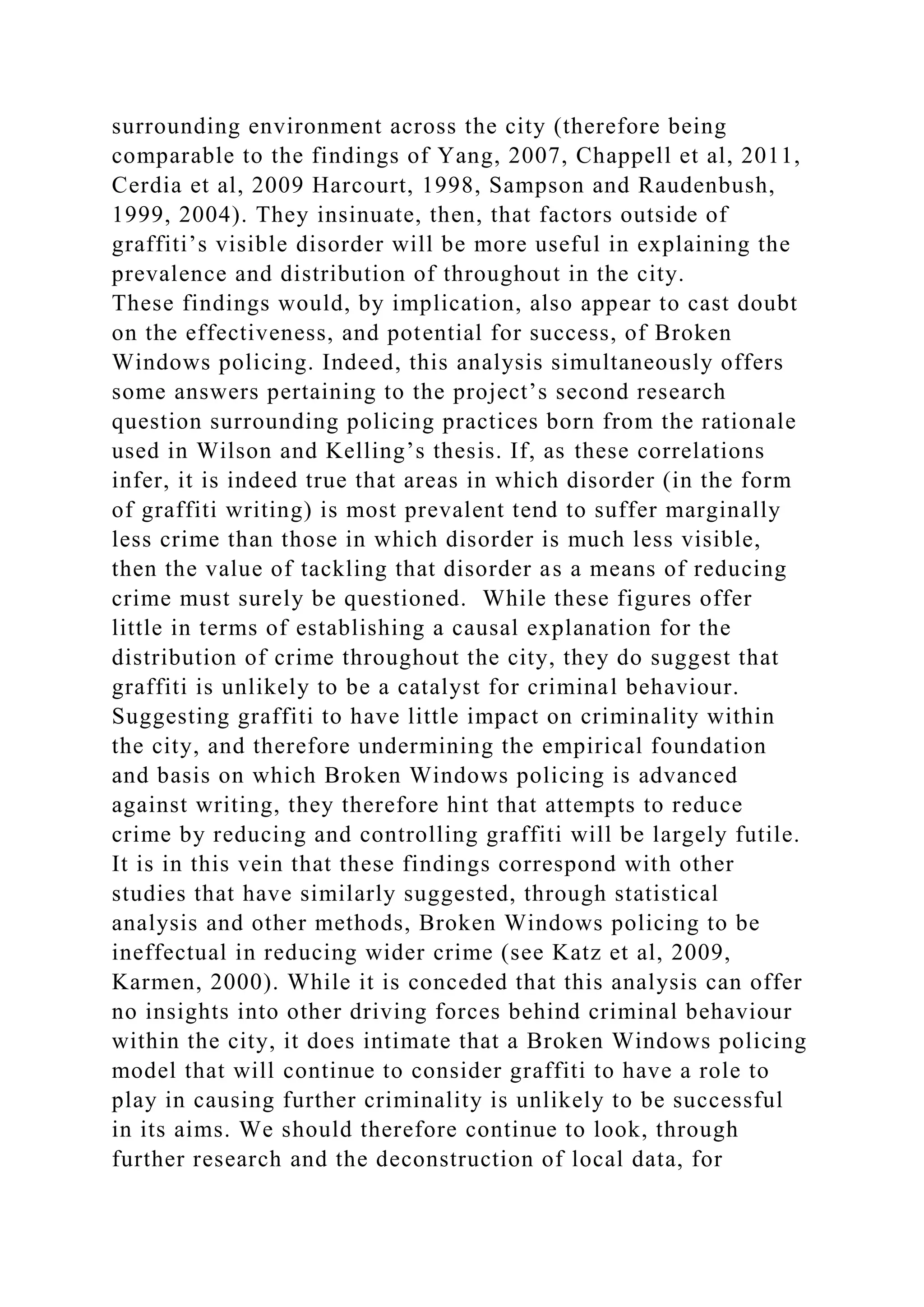
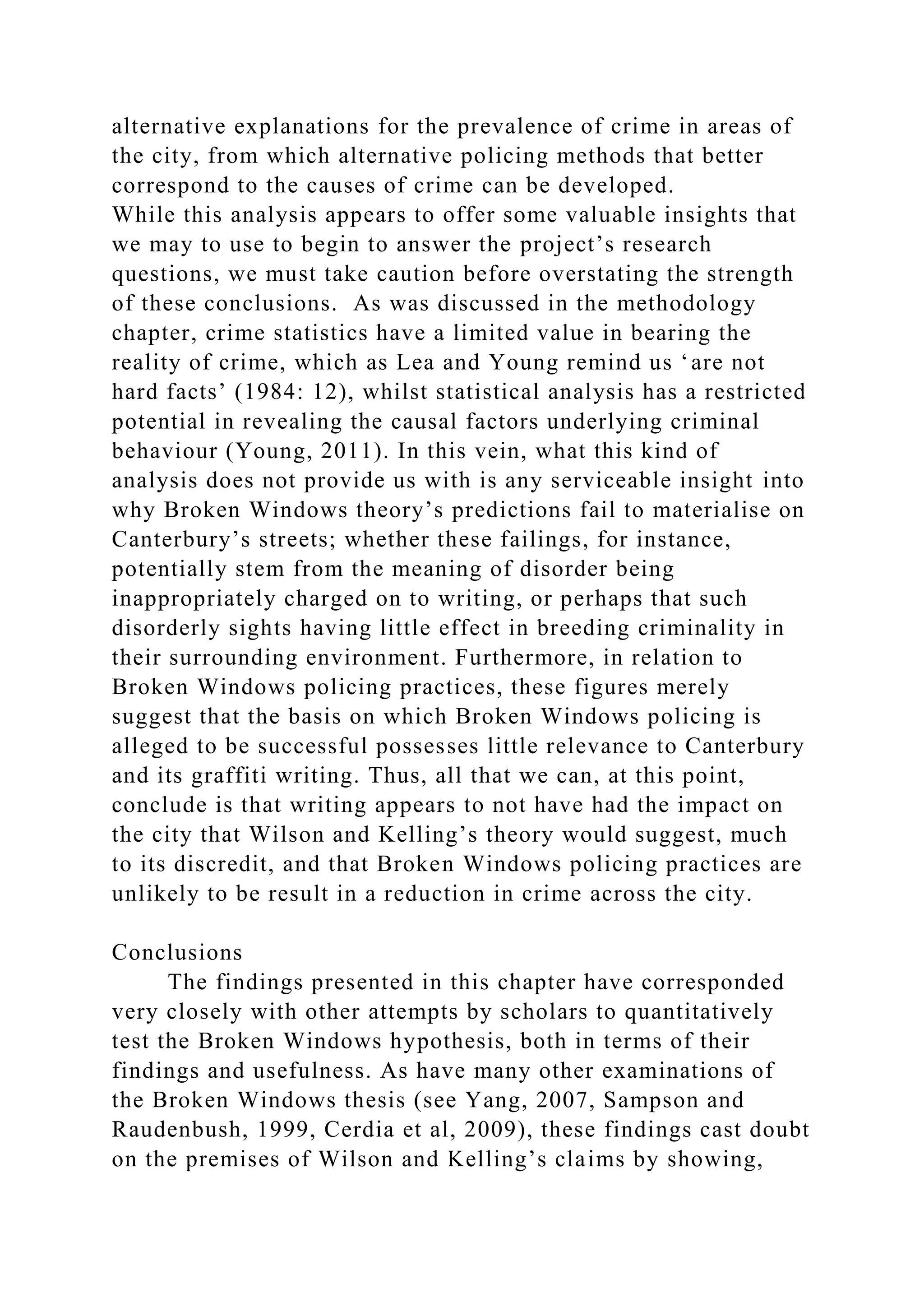

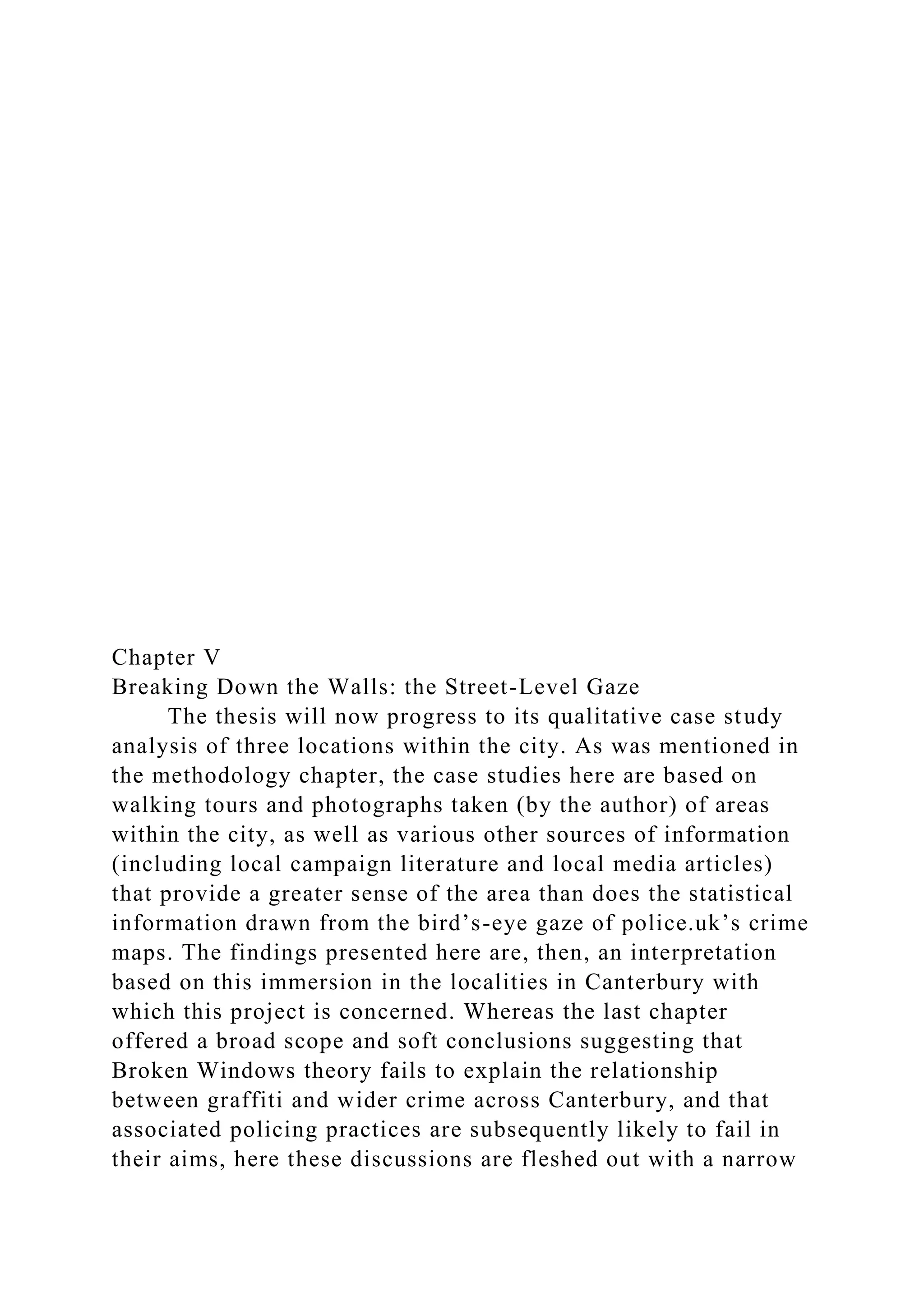
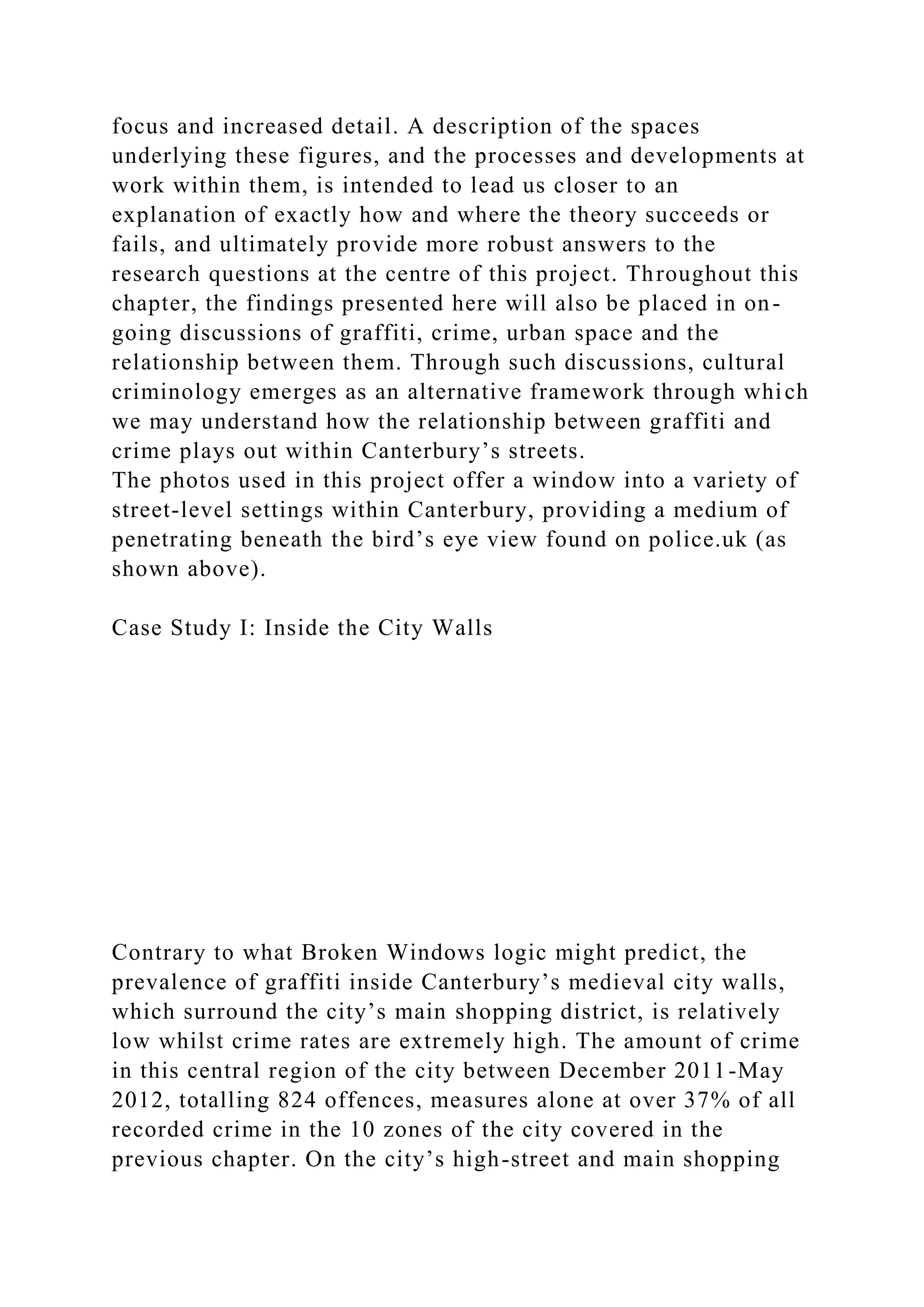
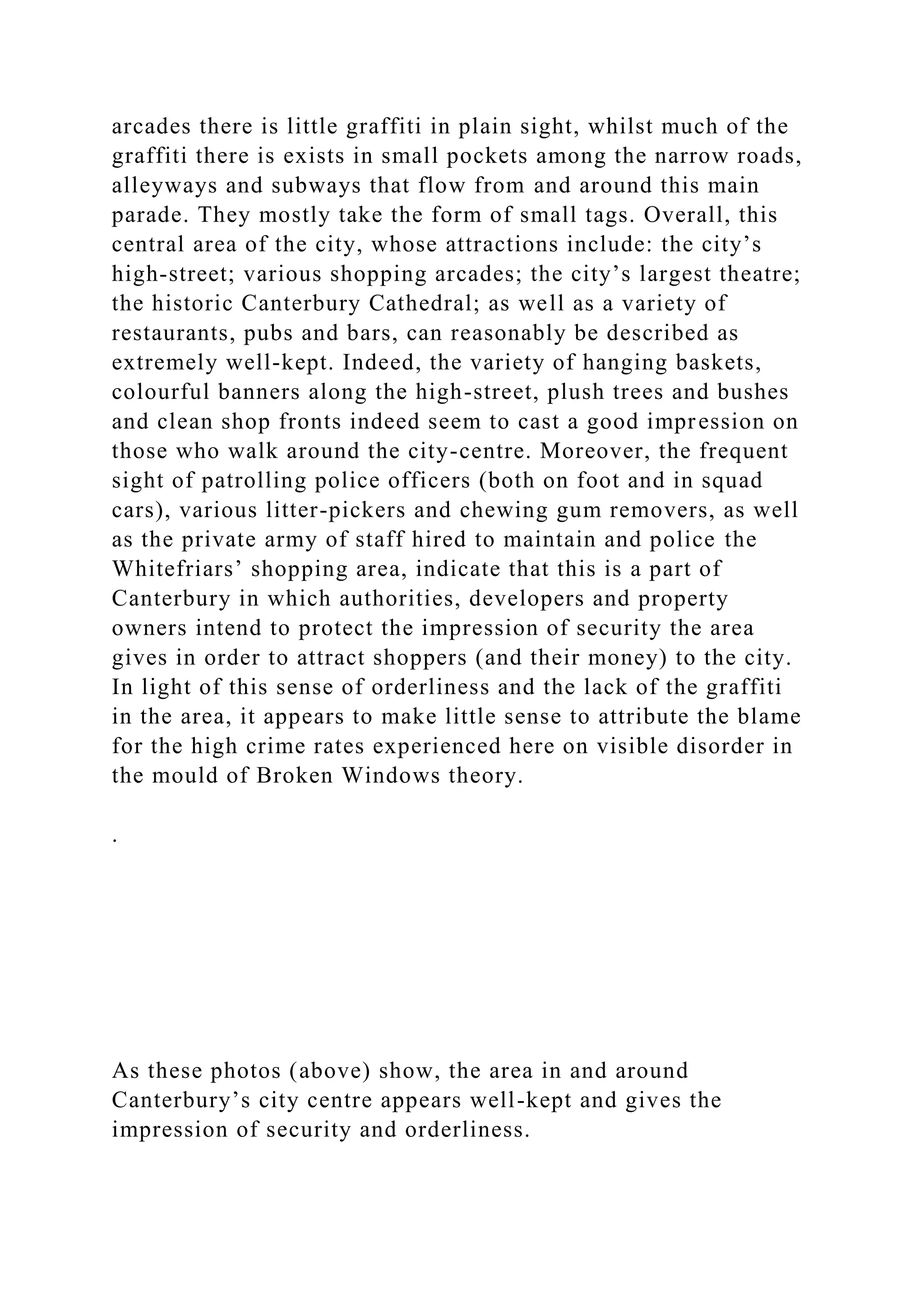
![This description, however, only applies to Canterbury city-
centre as a day-time hive of shopping, consumption and
relaxation, whereas we must look to the use of this same space
at night in order to explain why the city-centre boasts such high
figures of recorded crime. At night, other sources of revenue
and forms of consumption tend to occupy these same streets and
transform the city into a somewhat different place: a tale that is
told both through recorded crime figures and walks through the
city on busy evenings. Like many so-called ‘beer towns’ across
the UK (Hobbs et al, 2005), in which the night-time industry
‘spawns criminal violence at every turn’ (Ferrell et al, 2008:
204), much of Canterbury’s local economy runs on night-time
consumption of alcohol, in turn, apparently suffers from a high
amount of crime committed by night-time drinkers. In light of
this, it appears more appropriate to characterise the city’s night-
time economy as the catalyst for acts of criminality, rather than
visible signs of disorder (as Broken Windows theory would
suggest)[footnoteRef:5]. As the figures on police.uk reveal,
much of the city-centre’s crime is, unsurprisingly, clustered
around the town’s most popular drinking spots; further
compounding suggestions that it is indeed the city’s night-time
industry that lies at the heart of much of the area’s crime.
Furthermore, police.uk is able to reveal that the types of crime
committed in this area are largely consistent with those
associated with night-time economies by existing literature (see
Winlow and Hall, 2006, Hobbs et al, 2005). Take, for instance,
the area around the Cherry Tree pub in the month of May 2012
which illustrates such dynamics: of the 18 crimes committed in
the nearby area that month, the variety of anti-social, violent,
drugs and public disorder offences do just this, and indeed
present just one piece of a wider jigsaw of similar locations
throughout the city-centre that provide an illustration of the
same dynamics. [5: Another explanation for the high rates of
crime in this area, though one that appears less influential than
night-time drinking, is day-time shoplifting. Given the wide
array of shops in the city centre, opportunities for shoplifting](https://image.slidesharecdn.com/brokenwindowstheoryacademictheoryproposedbyjamesq-221031130150-b85cb06e/75/Broken-windows-theory-academic-theory-proposed-by-James-Q-Wilson-docx-64-2048.jpg)
![here obviously exceed those provided anywhere else in the city.
Thus, we should still take care not to claim that all crime in the
area is driven by the city’s night-time economy.]
Such findings, told through crime figures and first-hand
observation, raise issues of contention against those who
promote Broken Windows in the city, and accentuate how the
theory’s emphasis on visible disorder as a cause of criminal
behaviour fails to relate to particular urban environments.
Indeed, this example has shown how graffiti emerges as a non-
factor in explaining the prevalence of crime in this area. In
contrast it has been demonstrated that the city’s night-time
economy, alongside the kind of shoplifting crimes that are an
inevitability in such shopping spaces, rather than visible
disorder, emerges as a more reasonable explanation for the
extremely pronounced recorded crime figures inside the city
walls. Ill-equipped to consider the often parafunctional nature
of urban space (Hayward, 2012a), what is revealed through this
example is that Broken Windows’ lack of reflexivity means that
the theory fails to account for how Canterbury’s city-centre can
both resemble a secure shopper’s paradise and one of the
‘brutal, instrumental urban site of alcohol-driven excess and
violence’ (Ferrell et al, 2008: 106) located in and around the
country. Thus, in order to explain crime in this area it is appears
necessary to turn to alternative bodies of work, some of which
include: cultural criminological literature on the multiple uses
of urban space (see Hayward, 2012a); studies of behaviour
amidst hedonistic night-time consumption of alcohol and illicit
drugs providing a greater understanding of how, why and when
crime will be committed in such environments (see Hobbs et al,
2005); as well as cultural criminology’s appreciation of the
social, economic and cultural conditions that makes such
pursuits popular (see Presdee, 1999), to provide a more relevant
wisdom for accounting for crime in this area. Thus this case
study, in answer to our first question, demonstrates how Broken
Windows logic fails to account for the causes of crime in this](https://image.slidesharecdn.com/brokenwindowstheoryacademictheoryproposedbyjamesq-221031130150-b85cb06e/75/Broken-windows-theory-academic-theory-proposed-by-James-Q-Wilson-docx-65-2048.jpg)
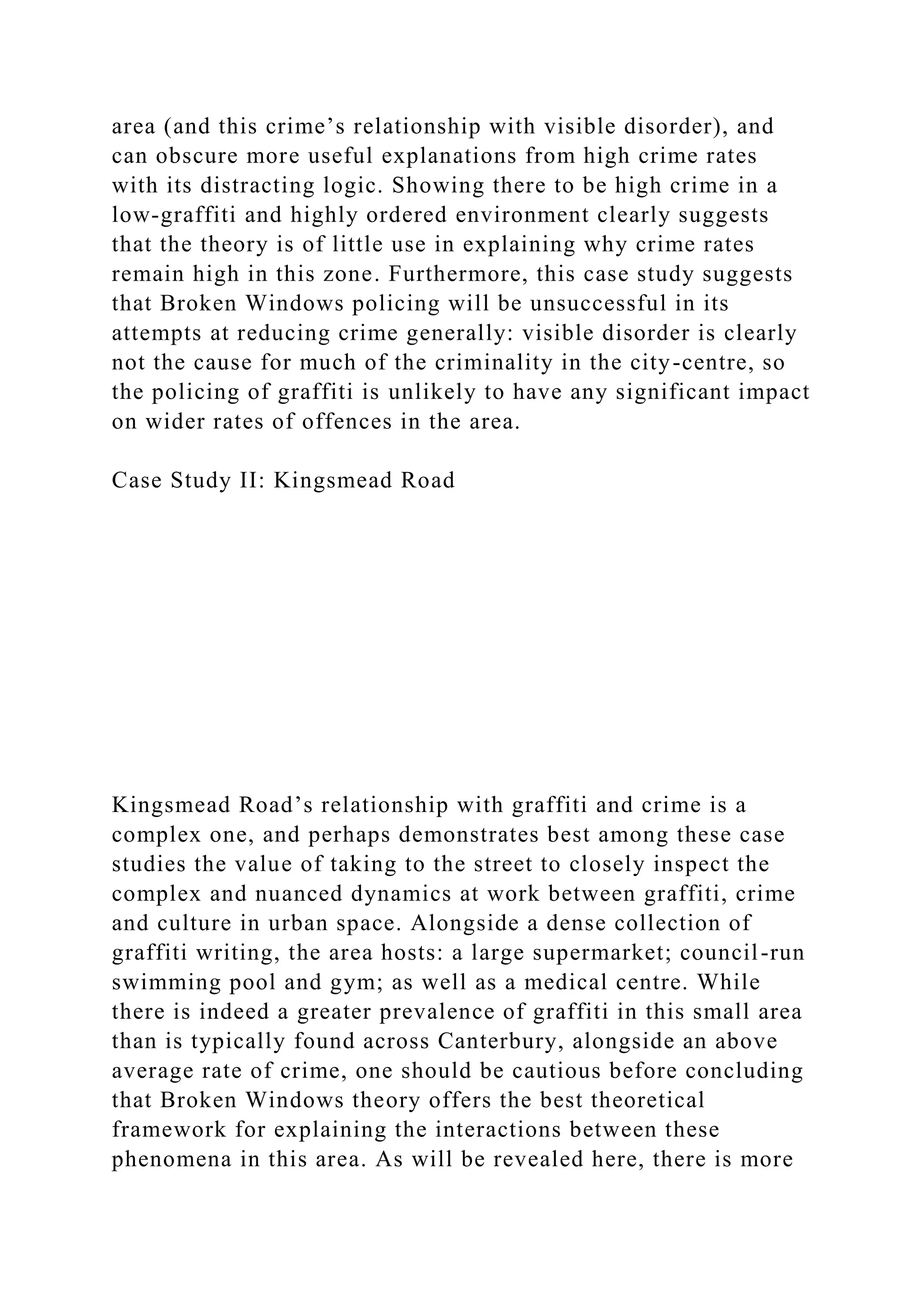
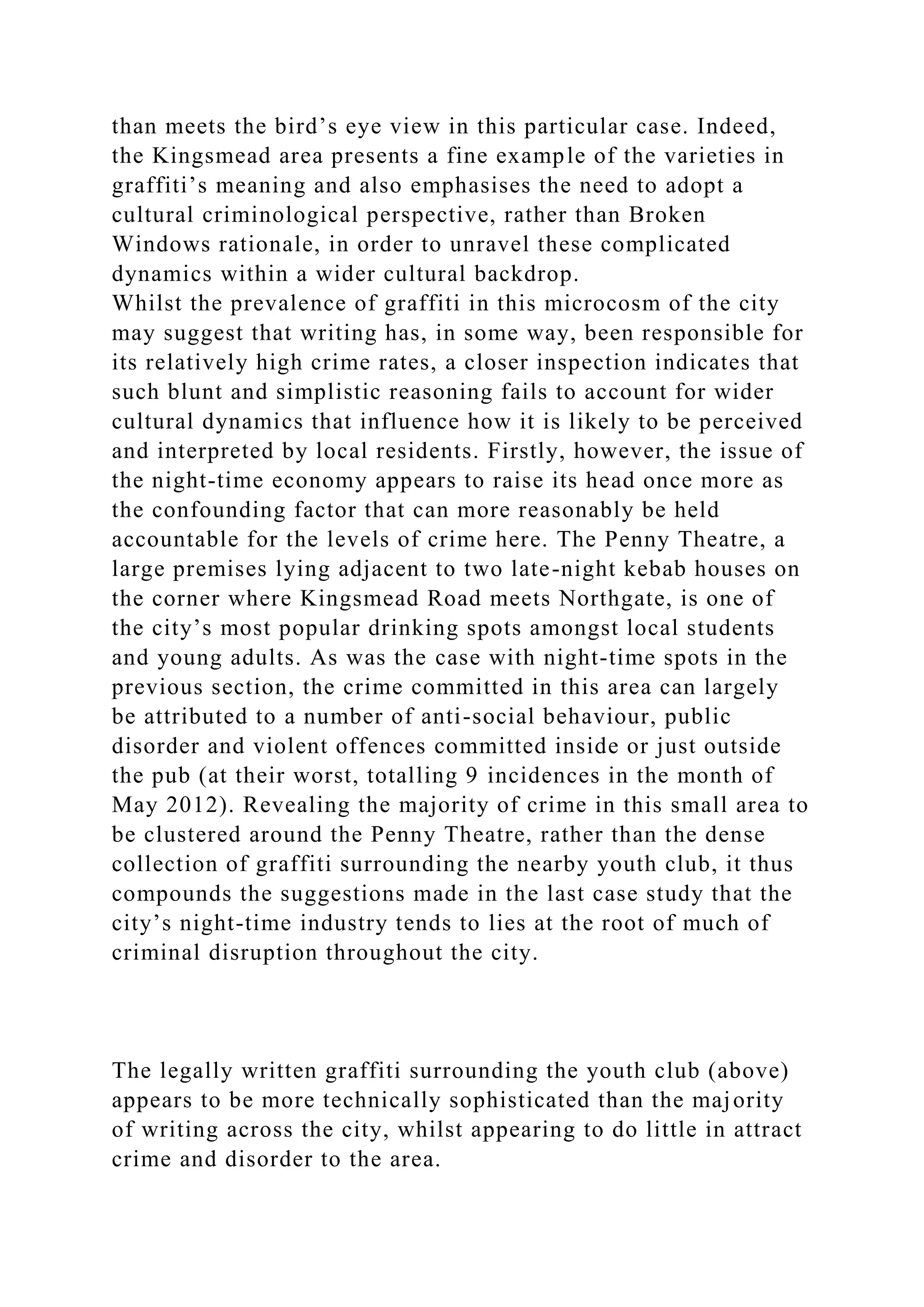
![The Riverside Youth Centre, on Kingsmead Road, alternatively
brings to the fore some of the complications intricately tied into
graffiti’s contemporary cultural meaning, and simultaneously
throws another spanner in the works of Broken Windows’
portrayal of graffiti acting as a bearer of bad news. Indeed,
contrary to such an interpretation of graffiti’s meaning, the
writing that decorates the wall of the buildings appears to
function as a symbol of inclusion (an invitation for young
people to enter the club) and as a celebration of graffiti within
mainstream youth culture. At the manager’s request, local
writers were invited to write on the walls of the club and
subsequently created a variety of colourful murals and pieces
along the front of the main building’s walls and also the on-site
five-a-side football pitch[footnoteRef:6] (see Tandasatu,
2/4/2010, for a video of this process). That those running this
youth club, funded by the local council, saw fit to have it
decorated with graffiti, speaks volumes about: the way graffiti
is valued within the current cultural context; the alternative
meanings that different parts of the local population attach to
different examples of writing; and the distinctions
criminologists accordingly need to make between different
varieties of graffiti. In particular, the painting of the youth club
corresponds with wider developments identified by cultural
criminologists; where it has been noted that graffiti, amongst
other crimes, has been ‘packaged and marketed to young people
as a romantic, exciting, cool and fashionable cultural symbol’
by a number of industries. Keith Hayward explains, ‘it is in this
cultural context that transgression becomes a desirable
consumer choice. Within consumer culture, crime is being
aestheticised and stylised, presented in the mass media as on a
par with a fashion aesthetic’ (both quotes from Hayward, 2004:
169). Driven by representations in commercial advertising and
the use of graffiti’s style in many commodities themselves,
through this process, graffiti has evolved from a feature of
counter-culture to become part of the mainstream. As a result,](https://image.slidesharecdn.com/brokenwindowstheoryacademictheoryproposedbyjamesq-221031130150-b85cb06e/75/Broken-windows-theory-academic-theory-proposed-by-James-Q-Wilson-docx-68-2048.jpg)
![graffiti, its visual style and emotional sensations of
transgression are now ‘celebrate[d] and very importantly,
commodif[ied]’ (Hayward, 2004: 173) by industries selling
products to youth markets. Recent examples of this are beyond
counting; however they include the use of graffiti within adverts
for Adidas clothes and Converse trainers; the use of graffiti (or
graffiti’s style) as an advertising medium itself; fashion items
that themselves adopt graffiti’s visual style; and even video
games (such as Mark Ecko’s ‘Getting Up’) and; now evidently
by youth clubs attempting to aesthetically express the style of
those who use the clubs and also to attract new members: [6:
However, some writing was not welcomed by those who run the
club (this mainly consists of a few tags that have been peppered
around the club’s walls and also some large containers near the
building)]
‘Graffiti style has also gone mainstream; as graffiti has become
the lingua franca of hip, artistic rebellion has indeed turned into
big money… suggesting of course that whatever cultural
authenticity the law can’t kill, the market can’ (Ferrell et al,
2008: 151).
The appropriation of graffiti’s style and urban edginess has
been evident in graffiti-based products: such as Marc Ecko’s
Getting Up Video Game (above left); the use of graffiti
writing’s transgressive sensations in Adidas advertising
campaigns (above centre), and the use of graffiti aesthetic for
adverts by Sony (above right).
Once we contextualise the graffiti surrounding the Riverside
Youth Centre in these cultural processes, it quickly becomes
clear that Wilson and Kelling’s blunt understanding of graffiti
as a symbol of disorder is both ignorant to these cultural shifts
and unable to accurately characterise this graffiti’s meaning to
nearby urban audiences. While perhaps the tag continues to](https://image.slidesharecdn.com/brokenwindowstheoryacademictheoryproposedbyjamesq-221031130150-b85cb06e/75/Broken-windows-theory-academic-theory-proposed-by-James-Q-Wilson-docx-69-2048.jpg)
![represent senseless vandalism to some (Ferrell et al, 2008: 101),
the murals decorating the youth club appear to represent
something rather different. Indeed, this case study has
specifically shown that, within this evolving and mutating
cultural context, the youth club’s use of graffiti signals to the
community that this is a space for young people and to signal to
young people themselves that this is a cool and fun place to be.
In doing so, it also relates to wider examples of the
appropriation of graffiti to attract people to an area: for
example, Snyder’s finding that certain shopkeepers in areas of
New York encouraged graffiti writing inside their stores in
order to ‘tell shoppers that this is a cool space’, and
demonstrate graffiti is indeed ‘good for business’ (2009: 53).
This case study thus demonstrates the value of cultural
criminology’s culturally aware and interpretive approach to
graffiti writing in comparison to Broken Windows blunt and
unwavering characterisation of graffiti as a sign of disorder.
Whereas a static Broken Windows logic leads us to assume that
the Riverside Youth Club’s graffiti might inspire crime, a
reflexive cultural criminological approach sees the lack of
crime around the club better explained through the ‘plac[ing of]
criminality and its control in the context of culture’
(culturalcriminology.org, 2012); in this case meaning situating
Kingsmead’s graffiti within writing’s journey into mainstream
youth culture. Suggesting, therefore, that understandings of
graffiti as a sign of disorder, in Broken Windows arguments,
remain too rigid in light of graffiti’s use as a sign of urban cool
to young audiences, the graffiti on the Riverside Youth Club
reminds us that criminologists must remain attentive to the
diverse and ever-changing meanings that writing can hold and
the distinctions between different variations of writing. This
case study then, pertaining to the first of our research questions,
shows Broken Windows theory spectacularly failing to explain
graffiti writing’s impact on its environment through wildly
misinterpreting what writing means to particular urban
audiences. Moreover, it then implies that Broken Windows](https://image.slidesharecdn.com/brokenwindowstheoryacademictheoryproposedbyjamesq-221031130150-b85cb06e/75/Broken-windows-theory-academic-theory-proposed-by-James-Q-Wilson-docx-70-2048.jpg)
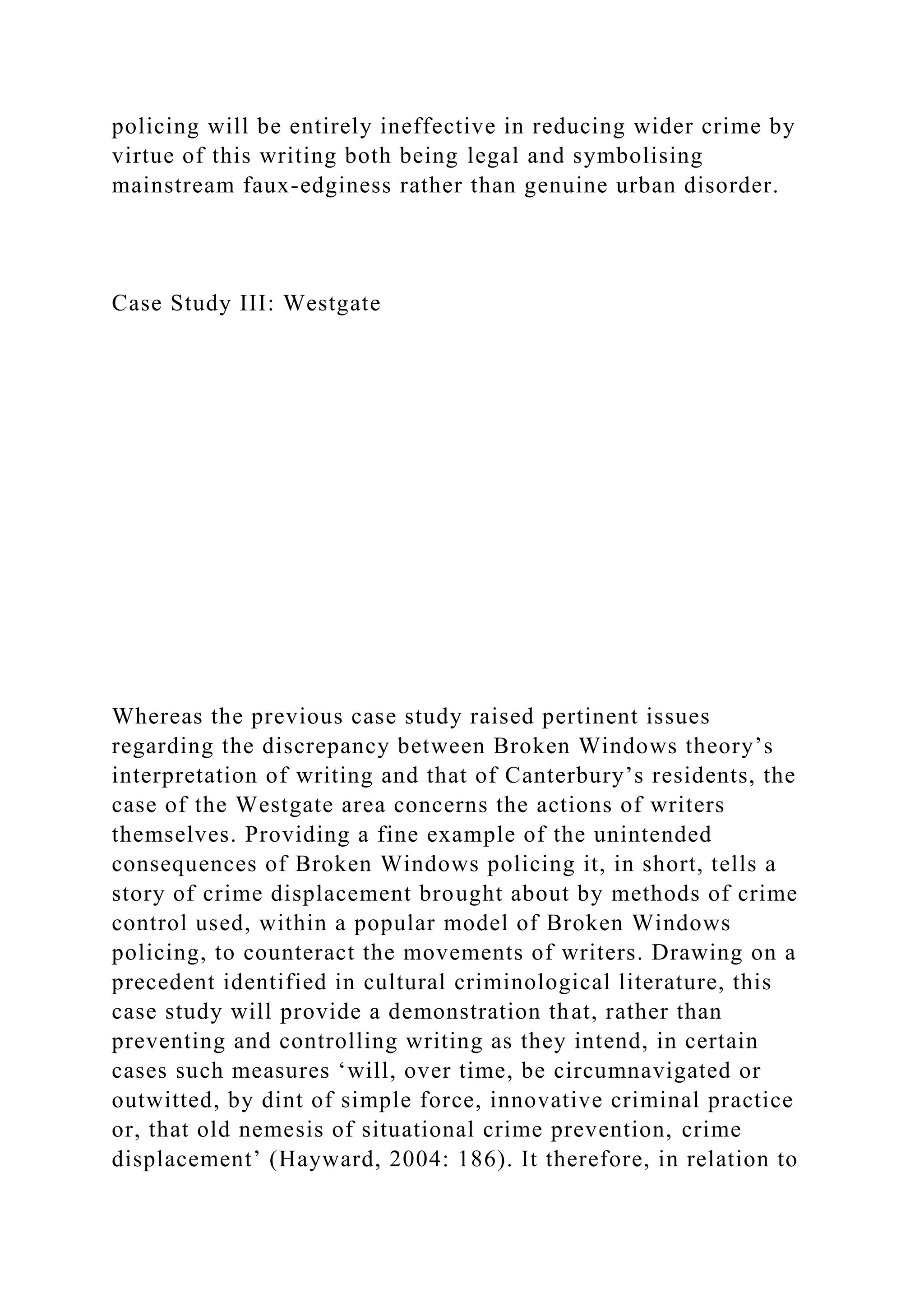
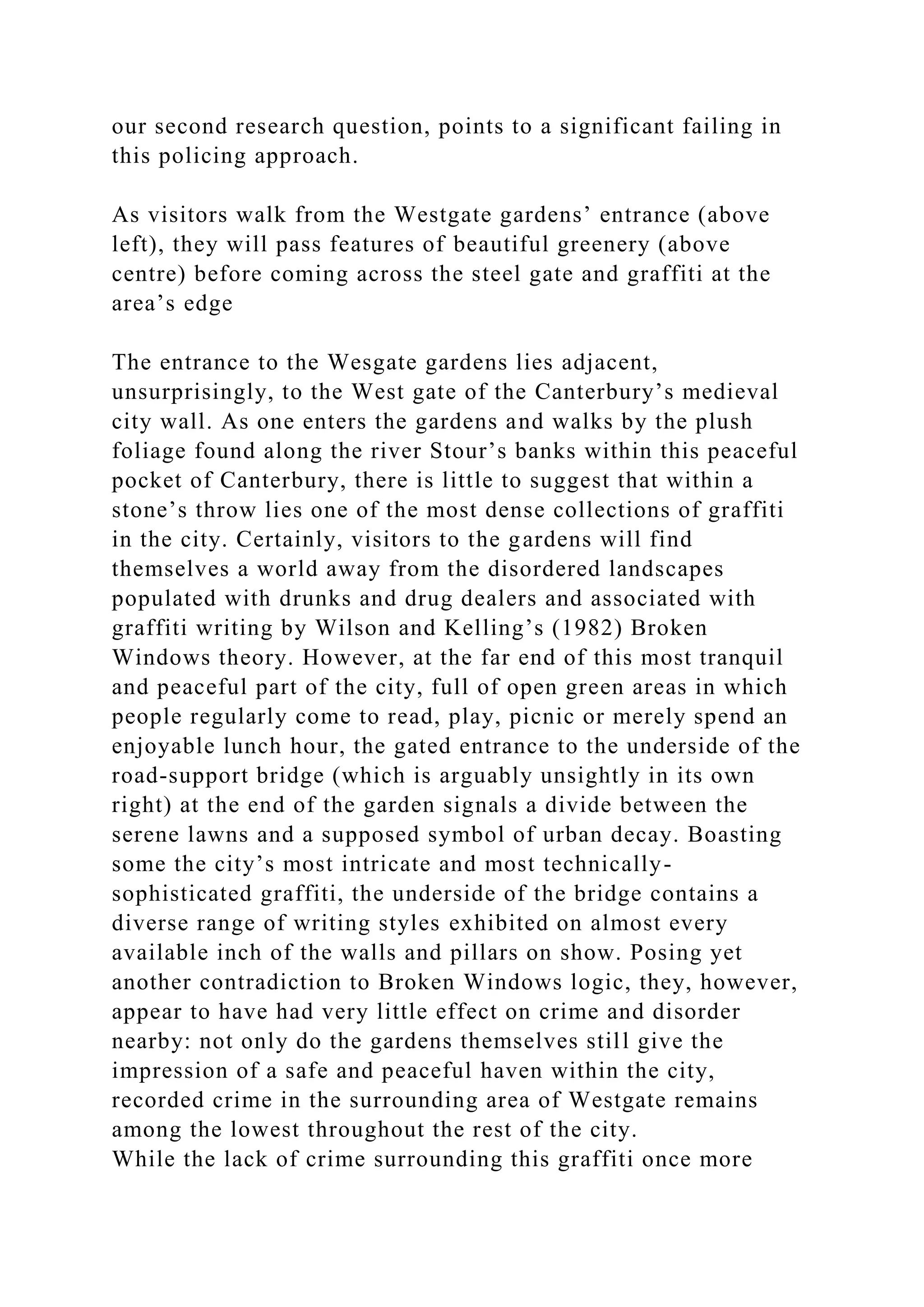
![undermines the premises of Wilson and Kelling’s theory, more
significantly, the appearance of writing in such a location points
to failings in a Broken Windows policing method of crime
control. Indeed, the location of the vibrant collection of murals,
pieces and tags found here corresponds very closely with
discussions of the displacement of writing identified in other
cities by Snyder (2006, 2009) and Ferrell (1996, 1998), among
others (Hayward, 2004, 2007), and in doing so offers another
contradiction to Broken Windows logic. As has been
acknowledged by cultural criminological scholars, displacement
has been identified as a regular consequence of situational
approaches to crime control (Hayward, 2007), many of which
tend to be included in models of Broken Windows policing
(Manning, 2001, McLaughlin, 2008a). Specifically towards
graffiti in Canterbury these have included: the swift removal of
graffiti; the use of anti-graffiti paint to coat surfaces; a variety
of surveillance techniques including CCTV (Canterbury City
Council, 2012a); on the spot fines for those caught writing
(Warren, 23/8/2012); and the frequent prosecution of writers
(Claridge and Alston, 18/2/2010). The result, as has been shown
in many cases, is that graffiti tends to merely be moved to
obscure and less-visible locations rather than prevented or
reduced; to locations where writers can avoid surveillance and
develop sophisticated and time-consuming pieces of writing
without fear of punishment[footnoteRef:7]. What is found in the
Westgate gardens serves as an example of these very processes
playing out in Canterbury’s urban landscape: where the city
centre and other areas of the city are subject to this policing,
the edge of the garden offers the kind of unsurveilled location
that writers have elsewhere been increasingly shown to favour
(see Ferrell, 1996). Furthermore, evidence of this displacement
effect is also evident across other areas of the city in which
writing is found where much writing is now found in hidden
pockets of the city landscape. Much like Jeff Ferrell found that
writers in Denver ‘were pushed into real obscure places where’
and left ‘basically… painting for other writers and puttin’ up](https://image.slidesharecdn.com/brokenwindowstheoryacademictheoryproposedbyjamesq-221031130150-b85cb06e/75/Broken-windows-theory-academic-theory-proposed-by-James-Q-Wilson-docx-73-2048.jpg)
![wallpaper for winos and bums’ (Eye Six quoted in Ferrell, 1990:
11) by similar crackdowns on writing, in Canterbury it has been
subways frequently used by the city’s homeless for shelter and
begging that similarly offer some of the most dense collections
of graffiti in the area. As the Westgate gardens and several
other collections of writing located in hidden pockets of
Canterbury’s urban landscape then demonstrate, these dynamics
equally appear to be playing out in space across this small
Kentish city. [7: In other cases, such measures have also been
shown to frequently encourage writers for whom the main
motivation for writing is risk taking (see Ferrell, 1996, Snyder,
2009, Lyng, 2005, see also Katz, 1988) where, as Ferrell,
Hayward and Young put it, such measures have ‘ironically
accelerated graffiti’s experiential seductions’ (2008: 150) in the
past.]
The underside of the bridge (above) reveals one of the city’s
densest collection of graffiti, as well as some of the city’s most
technically-sophisticated pieces.
Displacement is evident across the city, both with writing
increasingly appearing to be hidden from view (above left),
whilst some writers appear to use the example of the Pacman
video game to taunt authorities’ inability to control their actions
(above right).
We must also consider, in order to fully comprehend the driving
forces lying behind these developments in writing, factors
external to the cat and mouse interplay between authorities and
writers that are driving such changes. The increasing
significance of photography to writing and writers that has seen
graffiti increasingly shared via graffiti-based media
publications, and more recently the internet, is relevant here.
This, it would seem as previously suggested by cultural
criminological scholars, has also accelerated the displacement](https://image.slidesharecdn.com/brokenwindowstheoryacademictheoryproposedbyjamesq-221031130150-b85cb06e/75/Broken-windows-theory-academic-theory-proposed-by-James-Q-Wilson-docx-74-2048.jpg)
![effect caused by Broken Windows policing (see Hayward, 2007,
2012) in many locations by leading many writers to prize
visibility gained through sharing digital photography above
being seen in their own cities . As Greg Snyder writes:
‘Photographs [make] ephemeral graffiti pieces permanent,
allowing writers to view the work of others without attachment
to a specific place or time. The inclusion of these ‘flicks’ in
magazines created a space where graffiti pieces from all over
the world could come together to be judged, critiqued, and
offered as instruction’ (Snyder, 2006: 93).
Not only does this apply to the magazine publications
mentioned by Snyder (such as Getting Up and ON the Go), but
also now internet forums and sites that bring together writers
from all parts of the globe (Mills, 2011). Where ‘the World
Wide Web has added another path to fame that doesn’t include
illegally saturating city walls with a name’ (Snyder, 2009: 35),
the need for writers to attain visibility in their own cities has
been superseded by recognition for quality of work among a
global network of peers, where graffiti is now mediated either
through print or virtual media (Snyder, 2006). This has resulted
in writers seeking out obscure locations to write, in which they
can produce better work, and contributed to the displacement of
writing in locations where techniques of Broken Windows
policing have been utilised. Evidence of this development’s
relevance to Canterbury’s writing scene can indeed be found
with a few clicks of a mouse, thus compounding these
suggestions that the internet and Broken Windows theory have
collectively driven graffiti writing to the margins of the city.
Aside from whatever content has been beamed into various
channels in multiple internet forums and millions of discussion
threads, these include videos showing examples of graffiti
around the city (see, Chapman-Jones, 2009, Soflesviolence,
2010) as well as a dedicated Canterbury Bombs website.
By looking to these cultural criminological analyses of graffiti
culture, ones that takes into account the unintended
consequences of Broken Windows policing and the role of new](https://image.slidesharecdn.com/brokenwindowstheoryacademictheoryproposedbyjamesq-221031130150-b85cb06e/75/Broken-windows-theory-academic-theory-proposed-by-James-Q-Wilson-docx-75-2048.jpg)
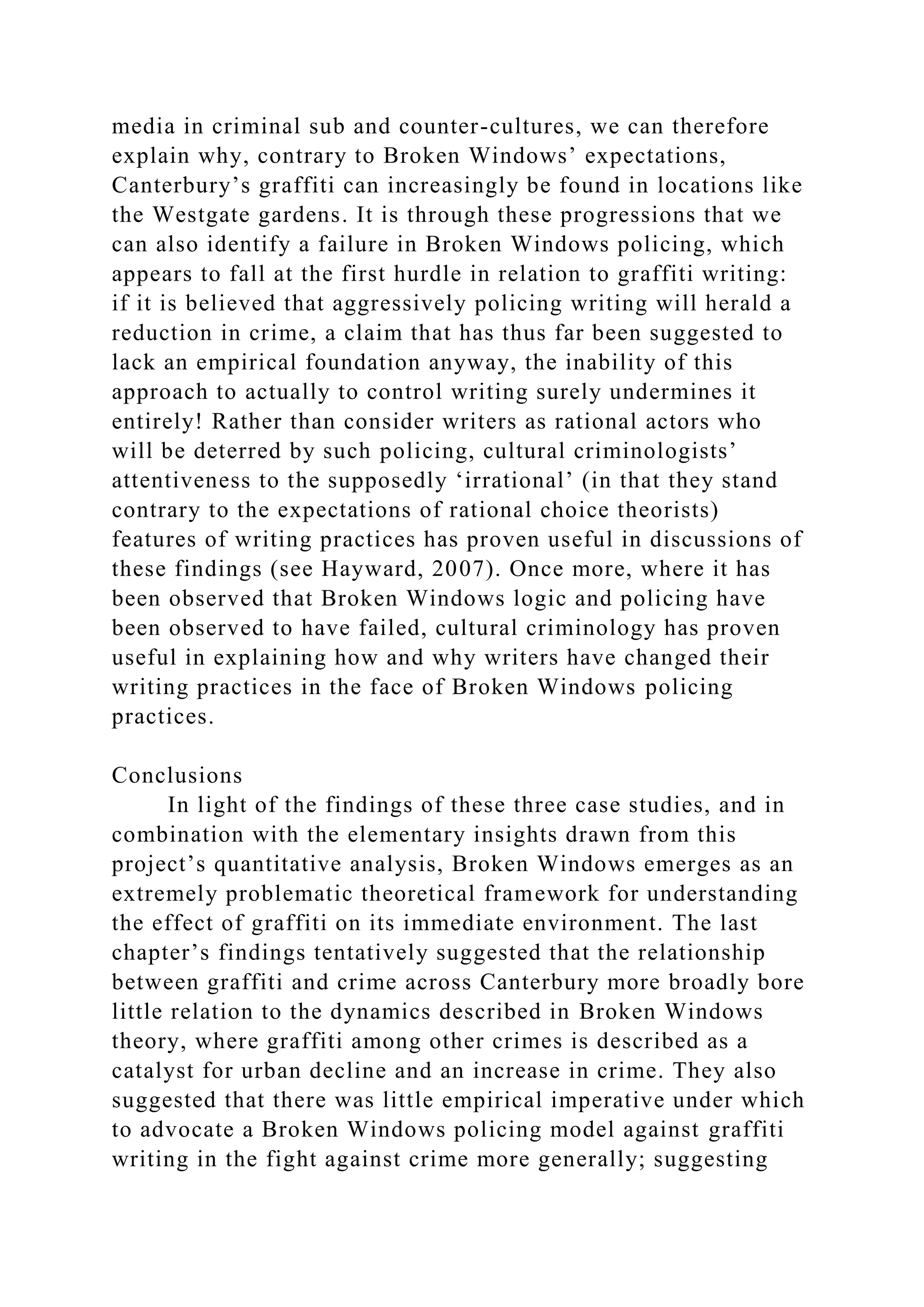

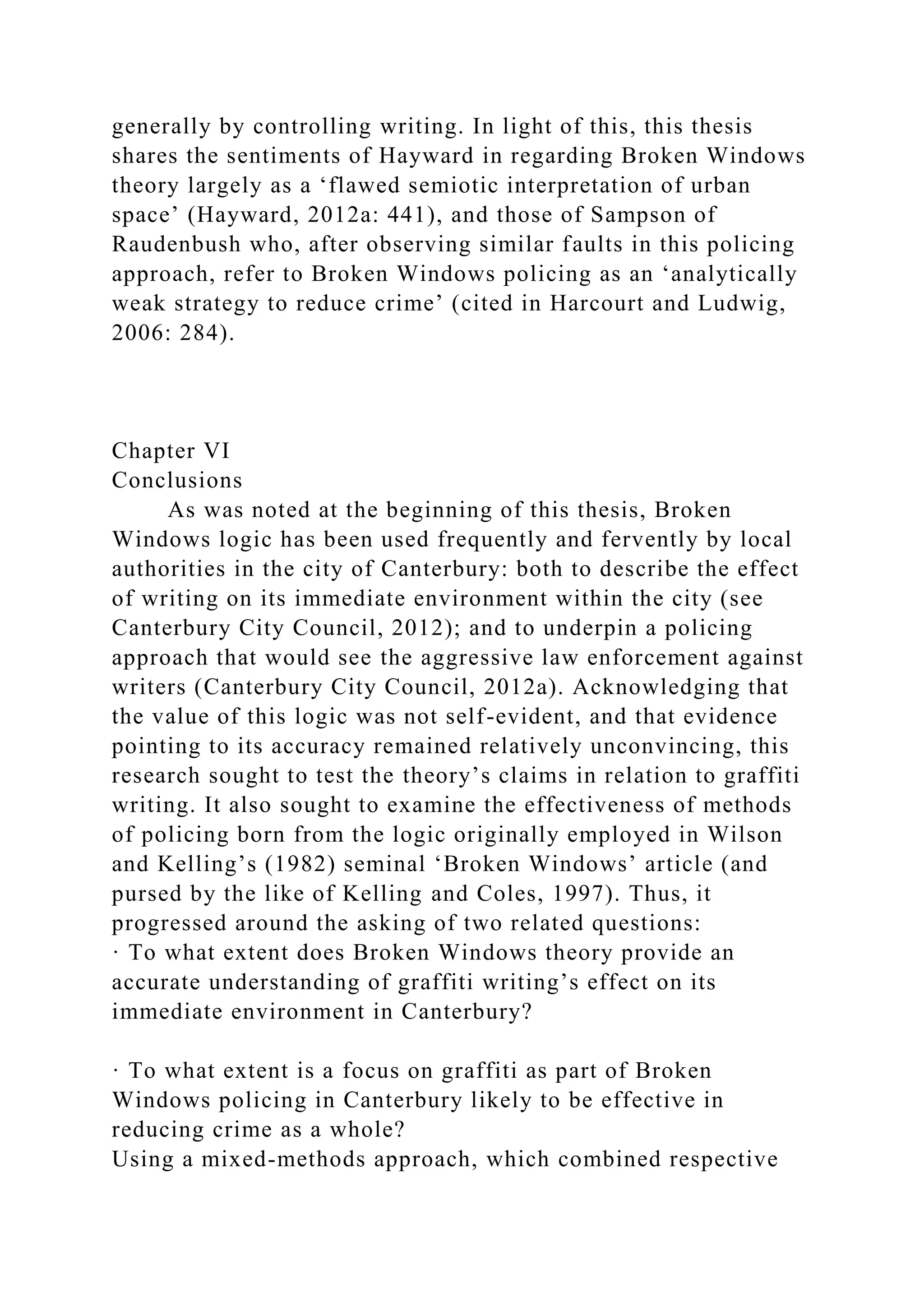
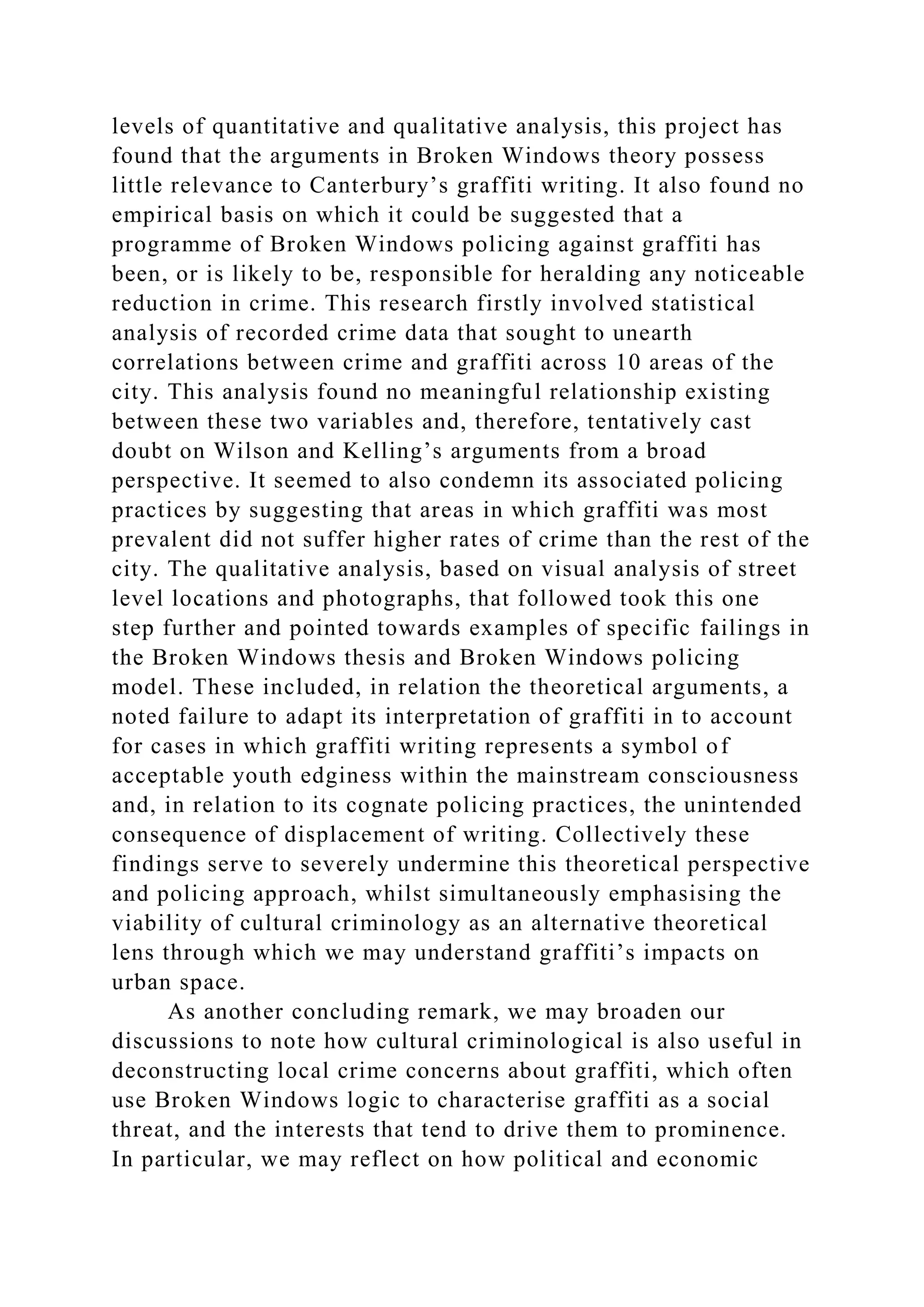
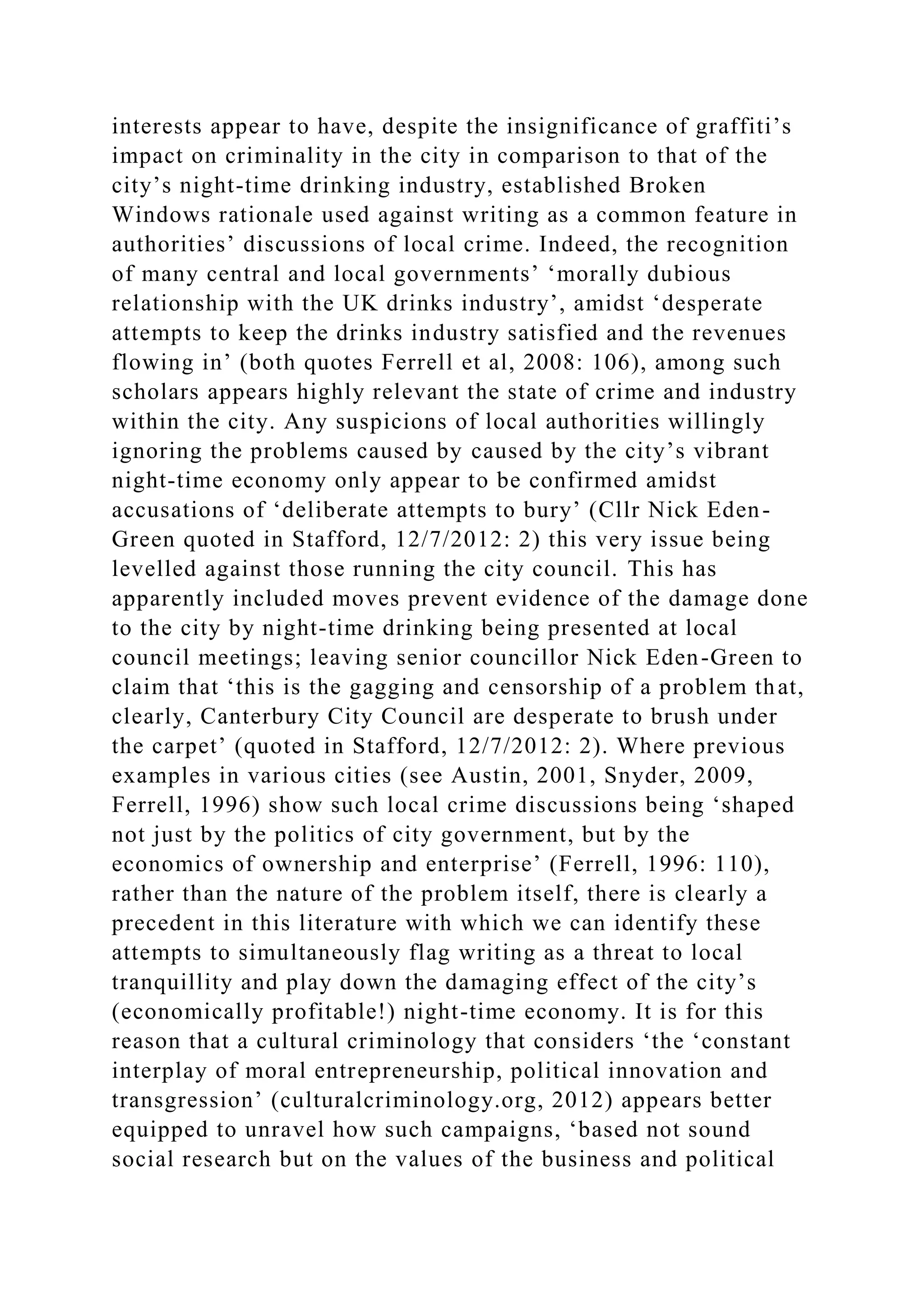
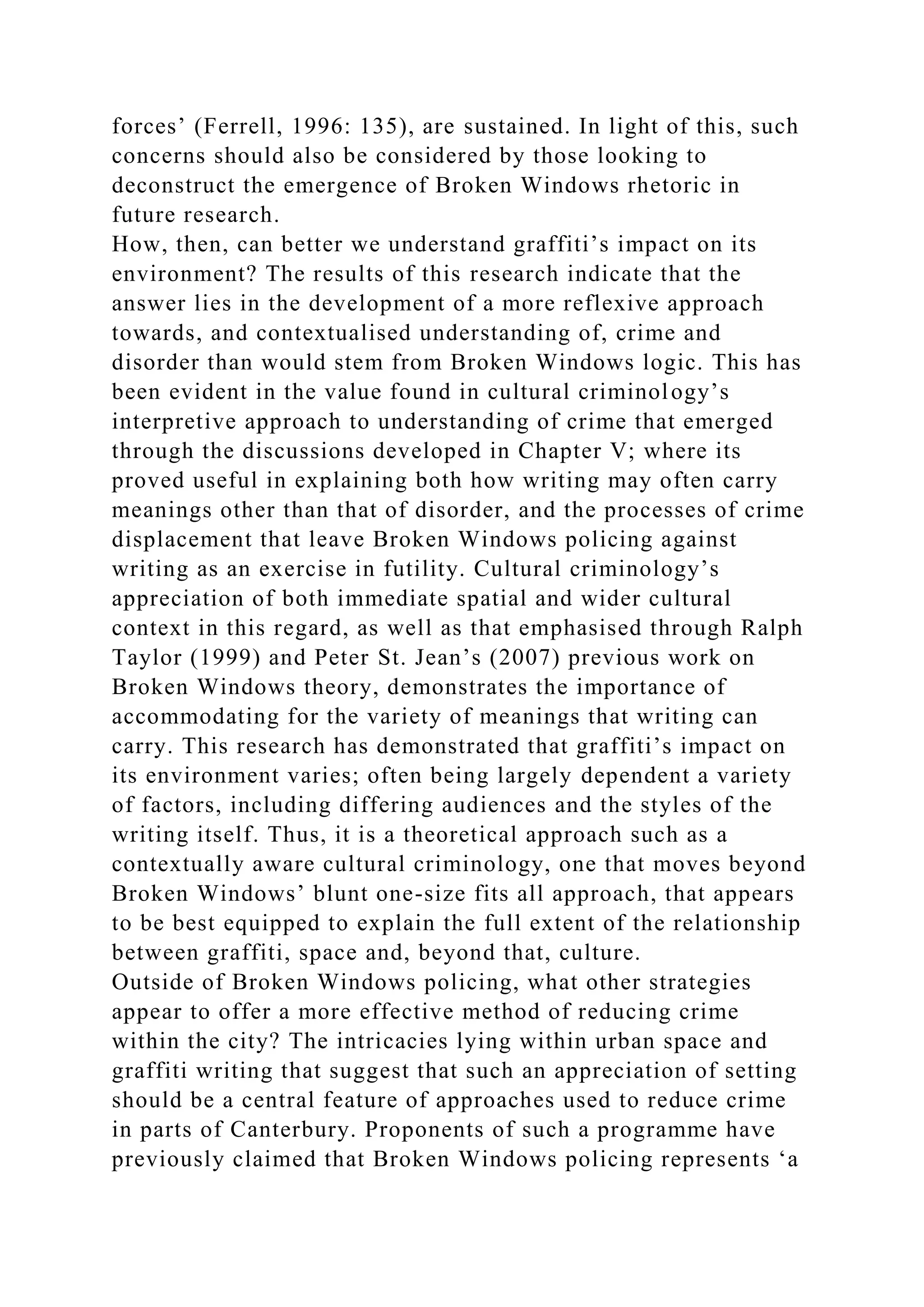
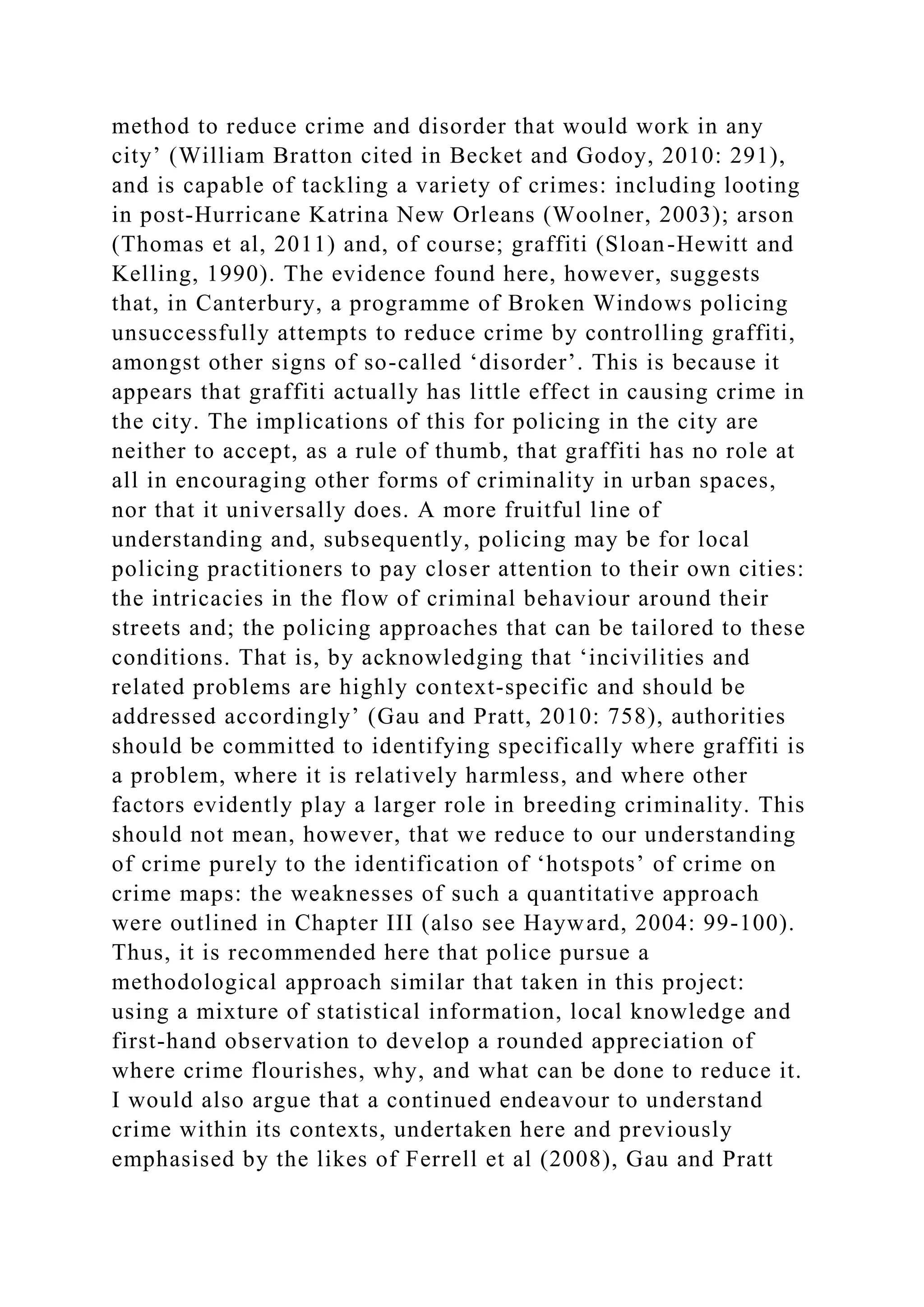
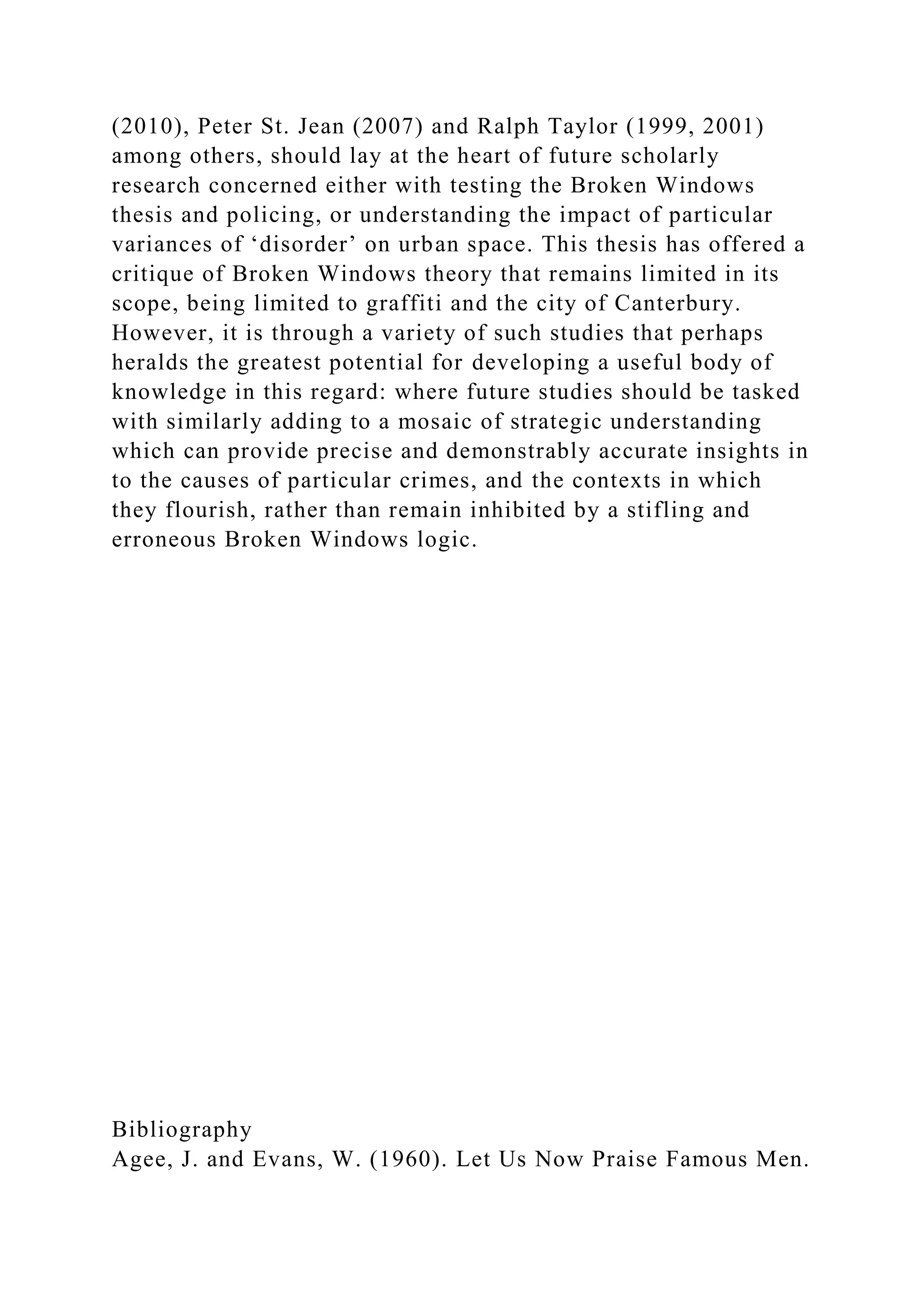

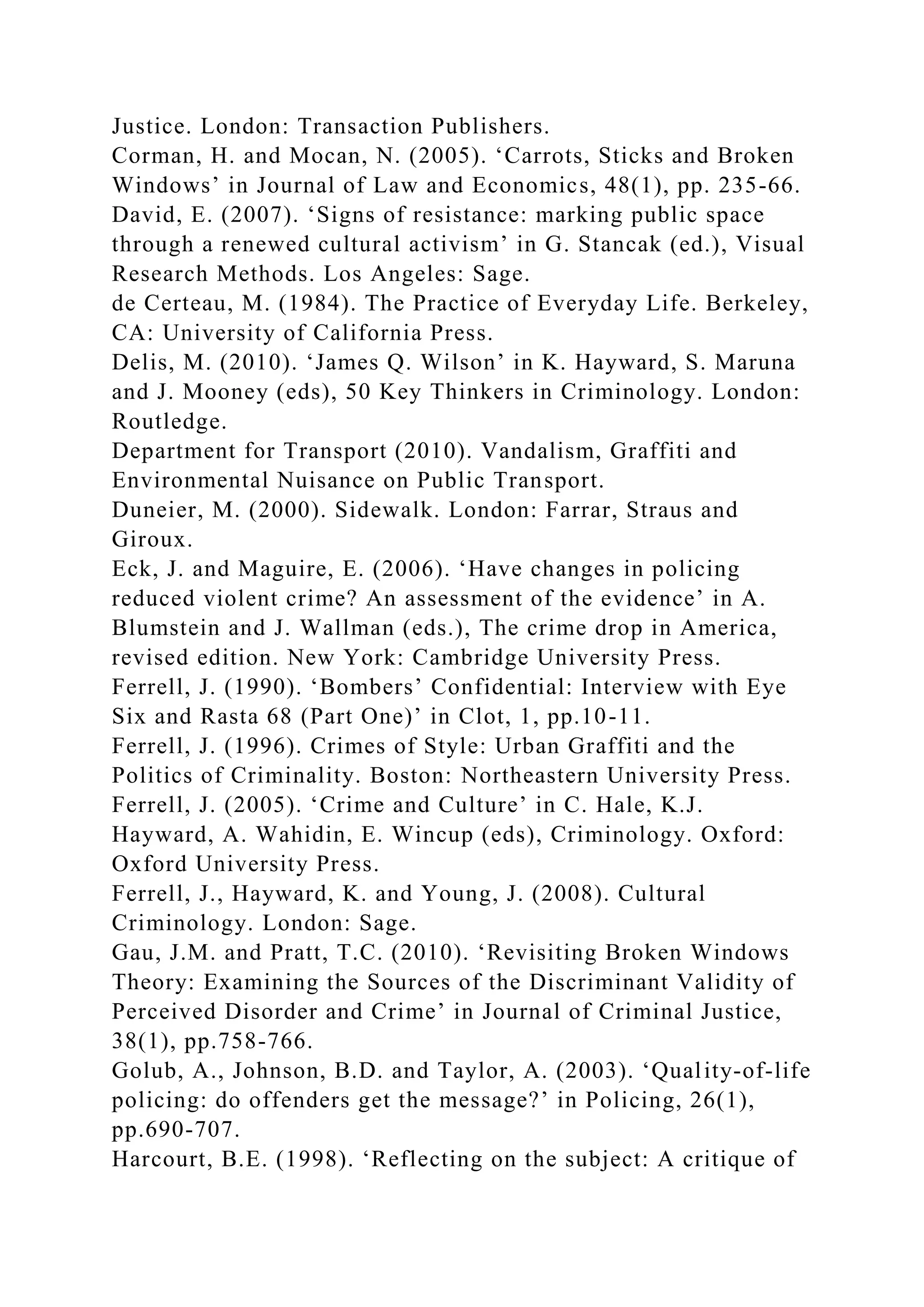
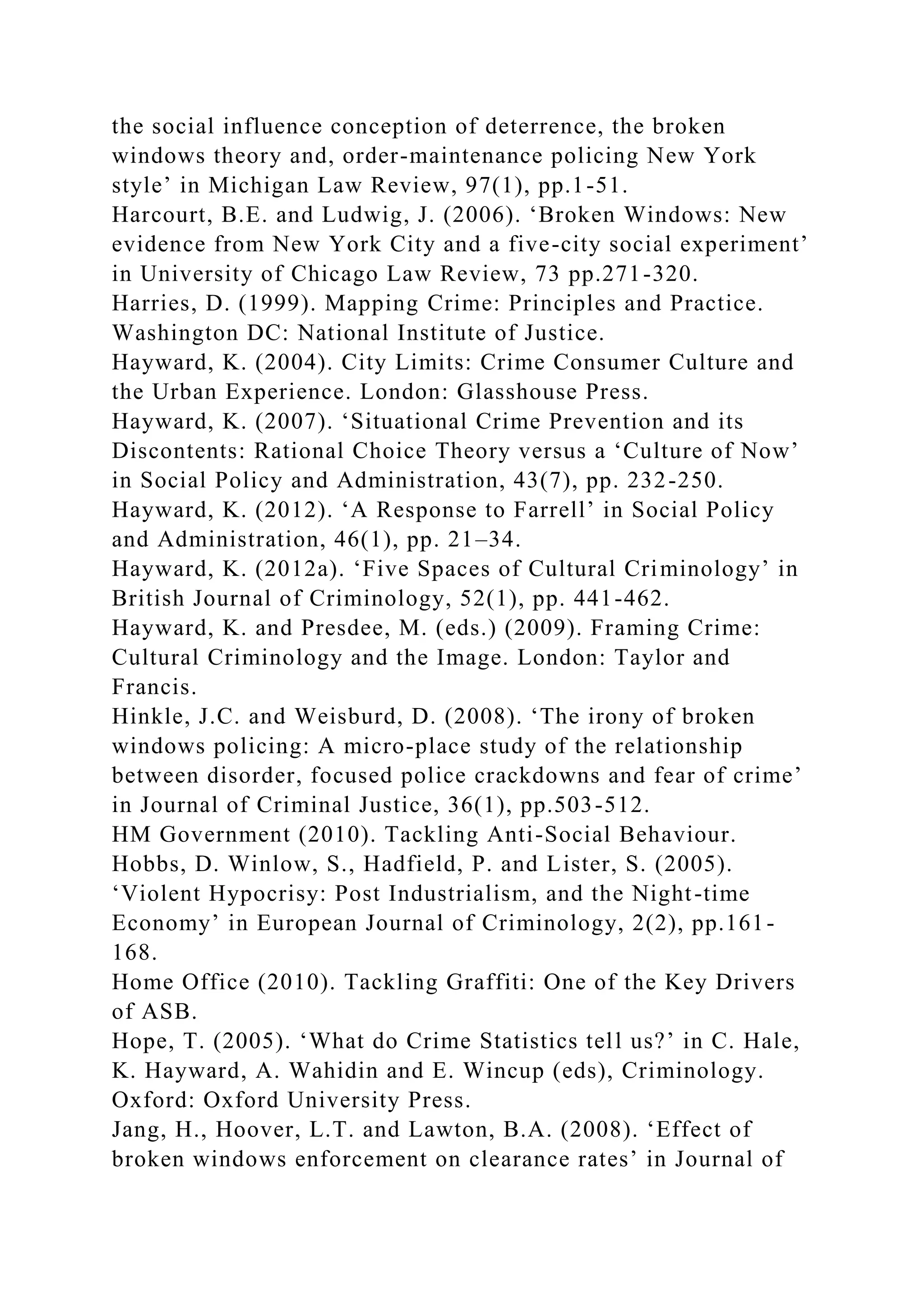
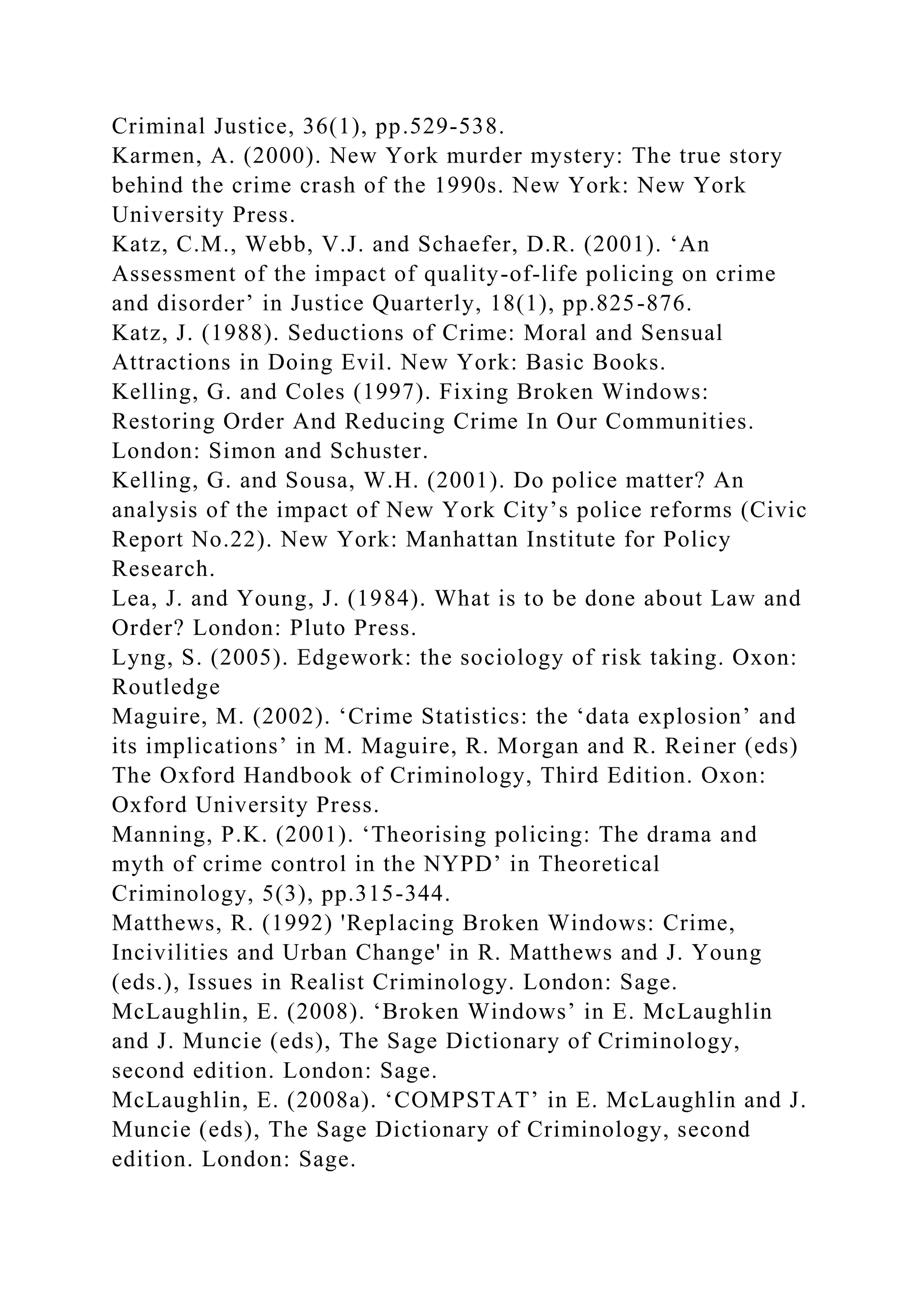

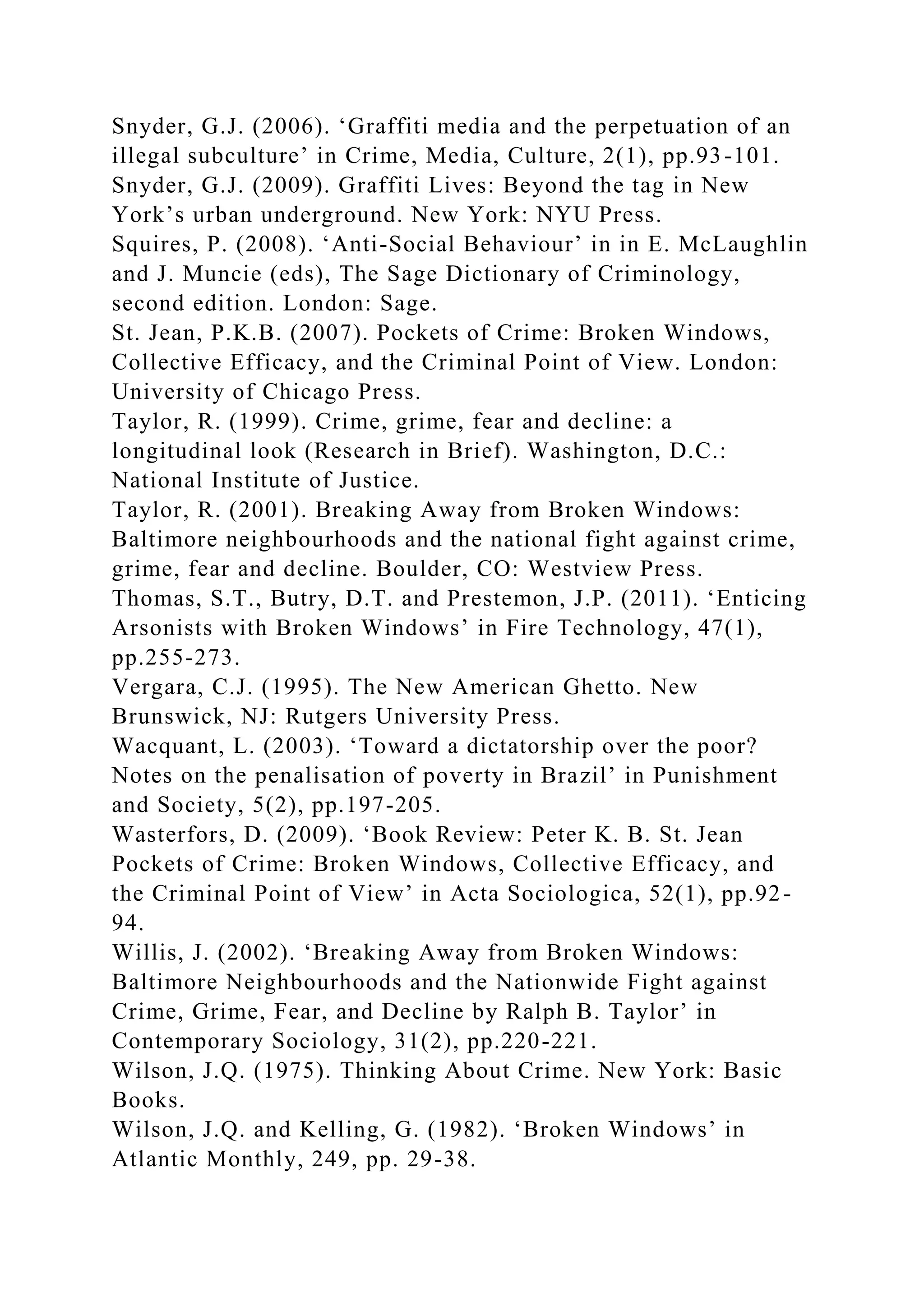
![Winlow, S. and Hall, S. (2006). Violent Night. Oxford: Berg.
Yang, S. (2007). Causal or merely co-existing: a longitudinal
study of disorder and violence at places. Unpublished doctoral
dissertation, University of Maryland, College Park.
Young, J. (2011). The Criminological Imagination. London:
Polity Press.
Zimring, F.E. (2007). The Great American Crime Decline. New
York: Oxford University Press.
Media Sources:
Claridge, A. and Alston, K. (18/3/2010). ‘Student caught
scrawling tag after night out in pub’ in The Kentish Gazette.
Napler, S. (19/5/2011). ‘Volunteers get stuck in to give path a
makeover’ in The Kentish Gazette.
Stafford, L. (12/7/2012). ‘Council Accused of ‘Burying’
Problem’ in The Canterbury Times.
The Kentish Gazette (25/3/2010). ‘Opinion’ in The Kentish
Gazette.
The Kentish Gazette (2/6/2011). ‘I’ll clean up the graffiti
myself’ in The Kentish Gazette.
Warren, G. (23/8/2012). ‘Traffic wardens take on powers to dish
out fines’ in The Kentish Gazette.
Online Sources:
Bunyan, N. (2/2/2011). Crime mapping: informative or just
scaremongering? [Internet Source] Available <
http://www.telegraph.co.uk/news/uknews/crime/8296381/Crime-
mapping-informative-or-just-scaremongering.html > Accessed
2/7/2012
Canterbury Bombs [Internet Source] Available <
http://www.graffiti.org/hc/canterbury/ > Accessed 22/6/2012
Canterbury City Council (2012). Street Cleaning, Graffiti and
Chewing Gum [Internet Source] Available <
http://www.canterbury.gov.uk/main.cfm?objectid=1612 >
Accessed 21/6/2012.
Canterbury City Council (2012a). Graffiti Leaflet [Internet Site]](https://image.slidesharecdn.com/brokenwindowstheoryacademictheoryproposedbyjamesq-221031130150-b85cb06e/75/Broken-windows-theory-academic-theory-proposed-by-James-Q-Wilson-docx-90-2048.jpg)
![Accessed <
http://www.canterbury.gov.uk/assets/streetscene/graffitileaflet.p
df > Accessed 12/6/2012.
Chapman-Jones, J. (2009). Canterbury City Graffiti [Video
Source] Available <
http://www.youtube.com/watch?v=PBVuxHhKpr4 > Accessed
26/7/2012
Culturalcriminology.org (2012).
Giuliani, R.W. (1998). The Next Phase of Quality of Life:
Creating a More Civil City [Internet Site] Available <
http://www.nyc.gov/html/rwg/html/98a/quality.html > Accessed
6/6/2012.
Police.uk (2012).
SoflesViolence (2010). Canterbury City Graffiti 2 [Video
Source] <
http://www.youtube.com/watch?v=cqjmU4SgSvQ&feature=relat
ed > Accessed 26/7/2012
Tandasatu (2/4/2010). Spliffs and Gynaecology [Video Source]
< http://www.youtube.com/watch?v=hswLPnE1GgY >
Accessed 26/7/2012
This is Kent (22/1/2009). Purge on Graffiti Needed [Internet
Source] Available < http://www.thisiskent.co.uk/Purge-graffiti-
needed/story-12019575-detail/story.html > Accessed
13/2/2012.
This is Kent (12/2/2010). Arrests over Canterbury graffiti
complaints [Internet Source] Available <
http://www.thisiskent.co.uk/Arrest-Canterbury-graffiti-
complaints/story-12011682-detail/story.html > Accessed
13/2/2012.
This is Kent (11/3/2011). Residents’ graffiti war continues
[Internet Source] Available <
http://www.thisiskent.co.uk/Residents-graffiti-war-
continues/story-11988786-detail/story.html > Accessed
13/2/2012.
This is Kent (8/4/2011). Police with battering rams in dawn
swoop on Whitstable graffiti suspects [Internet Source]](https://image.slidesharecdn.com/brokenwindowstheoryacademictheoryproposedbyjamesq-221031130150-b85cb06e/75/Broken-windows-theory-academic-theory-proposed-by-James-Q-Wilson-docx-91-2048.jpg)
![Available < http://www.thisiskent.co.uk/Police-battering-rams-
dawn-swoop-Whitstable-graffiti-suspects/story-12020375-
detail/story.html > Accessed 13/2/2012.
This is Kent (19/1/2012). Teenagers arrested as graffiti suspects
[Internet Source] Available<
http://www.thisiskent.co.uk/Teenagers-arrested-graffiti-
suspects/story-14973149-detail/story.html > Accessed
13/2/2012.
Whitehead, T. (1/2/2011). Crime maps: chaos surrounds launch
of police site [Internet Source] Available <
http://www.telegraph.co.uk/news/uknews/law-and-
order/8296494/Crime-maps-chaos-surrounds-launch-of-police-
site.html > Accessed 27/6/2012.
Woolner, A. (2005). Snipers Emerge from New Orleans’
‘Broken Windows’ [Internet Site] Available <
http://www.bloomberg.com/apps/news?pid=newsarchive&refer=
columnist_woolner&sid=aFDbFJcEZhHY >Accessed 27/6/2012.
7](https://image.slidesharecdn.com/brokenwindowstheoryacademictheoryproposedbyjamesq-221031130150-b85cb06e/75/Broken-windows-theory-academic-theory-proposed-by-James-Q-Wilson-docx-92-2048.jpg)